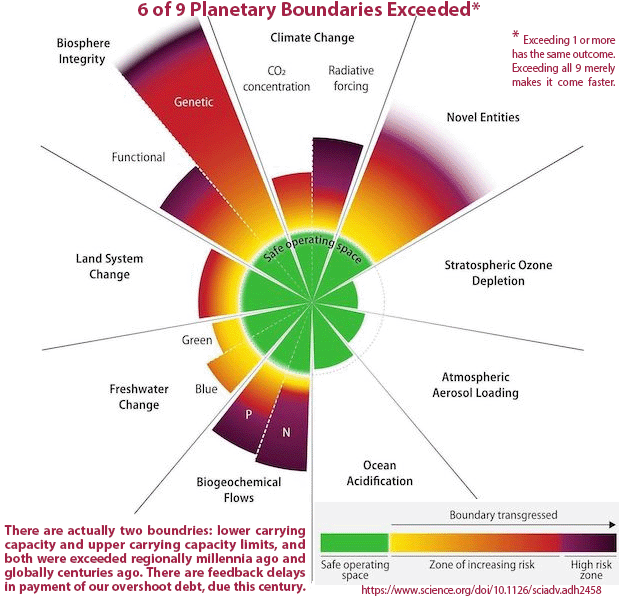
SATURDAY, JUNE 4, 2016: NOTE TO FILE

Past (to present) Lives of Humans
Overview of humans over time
Eric Lee, A-SOCIATED PRESS
TOPICS: HISTORY, FROM THE WIRES, PREHISTORY
Abstract: An overview of the past ten million years of hominin happenings with a focus on the last ten thousand years of empire-building (complex societies exhibiting an expansion dynamic). Thousands of chiefdom level empires (expansionist complex societies exceeding Dunbar's number) have likely come and gone as unsustainable complex societies (aka civilizations), but were unnamed and may be unknown to history or archaeology and so will go unnoted. State level complex societies are the tip of a much larger iceberg of technology and typically agro-empowered empire-building dynamic more complex than we understand.
TUCSON (A-P) — And then there was:
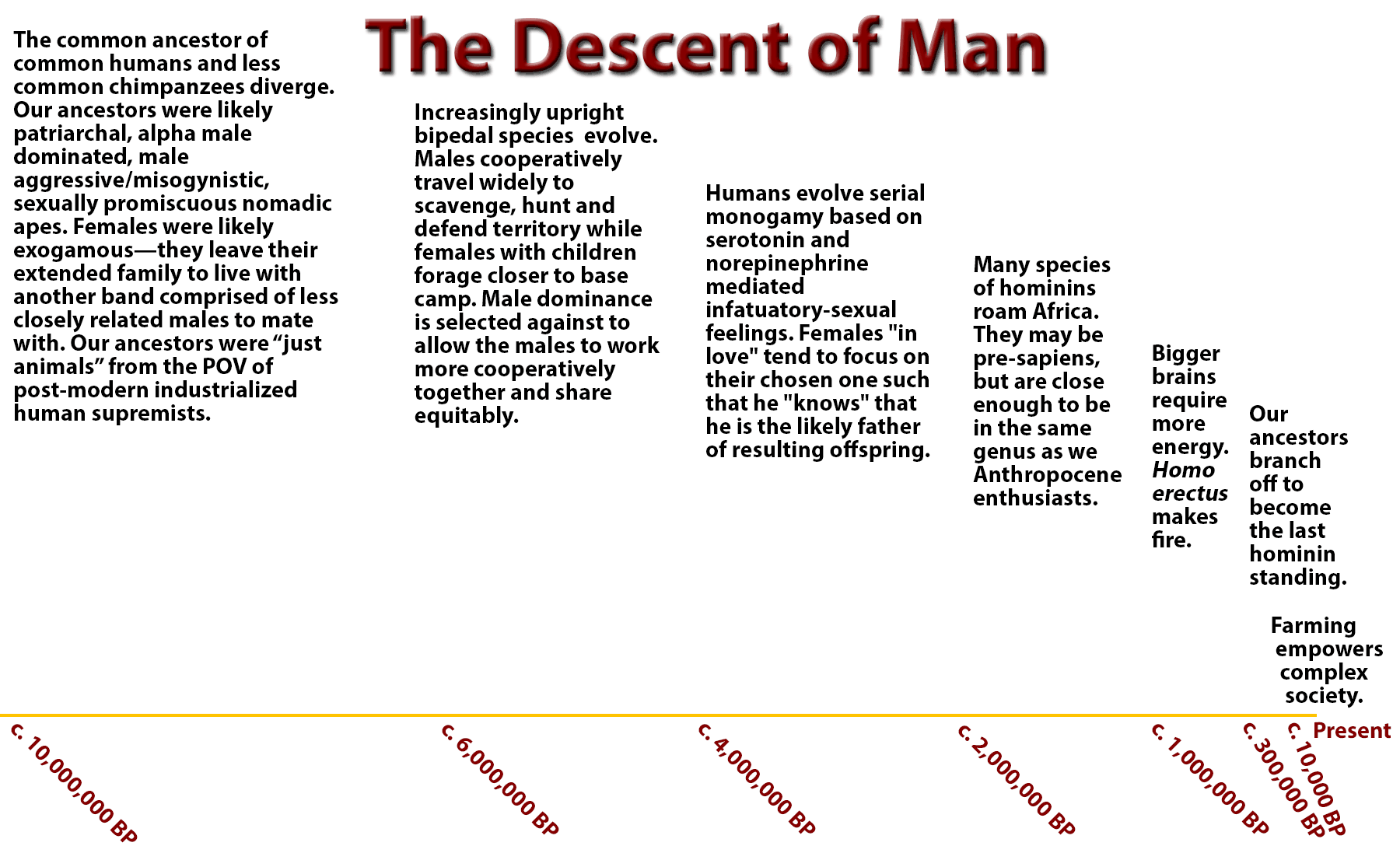
[omitted are the last 300 years, or 0.03 pixels, of industrial/urban sprawl and behavioral sink]
10,000,000 BP to 6,000,000 BP: The forest dwelling common ancestor of humans and common chimpanzees may have had more in common with chimps than the bipeds that became adapted to the open savanna.
6,000,000 BP: Hominins speciate into multiple forms. Male dominance was selected against to allow the males, who sometimes bring home the bacon, to work more cooperatively together and share equitably.
4,000,000 BP: Human ancestors evolve serial monogamy based on infatuatory-sexual feelings that enable females "in love" to focus on their chosen one such that he "knows" that he is the likely father of resulting offspring and that preferential food (especially meat) gifts he bestows upon his true love, before birth and while nursing his likely child, are appropriate—have an evolutionary payoff. When the child is weaned after a few years, it is largely independent, without need of parental care. When the mother is fertile again, she may choose a different mate. Romance-based serial pair-bonds are programmed to end within a few years (2-4 years per Helen Fisher).
Compare the 2.5–3 million year presence of humans (genus Homo) on Earth to a 75 year human lifespan: a span that we can grasp intuitively. On this scale, we get the following analogous periods:
- First 65 - 70 years: various species of humans evolve and coexist (sustainably) on the planet;
- Last 5 -10 years: the age of Homo sapiens sapiens (about 200k-400k yrs; mostly sustainably);
- Last 15 months: the age of expansion as Man the Hunter, an invasive species;
- Last 4 months: the age of civilization (expansionist agriculture; then cities and empires) (11,000 yr);
- Last 4 days: the age of science (400 yr);
- Last 36 hours: the age of fossil fuels (150 yr of increasingly significant use and rapid expansion);
- Last 12 hours: the age of rapid global ecological devastation (50 yr).
- Next 12 hours post-climax...?
2,000,000 BP: Hominins roaming Africa may be pre-sapiens, but are close enough to be considered human. [If the past 2 million years of humanity's walk on this planet are compared to the life of a 50-year-old individual living today, almost their entire life would have been lived profoundly different than recent times. They lived nomadic lives in groups of maybe 20 to 50 others they trusted with their lives. The last 10,000 years, the coming of agriculture, cities, and empire-building, would have been in the last four months of their lives. The Industrial Revolution, starting with steam engines happened in the last day and a half and leading up to the last few hours of our so called lives of Facebook enabled cell phones that can take selfies. Few industrial society humans trust anyone with their lives and fortunes, even family, nor can they concern themselves with things more than five years in the future (or one hour), rendering them centered on Self and posterity blind "rats of NIMH".]
1,000,000 BP: Bigger brains require more time to program—there is more to learn and infants are born increasingly more immature to allow the head to pass through the birth canal. Childhood is extended beyond weaning. A woman may have more than one dependent offspring at a time and male support is valued as it may make the difference. Having multiple fathers of multiple dependent offspring doesn't work well. Pair bonding evolves to last more than two to four years based on oxytocin and vasopressin mediated feelings of commitment to allow for long-term monogamy, but the infatuatory-sexual propensity remains as does the promiscuous pattern that preceded the romantic infatuatory-sexual adaptation favoring serial monogamy. Old patterns are not erased before being overlaid with more adaptive patterns, leaving the atavistic patterns to remain or even be selected for among denizens of the human zoos that industrial society's urban growth selects for.
300,000 BP: Human lifespan becomes extended to allow for grandparents to help with child rearing, freeing the younger mothers to roam farther in gathering foods without children in tow. They can gather more food allowing them to feed their parents and extended family too. Grandfathers teach their grandsons to hunt small game and make tools. Women supply most of the food. Men bring home the bacon (sometimes). The social order is matriarchal, matrilineal, and matrilocal. Mythology emphasizes the Great Mother metaphor as in Gaia, Mother Nature, and Mother Earth. Males are exogamous, going to live with their wife's band—a small nomadic group of typically 20-60 people including grandparents and children. The bands of related women are on semi-friendly terms most of the time except during periods of scarcity. Human evolution selects for egalitarian tendencies that favor the gifting economy. Patriarchal alpha male inclinations among men remain but are moderated by cultural egalitarian norms that women favor.
60,000 to 50,000 BP: A single group of humans crossed the Red Sea to disperse globally, becoming the ancestors of all non Africans other than such Neanderthals, Denisovans, and as yet unidentified humans as they interbred with and displaced. Homo sapiens left Africa over 100,000 years ago and were living out of Africa when the single group we descended from came and 'displaced' them, interbreeding with some, but we non Africans descend only from those who made them go away however you may imagine that happening. One group rapidly crossed southern Asia to New Guinea and Australia. Others traveled north to Eurasia via the Middle East about 45,000 BP, spreading throughout Western Europe as hunter-gathers (WEH) about 43,000 BP. This expansion event was the first, followed by a second global expansion of Indo-Europeans and their language and culture 7,000 BP. Non Africans are the result.
Technology empowered animals, prior to evolving self-limiting controls if significant harm is possible, face extinction. Significant empowerment of an animal by technology began with fire making hominins who may have started out putting everything that would burn to the torch because doing so, burning forests and grasslands (at both ends) gives a lovely light!
Hominins, as K-strategists, must persist or go extinct, and using fire maximally for short-term self-interest (e.g. for pleasure or to kill game for one feast) would be selected against. Nomad foragers using fire to diversify a biome and prevent large-scale conflagrations by naturally occurring fires, would be adaptive (maximize empower of the system) and was selected for until modern times when insapient fire starting (arson) became common. Note: our ancestors limited their use of the awesome powers of fire, implying we have the potential to self-limit too.
Within Africa, hominin development of stone weapons was slow enough that prey species were able to adapt, so this technology did not lead to megafauna extinctions until humans went out of Africa and developed advanced technology (e.g. atlatl and Clovis point force-multiplier technology). This was humanity's first failure to limit their use of technology to avoid long term harm to themselves and the local ecosystem. Outside of Africa, fauna initially failed to recognize humans as a threat and were killed too easily. Assume 99% of nomadic bands recognized the potential of overhunting naïve prey to extinction, and limited their taking of any species to avoid any noticeable decrease in their population below optimum (e.g. under grazing) as the decades passed.
Oh, but initially 1% of bands view the animals as a resource for the taking, take, prosper, and easily support large families. And their offspring do likewise only more efficiently and with greater enthusiasm. Soon, all who are expanding out of Africa are enthusiastic expansionists whose culture celebrates taking. As one area is depopulated of fauna, no problem, they move on. This short term expansionism was selected for, for a time. We are their descendants. The pattern worked for millennia, and selected for humans who prospered greatly as an invasive species responding to short-term contingencies of reinforcement (short-term self interest). Eventually an invasive species, however, after overrunning a habitat (e.g. planet Earth) must re-adapt to a steady-state biophysical economy or face local to planetary extinction.
Into a world of nomadic foragers, some came to plant and select for desired traits to domesticate plants (e.g. bottle gourds and food plants), and others domesticated animals as commentalists which allowed the nomadic to settle in one camp and amass possessions far beyond what they could carry. Initially settlements of bands remained band-sized in population, 20 to 50 (range 5-85) trusted others, which was viable, but typically within a few millennia selected for larger populations which selected for hierarchy and the emergence of elites and commoners, the emergence of overcomplex society that selects for growth and expansion (empire building from chiefdom to nation-state), e.g. the global modern techno-industrial form of civilization we are products of, live in, and serve.
About seven thousand years ago a patriarchal culture, dominated by hunters (as on the steppes of Asia there were few plants to gather) acquired domesticated cattle and later horses, developed metallurgy and solid-wheel cattle-drawn cart technology the bovines could pull when not pulling plows (horses were hunted for meat and within two thousand years domestic horses were acquired, milked, ridden into battle and used to pull spoke-wheeled war chariots to aid expansion). The technology of the Proto-Indo-Europeans enabled them to both amass material goods and move them to become nomadic expansionists, expanding into a world of settled agrarians living in band-sized groups (typically not patriarchal) and remaining hunter-gatherers (also not patriarchal except where hunting was the basis of the biophysical economy). The Indo-European expansionists were initially stopped only by earlier high-intensity agriculture-based empire builders (e.g. Mesopotamian, Egyptians, Semites), though their more aggressive culture made steady inroads into these prior cultures even if not enough to replace their language (e.g. the Semitic religion was derived from Zoroastrianism, an Indo-European hierarchical priesthood dominated belief-based religion).
Will modern humans understand their predicament, renomalize... or die?
As the glaciers retreated 19,000 to 14,000 years ago, a new wave of migrants spread into Europe, and about 9,000 years ago, farmers from northwestern Anatolia moved in to spread, interbreed with and displace the hunter-gatherers. The third major migration began about 5,000 years ago when Indo-European herders swept in from the steppe north of the Black Sea in what is now Russia. Those Yamnaya pastoralists herded cattle and sheep, and some rode newly domesticated horses. Unlike the hunter-gatherers and agrarians, they were patriarchal and celebrated conquest which their livestock (especially horses) enabled. Little or no male hunter-gatherer/agrarian DNA survived, achieved by killing all males and breeding the women who persisted among the agrarians though their language and culture was largely replaced by the Indo-European invaders. Joseph Campbell found evidence of a goddess culture in the fragments of pre-Indo-European mythology. Descendants of the original populations served their overlords as a peasant, serf, commoner, or slave class (prey-like population to elite predator-like population). Prior to this, the Indo-European culture was not the norm as it is today worldwide.
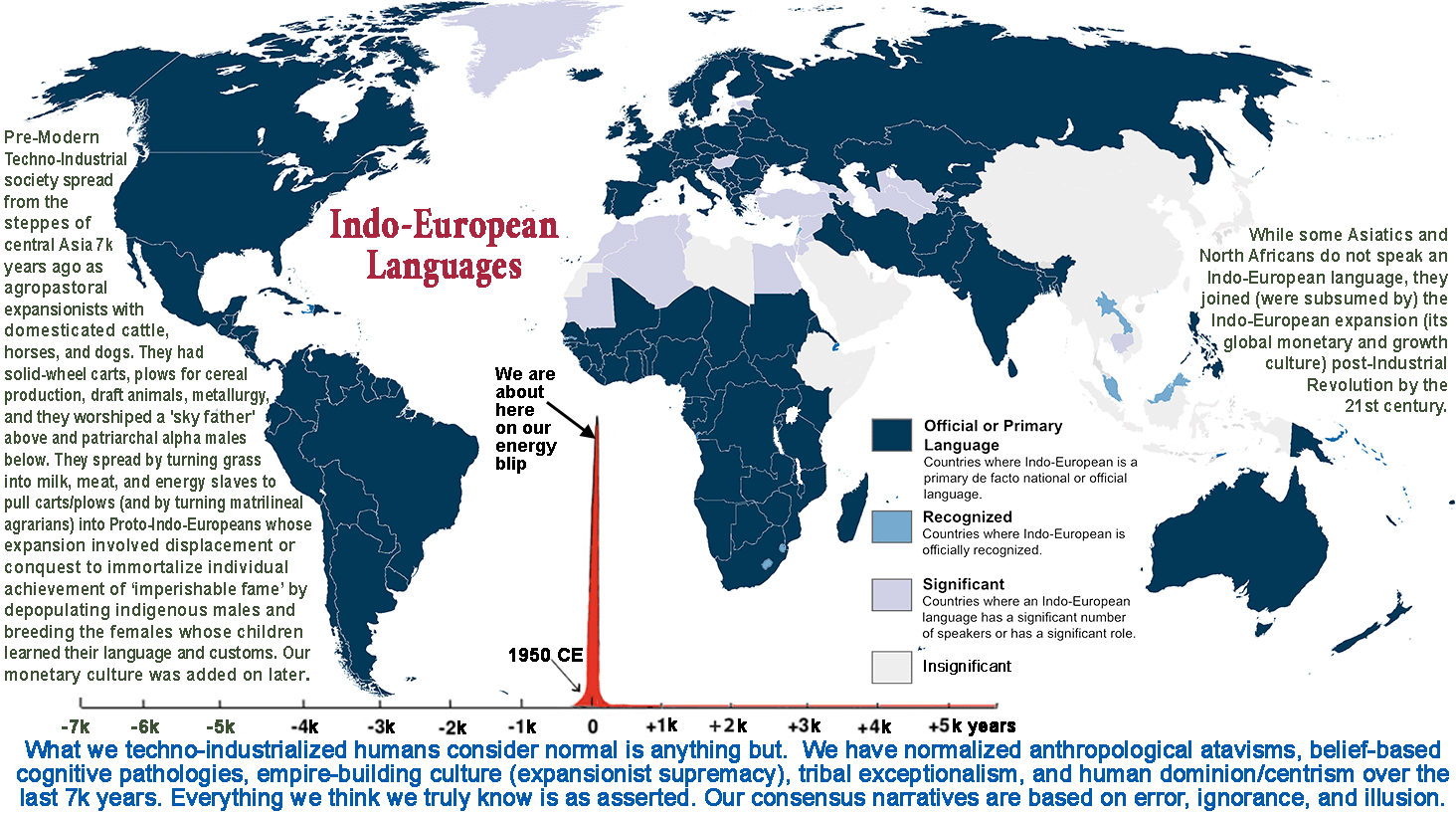
Descent into Empire-building
 10,000 BCE (11,950 BP, BP=Before Present=before 1950=BA, Before Acceleration, 1950 CE = start of the Great Acceleration and so 2016 = 66 AA or 66 years After Acceleration kicked in): Agriculture begins to transform human life in the Neolithic. Hunter-gatherer cultures tend to be matriarchal, as are Early and many Middle non-empire-building Neolithic societies whose mythologies (narratives) are Great Mother/goddess based as Joseph Campbell noted. The social systems tend towards the egalitarian and the economic system is based on sharing.
10,000 BCE (11,950 BP, BP=Before Present=before 1950=BA, Before Acceleration, 1950 CE = start of the Great Acceleration and so 2016 = 66 AA or 66 years After Acceleration kicked in): Agriculture begins to transform human life in the Neolithic. Hunter-gatherer cultures tend to be matriarchal, as are Early and many Middle non-empire-building Neolithic societies whose mythologies (narratives) are Great Mother/goddess based as Joseph Campbell noted. The social systems tend towards the egalitarian and the economic system is based on sharing.
Early settlements in the Fertile Crescent were by foragers within high productivity wetlands having a high diversity of resources that were not subject to long-term storage. Settlements remained relatively small and egalitarian. For empire-building, later grain production was selected for as it could be taxed, stored, and stolen. Payment in grain served to create the early monetary culture we are all products of. "Civilization" could be viewed as a pathology enabled by grain production, but we products of civilization do not like that story. We remain for, and not "Against the Grain".
From small agricultural village beginnings, it took about four thousand years to transition to ever larger-scale chiefdoms and empire-building that was being selected for, which lead to city-states and then state-level complex societies or "true empires" such as we descendants of empire-builders might admire. A state-level complex society that does not engage in empire-building is possible, has been done (e.g. Tairona, Muisca), but without a means to make the world safe from empire-builders like us, then empire-building is selected for. Alternative is the proposed United Federation of Watersheds as without limits to conquest of Nature and other humans, manageable sized complex societies and their watershed-based life-support system appear to not persist for long (>1,000 years).
23,000 BA: Early Agriculture and the transition from hunting-gathering life may have begun 13,000 years earlier than its use became widespread enough to be noticeable in the archaeological record about 12,000 BA, which transformed human societies as hunter-gatherers could not compete with the high populations that agriculture supported.

Notes:
- 69,784 total empire years, 134 named empires = 520 years average lifespan.
- Human ecology, when empowered by agriculture or by fossil fuels/industrial agriculture in an unmanaged commons, appears to follow a pulsing paradigm independent of changes in climate or variation in environmental resources or services. The repeating over-pulsing paradigm pattern is one of unmanaged growth exceeding sustainable limits unto overshoot followed by forced descent. A sustainable system, a managed commons—one managed to maintain a viable equilibrium between Man’s demands and Nature’s resources, would oscillate with environmental variations, but could avoid the boom and bust pattern.
- Unsustainable system pulsing maximizes empower in the short term (as does cancerous growth), hence the empire-building pulses appear dramatic and often are. A managed system, such as a complex society that self-imposes limits, maximizes empower over a long-term period and so will be selected for if humans learn to understand and live with the planet properly as determined by Nature's laws.
- 1st millennium BA, 950 CE to 1950 CE, Holy Roman Empire to Soviet Empire, 31 complex societies, 6,967/31= 225 years average lifespan.
- 2nd millennium BA, 50 BCE to 950 CE, Imperial Roman Empire to Tuʻi Tonga Empire, 43 complex societies, 17,364/43= 404 years average lifespan.
- 3rd millennium BA, 1050 BCE to 50 BCE, Kingdom of Israel and Judah to Three Kingdoms of Korea, 41 complex societies, 20,969/41= 511 years average lifespan.
- 4th millennium BA, 2050 BCE to 1050 BCE, Middle Kingdom of Egypt to Zhou Empire, 13 complex societies, 7,957/13= 612 years average lifespan.
- 5th millennium BA, 3050 BCE to 2050 BCE, Stonehenge to Xia Dynasty, 9 complex societies, 9,077/9= 1,009 years average lifespan.
- 6th millennium BA, 4050 BCE to 3050 BCE, Uruk to Indus Valley Civilization, 4 complex societies, 6,800/4= 1,700 years average lifespan.
- The Tairona lifespan shows the 200 year phase 1 pulse, 400 year phase 2 pulse, and the phase 3 steady-state economy that pulsed within boundaries to avoided overshoot while managing “sustainable development” as environmental resources (e.g. soil, forests) recovered following the degradation of prior unmanaged pulsing, until 1650 CE when the Spanish genocide and assimilation eliminated all but the Kogi. The nearby and later Muisca were also non-empire-builders whose managed steady-state society was conquered by the Spanish, but no remnant population survived.
 The typical curve is a Seneca curve, a pulsing dynamic that better represents the rise and fall of empires than a line, as there are limits to the rate of growth but the rate of descent can be, often is, "rapid." "Increases are of sluggish growth, but the way to ruin is rapid." Letters to Lucilius #91, Lucius Annaeus Seneca, 64 CE. One definition of "civilization" is "a complex society large enough to leave ruins."
The typical curve is a Seneca curve, a pulsing dynamic that better represents the rise and fall of empires than a line, as there are limits to the rate of growth but the rate of descent can be, often is, "rapid." "Increases are of sluggish growth, but the way to ruin is rapid." Letters to Lucilius #91, Lucius Annaeus Seneca, 64 CE. One definition of "civilization" is "a complex society large enough to leave ruins." A modified Seneca curve is common as in descent an empire/kingdom/dynasty/state is increasingly subject to conquest by neighboring upstart empire-builders. The Indus Valley Civilization had no near-enough empires to allow conquest, so as it weakened, descent was forced by failure of environmental and human (commoner) services, which takes longer than conquest, but the outcome is similar. Rome wasn't conquered by barbarians at the height of its power, but as Orwell noted, the "fall" part (that may involve conquest or revolution) is usually the "kicking in of a rotten door." Conquest and revolution may be incidental. The American Revolution was to see who would take a continent, while more often revolt and civil war is merely to see who will (for a time) inherit the rubble.
A modified Seneca curve is common as in descent an empire/kingdom/dynasty/state is increasingly subject to conquest by neighboring upstart empire-builders. The Indus Valley Civilization had no near-enough empires to allow conquest, so as it weakened, descent was forced by failure of environmental and human (commoner) services, which takes longer than conquest, but the outcome is similar. Rome wasn't conquered by barbarians at the height of its power, but as Orwell noted, the "fall" part (that may involve conquest or revolution) is usually the "kicking in of a rotten door." Conquest and revolution may be incidental. The American Revolution was to see who would take a continent, while more often revolt and civil war is merely to see who will (for a time) inherit the rubble.- Alternative to collapse/conquest/revolt is being subsumed into an emerging dynamic, an if-you-can't-beat'm-join'm option. The Portuguese, Spanish, British, Russian, American, French, Japanese, and Soviet empires/economies were subsumed into the emerging global Euro-Sino Empire of commerce that won over nation-state political control SYSTEMs, especially following WWII, because that was what was selected for along with the spread of democracy (e.g. The Democratic People's Republic of Korea). The Sino/SE Asian region had been a land for the taking by Portuguese, Spanish, British, Russian, American, French and Japanese empire-builders, but China has ended up, by embracing (as Japan had before it) the Euro Empire of commerce. China now consumes half of the planet's coal burned per year, along with many other resources, to manufacture products for the world's consumers (for a time), hence the Euro-Sino. After the Sino region climaxes, there is nowhere else to go but up, as there is a solar system for the taking, so to continue growing we'll have to build a Dyson Sphere before spreading to other solar systems to turn the galaxy into an infrared emitter. Or maybe we won't.
- Another view of longivity over time; from The vulnerability of aging states: A survival analysis across premodern societies.
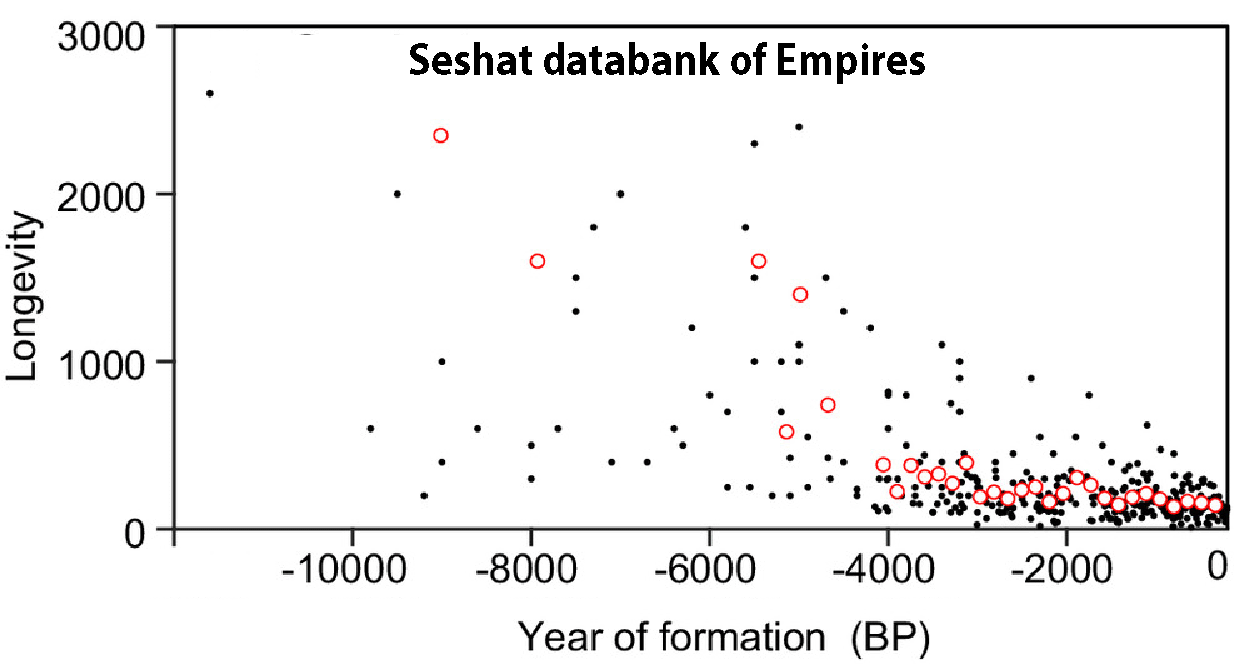
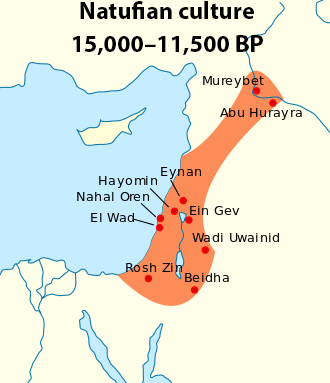 13050–9550 BCE (15,000–11,500 BA, a 3,500 year period): Natufian culture was a Late Epipaleolithic archaeological culture of a hunter-gatherer form of civilization in the Levant that was displaced by agrarian pastoral cultures, a different form of civilization. They were preceded by the Kebaran culture (18,000 to 10,500 BCE) who used the bow and arrow, and had dogs, who were preceded by the Levantine Aurignacian culture (35,000-29,000 BA) who were preceded by the Emiran culture who were preceded by the Ahmarian culture (46,000–42,000 BA) who were preceded by the Boker Tachtit culture (50,000 BA) who as 'Man the Hunter' expansionists had come out of Africa to replace the Neanderthals (60,000 BA) in the area who had replaced the first Homo sapiens sapiens in the area (90,000 BA) who had replaced the Mousterians (160,000 to 40,000 BA) who evolved from Homo sapiens (heidelbergensis) from whose African branch H. sapiens sapiens evolved about 350,000 to 400,000 BA. H. s. heidelbergensis occupied the Levant 700,000 years ago after evolving from Homo erectus ergaster in Africa about 1.3 million years ago. H. s. heidelbergensis, on leaving Africa, displaced H. erectus, the first hominin in the Levant, who had come to the Levant about 2 million years ago.
13050–9550 BCE (15,000–11,500 BA, a 3,500 year period): Natufian culture was a Late Epipaleolithic archaeological culture of a hunter-gatherer form of civilization in the Levant that was displaced by agrarian pastoral cultures, a different form of civilization. They were preceded by the Kebaran culture (18,000 to 10,500 BCE) who used the bow and arrow, and had dogs, who were preceded by the Levantine Aurignacian culture (35,000-29,000 BA) who were preceded by the Emiran culture who were preceded by the Ahmarian culture (46,000–42,000 BA) who were preceded by the Boker Tachtit culture (50,000 BA) who as 'Man the Hunter' expansionists had come out of Africa to replace the Neanderthals (60,000 BA) in the area who had replaced the first Homo sapiens sapiens in the area (90,000 BA) who had replaced the Mousterians (160,000 to 40,000 BA) who evolved from Homo sapiens (heidelbergensis) from whose African branch H. sapiens sapiens evolved about 350,000 to 400,000 BA. H. s. heidelbergensis occupied the Levant 700,000 years ago after evolving from Homo erectus ergaster in Africa about 1.3 million years ago. H. s. heidelbergensis, on leaving Africa, displaced H. erectus, the first hominin in the Levant, who had come to the Levant about 2 million years ago.
In chronological order:
- We evolved from Homo erectus ergaster, the African form of H. erectus (the first hominin to leave Africa 2 million years ago), about 1.3 million years ago to become Homo sapiens (aka H. sapiens heidelbergensis).
- As H. sapiens (heidelbergensis) we left Africa slowly about 700k years ago as adaptive K-strategists to gradually displace H. erectus in the Levant.
- While H. sapiens adapted in Europe to become H. sapiens neanderthalensis and in Asia to become H. sapiens. denisova, we evolved from the East African population of Heidelbergensis (Homo sapiens) about 375k years ago to become a subspecies, H. sapiens sapiens, the last hominin standing.
- As H. s. sapiens we had slowly left Africa about 150k years ago and were living in the Levant about 90k years ago as adaptive K-strategists who had displaced H. sapiens neanderthalensis in the Levant.
- H. sapiens neanderthalensis, as adaptive K-strategists, pushed H. s. sapiens back out of the Levant about 60k years ago.
- An expansionist form of H. s. sapiens evolved in East Africa 60k to 50k years ago to rapidly spread to the Levant about 50k years ago (and globally) as a technology and culturally enabled aggressive invasive species to displace H. s. neanderthalensis in the Levant, elsewhere, and all other hominins on the planet (and many other forms of megafauna) including the non-expansionist forms of Homo sapiens sapiens with the exception of the last true humans, the San, Hadza, and Pygmy in Africa.
- Based on behavioral differences, we expansionist moderns could be considered a new subspecies, H. sapiens insapient who has prospered greatly for a time (50k+ years), but expansion is only for a time (likely ending this century in a Great Selection).
- Among early agrarian/pastoral expansionists who had displaced Man the Hunter expansionists in the Levant about 11k years ago (on their way back to Africa from the Fertile Crescent region), the to-the-north-and-west Indo-European cattle expansion began 7k-9k years ago, reaching the Levant about 3.5k years ago while the Austronesian/Polynesian expansion, beginning about 5k years ago, completed the taking of the planet, ending in Zealandia bout 500 years ago while the Indo-Europeans were taking the planet from prior takers (expansionists).
 Pick any region on the planet and the prehistory will not differ in kind from that of the Levant. Hominins left Africa about two million years ago, and Homo sapiens 120k to 185k years ago. All hominins and H. sapiens out of Africa were replaced/displaced by the second out of Africa wave of H. sapiens starting 50k to 60k years ago. They were aggressive (successful) expansionists. All modern humans outside of Africa are descended from a small population of expansionists who left Africa by crossing the Red Sea to spread east to Australia, and north through the Levant to Europe and Asia, and on to the Americas. The east spreading group eventually occupied the Pacific islands (Polynesian expansion). The north then west spreading population meet the east spreading population in 1021 CE when Indo-Europeans sailed across the Atlantic to build a settlement on Newfoundland occupied by those who had spread across Asia and the Americas.
Pick any region on the planet and the prehistory will not differ in kind from that of the Levant. Hominins left Africa about two million years ago, and Homo sapiens 120k to 185k years ago. All hominins and H. sapiens out of Africa were replaced/displaced by the second out of Africa wave of H. sapiens starting 50k to 60k years ago. They were aggressive (successful) expansionists. All modern humans outside of Africa are descended from a small population of expansionists who left Africa by crossing the Red Sea to spread east to Australia, and north through the Levant to Europe and Asia, and on to the Americas. The east spreading group eventually occupied the Pacific islands (Polynesian expansion). The north then west spreading population meet the east spreading population in 1021 CE when Indo-Europeans sailed across the Atlantic to build a settlement on Newfoundland occupied by those who had spread across Asia and the Americas.
The Natufian culture was unusual in that it supported a sedentary or semi-sedentary population (90 settlements have been excavated) even before the introduction of agriculture. Natufians exploited wild cereals and hunted animals, and may have engaged in early low-intensity agriculture (planting of seeds). Archaeogenetic analysis has revealed derivation of later (Neolithic to Bronze Age) Levantines primarily from Natufians, besides substantial admixture from Chalcolithic Anatolians from the northern part of the Fertile Crescent. At the time, the region was woodlands. DNA analysis of Natufian skeletal remains (2016) found that the specimens were a mix of 50% Basal Eurasian ancestral component and 50% Western Eurasian Unknown Hunter Gatherer (UHG) population related to European Western Hunter-Gatherers.
By 8500–7500 BCE, the Pre-Pottery Neolithic A (PPNA) culture developed out of the earlier local tradition of Natufian (dwelling in round houses), and building the first defensive site at Tell es-Sultan (ancient Jericho, guarding a valuable fresh water spring). This was replaced in 7500 BCE by Pre-Pottery Neolithic B (PPNB), dwelling in square houses, coming from Northern Syria and the Euphrates bend. During the period of 8500–7500 BCE, another hunter-gatherer group, showing clear affinities with the cultures of Egypt, was in Sinai. This Harifian culture may have adopted the use of pottery from the Isnan culture and Helwan culture of Egypt (which lasted from 9000 to 4500 BCE), and subsequently fused with elements from the PPNB culture during the climatic crisis of 6000 BCE to form a Syro-Arabian pastoral technocomplex [goat herding], which saw the spread of the first Nomadic pastoralists in the Ancient Near East. These extended southwards along the Red Sea coast and penetrated the Arabian bifacial cultures, which became progressively more Neolithic and pastoral, and extending north and eastwards, to lay the foundations for the tent-dwelling Martu and Akkadian peoples of Mesopotamia. In the Amuq valley of Syria, PPNB culture seems to have survived, influencing further cultural developments further south. Nomadic elements fused with PPNB to form the Minhata Culture and Yarmukian Culture, which were to spread southwards, beginning the development of the classic mixed farming Mediterranean culture, and from 5600 BCE were associated with the Ghassulian culture of the region, the first Chalcolithic [copper age] culture of the Levant. This period also witnessed the development of megalithic structures, which continued into the Bronze Age.
--------------------------------------------------------

As an artful prelude to the next 11 millennia, watch This Land Is Mine (A brief history of the land called Israel/Palestine/Canaan/the Levant;.watch video, but scroll down first to see who the players are), an animated short by Nina Paley.
The first character to strut their stuff is ‘Early Man’, but from the above, with a focus on the Levant, the first three and a half minutes should feature competitive displacement, no slaughter implied, starting with Homo erectus, displaced by Heidelbergensis, then Neanderthal, then H. sapiens sapiens pre-expansionist form of us that displaced Neanderthal, who 60k years ago competitively displaces us.
But then about 50k years ago the expansionist, invasive species form of us spread out of Africa to and beyond the Levant to take it and the planet by conquest, typically involving killing the adult males and breeding the females whose offspring learn the conqueror's language and expansionist (patriarchal) culture, and the expansion by conquest continues for 50k years within the Levant as competing groups kill adult males and breed the females (not shown in video) and worldwide until Planet A has been taken.
Beyond the Early Man character in the video, all of the characters contending are from the last 4k years of an area having a 2 million year history of hominin habitation, and so they should get only the last second of the video, or if their predecessors where given equal time, the video would be 21 hours long.
We expansionist humans, we Anthropocene humans, are time blind. We barely can notice the last 4k years of history in the Levant, while being blind to 99.8% of the regions human past. Welcome to the Anthropocene, which proximally started about 50k years ago.
--------------------------------------------------------
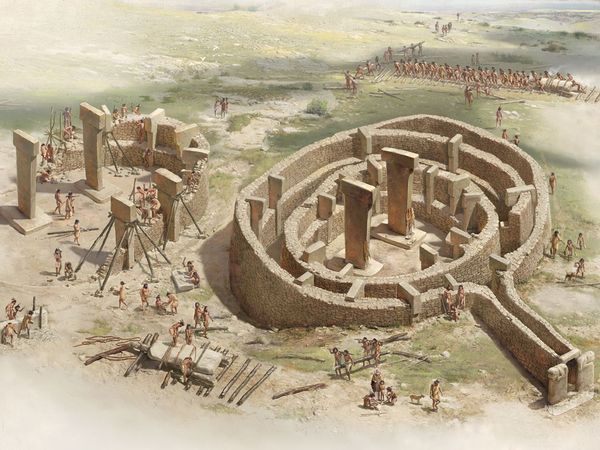 9130–7370 BCE (11,080-9320 BA, a 1,760 year period): Göbekli Tepe and older sister site Karahan Tepe (10550 BCE, 12,500 BA) are archaeological sites in the Southeastern Anatolia Region of modern-day Turkey featuring the earliest known massive monument building that was begun by hunter-gatherer nomads. As they were not united by force of arms, and the site is for ceremonial use on special occasions when the nomadic bands meet up, the site is evidence for the first Empire of Belief that enabled super-tribalism, the exceeding of Dunbar's number, created by a priest/storyteller whose narrative spreads to the storytellers in other bands who come to tell the viral tale.
9130–7370 BCE (11,080-9320 BA, a 1,760 year period): Göbekli Tepe and older sister site Karahan Tepe (10550 BCE, 12,500 BA) are archaeological sites in the Southeastern Anatolia Region of modern-day Turkey featuring the earliest known massive monument building that was begun by hunter-gatherer nomads. As they were not united by force of arms, and the site is for ceremonial use on special occasions when the nomadic bands meet up, the site is evidence for the first Empire of Belief that enabled super-tribalism, the exceeding of Dunbar's number, created by a priest/storyteller whose narrative spreads to the storytellers in other bands who come to tell the viral tale.
Believing priests, former storytellers, turn humans into true believers and thereby prosper. The High Priestess or Priest can direct monument building during the regional gathering to hear the Word from on High. Priests and/or priestesses are elites lording over the minds of commoners, teaching them to believe in belief from early childhood. Elite religious hierarchies form before military empires are made possible by agricultural surplus. When chiefs come to rule chiefdoms, the priests are natural fellow elites who tend to support the armed empire builders by mixing the political this-worldly narrative with their own other-worldly religious narrative.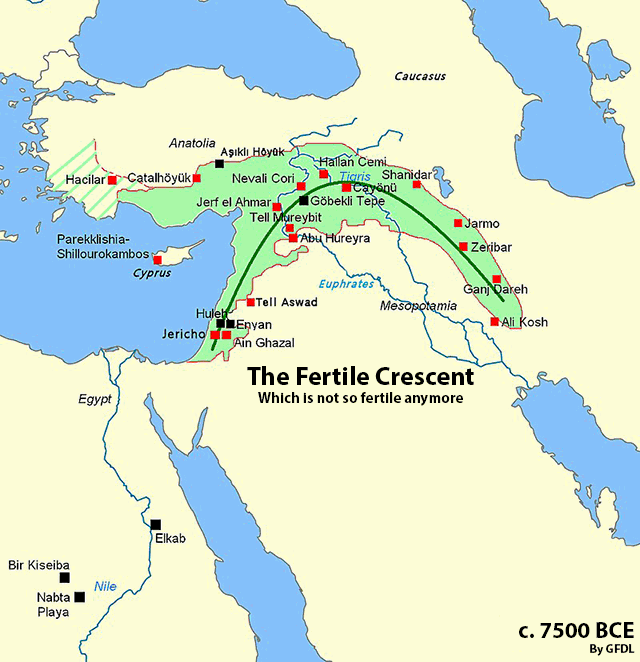
7500-5700 BCE (1,800 years, 9,450-7,650 BA): Çatalhöyük, a proto-city settlement in southern Anatolia, based on early agriculture. Peak development 7000 BCE with 18 successive layers of buildings signifying various stages of the settlement and long decline as there were no outlying empire-builders to conquer the region. The failure of the agricultural production system may have been enabled by the adoption of the newly invented plow that enabled overproduction and increase in soil erosion.
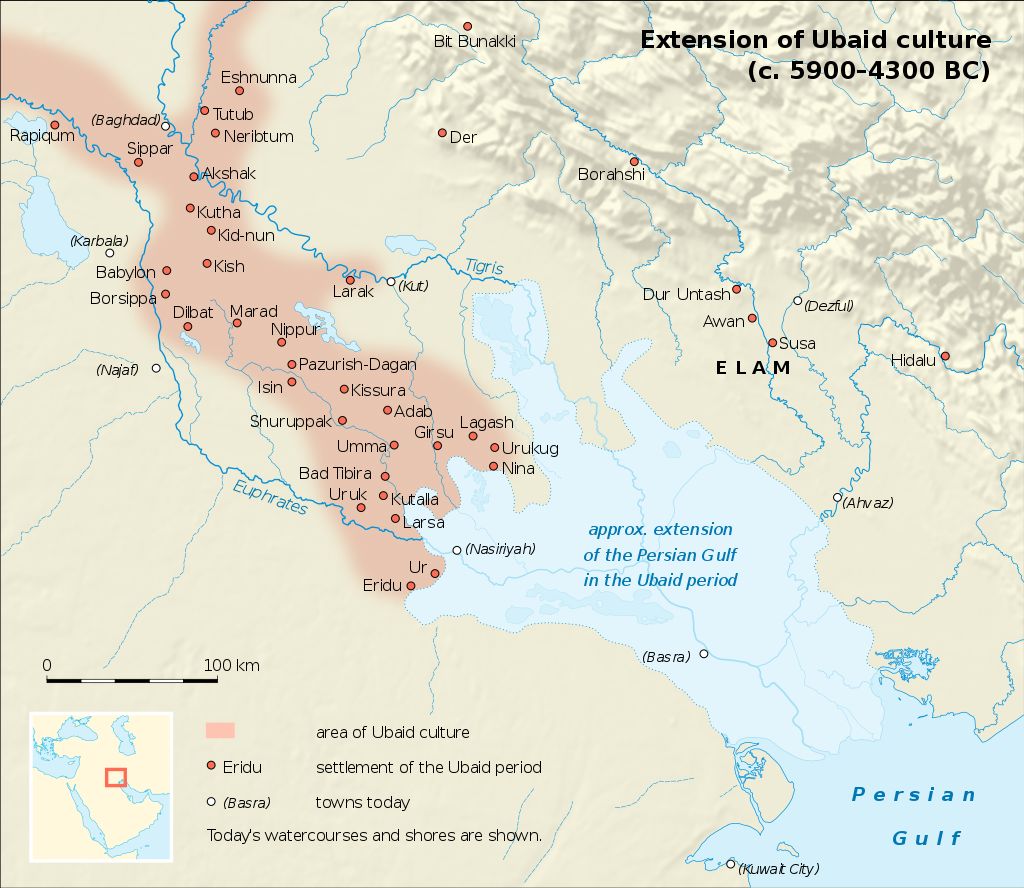 6500–3800 BCE (2,700 years, 8450-5750 BA): The Ubaid period is a prehistoric period of early state level empire-building among Mesopotamian agriculturalists living in complex societies above the chiefdom or cty-state level of empire-building. In South Mesopotamia the period is the earliest known period on the alluvial plain. In North Mesopotamia the period runs only between about 5300 and 4300 BCE (a 1,000 year northern pulse). Agriculture allows for chiefdoms, trial runs for later more expansive empire-building that favor alpha male chiefs and warriors along with their verbal defenders.
6500–3800 BCE (2,700 years, 8450-5750 BA): The Ubaid period is a prehistoric period of early state level empire-building among Mesopotamian agriculturalists living in complex societies above the chiefdom or cty-state level of empire-building. In South Mesopotamia the period is the earliest known period on the alluvial plain. In North Mesopotamia the period runs only between about 5300 and 4300 BCE (a 1,000 year northern pulse). Agriculture allows for chiefdoms, trial runs for later more expansive empire-building that favor alpha male chiefs and warriors along with their verbal defenders.
6500-5400 BCE (1100 years, 8450-7350 BA): The Siberian taiga culture developed the first fortified settlements based on fish, elk, waterfowl, and reindeer harvests stored by smoking and in permafrost. The lived in pit houses surrounded by forest near rivers. At some point they came to view each other as a needed resource for the taking. Descent to local extinction.
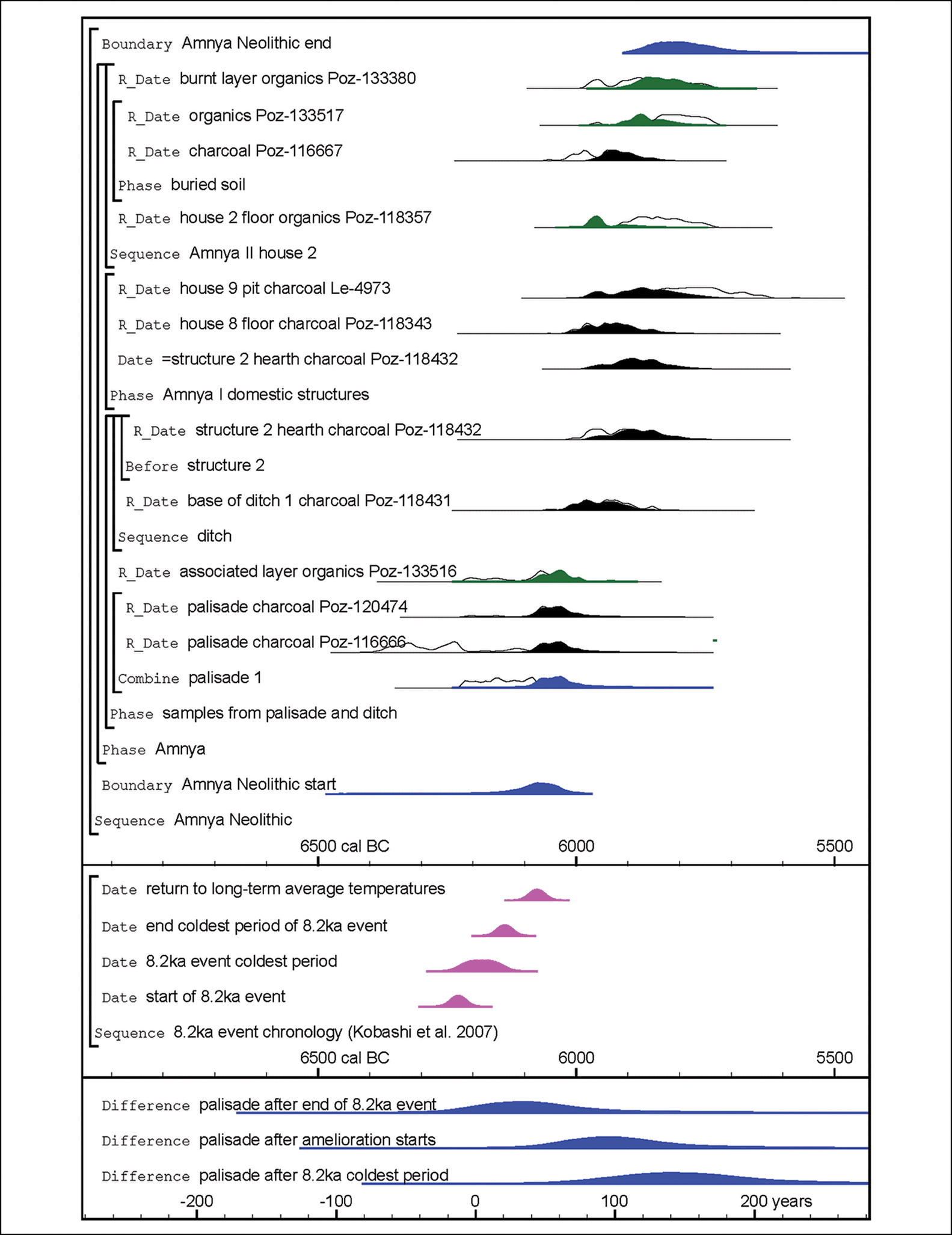
5950-4850 BCE (1100 years, 7900-6800 BA): The early Korean hunter-gatherer culture formed long-term settlements on the coast by exploiting abundant marine resourses, for a time.
5900-2500 BCE (3400 years, 7850-4450 BA): The early Malta inhabitants came from Sicily (inhabited about 10k BCE) about 5900 BCE, 80 km (50 mi) by sea to the north. The settlers were renormalizing Neolithic hunter-forager-farmers whose expansionist ancestors had left Africa 50k years earlier to take Eurasia from prior hominins, The renormalizing Maltese persisted for 1900 years before transitioning to a complex society that proved itself to be overcomplex after 1500 years, 60 generations, of denormalization (if renormalizing is possible for us, could it be achieved in less time?). The islands of Malta are nearly twice the area of Easter Island, and were, like Rapa Nui, well forested when the first humans came ashore with crops and livestock. The dwarf hippos, giant swans and dwarf elephants were soon extinct. From 4000 BCE to 2500 BCE, complex society arose, megalithic temples with a fertility goddess theme were built prior to Egyptian pyramids. The Ġgantija megalithic temples [e.g. below and take a walking tour] built 3600-2500 BCE are the world's second oldest existing man made religious structures after Göbekli Tepe/Karahan Tepe.
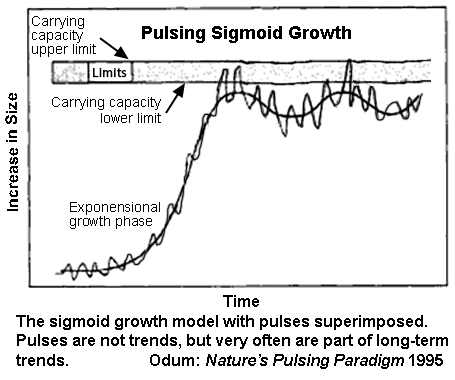 A human ecology view suggests that the first human inhabitants, as an invasive species, may have caused megafauna extinctions as usual (but correlation may not be causation), but transitioned to maintaining a stable population as K-strategists bumping up against the island's carrying capacity for about 1900 years (unlike Easter Islanders) by living in small band size (20 to 50) groups as hunters and low-intensity forager-gardeners who do not build monuments, likely matriarchal. These early Maltese had crops and livestock, but may have lived like Calhoun's first rats, wild rats who maintained a stable population regulated by overdensity stress, and so did not overpopulate their habitat. They could have, but did not, overshoot carrying capacity by deforesting the island for short-term maximizing of agricultural productivity, a dynamic that requires elites and commoners (i.e. complex society lacking Mothers, a band-sized population's control system replaced in complex societies). Later waves of migrants from Sicily likely lead to crowded overexploitation of island resources (e.g. forests and soils).
A human ecology view suggests that the first human inhabitants, as an invasive species, may have caused megafauna extinctions as usual (but correlation may not be causation), but transitioned to maintaining a stable population as K-strategists bumping up against the island's carrying capacity for about 1900 years (unlike Easter Islanders) by living in small band size (20 to 50) groups as hunters and low-intensity forager-gardeners who do not build monuments, likely matriarchal. These early Maltese had crops and livestock, but may have lived like Calhoun's first rats, wild rats who maintained a stable population regulated by overdensity stress, and so did not overpopulate their habitat. They could have, but did not, overshoot carrying capacity by deforesting the island for short-term maximizing of agricultural productivity, a dynamic that requires elites and commoners (i.e. complex society lacking Mothers, a band-sized population's control system replaced in complex societies). Later waves of migrants from Sicily likely lead to crowded overexploitation of island resources (e.g. forests and soils).
By about 4000 BCE the population was large enough to form unsustainable complex clan societies that select for hierarchies, as at Göbekli Tepe, lead by priests/priestesses with an interest in temple building. The first modest temple building began about 4000 BCE and had become widespread and immodest by 3500 BCE, climaxing some time after 3000 BCE as prosperity gave way to multiple economic and environmental stressors.
Their complex society had no regional enemies and empire building was confined to remorseless expansion of ever increasing extent and intensity empowered by unsustainable farming, however slow the pace. It was in the short-term self interest of island elites (as predator population exploiting belief-based cognition) to pressure commoners (as true believing prey population) to produce more offerings to provision the temple (and keepers of the temple). There was, near the end, a great acceleration in prosperous (not remotely sustainable) development.
The population peaked some time after 3000 BCE with temple building reaching a feverish pitch in the final phases of religious control system activity about 2500 BCE when complex society collapsed throughout the islands (all temple building ends and not because everybody decided to move back to Sicily). Expansion by conquest was not possible, even if there had been a warrior class, as was leaving a deforested island by wooden ships. The peak population before die-off is unknown, but would have been in the tens of thousands. Fertility cults, priestesses, and perhaps even Mother, gave way to death cults likely dominated by priests.
By 2000 BCE the island was, or nearly was, uninhabited/uninhabitable, i.e. had experienced an Easter Island deforestation/overshoot/depopulation event caused by the slow emergence of 'civilization' pathology. Like rats in a Calhoun experiment, they seem to have undergone a self-extinction event. [This is of interest as humans are now doing an overshoot event globally for the first time, and though a remnant population is likely, they may fail to reboot to live in viable societies, as happened with the Indus Valley Civilization. A near extinction event, if not extinction, of humans is of concern, and if a remnant population passes through the bottleneck, will it ever recover lost functionality if no functional humans also pass through it? If there are still humans on the planet in five thousand years, what sort of humans will they be?]
Malta was eventually resettled by Bronze Age warriors, a patriarchal culture who built the fortified settlement of Borg in-Nadur about 1500 BCE after partial environmental restoration/recovery of island resources (in one sense or another, we are all descendants of Borg). If there was a remnant population of prior inhabitants, they had lost or failed to pass on any elements of their culture, i.e. there was also a loss of information event approaching or equaling 100 percent as usual. If they had developed a writing system, no literate temple builders survived the overshoot and collapse event.
Today Malta has a population of over 500k. The agriculture, with less than 600 mm (24 in,) of mostly winter rain, is modern agribusiness/irrigation production, dependent on fossil fuel inputs. Transitioning back to sustainable low intensity swidden agriculture would support far less than the 4,000 people in prehistoric times prior to the extensive environmental degradation of today that began with over exploitation 4000-2500 BCE. If (when) the planes stop landing and ferries stop bringing tourists, and ships stop importing supplies, Malta will undergo a 99+ percent depopulation event even if no one votes for it.
The end of modern techno-industrial (MTI) production and consumption is the condition that will come anyway. If modern Malta ended all imports this year, 99+ percent of the population would leave the islands (mostly peacefully with enthusiasm) to live elsewhere until they and/or their descendants couldn't. I would advise the people of Malta having foresight intelligence to "seek out the condition now that will come anyway" [H.T. Odum]. I would also advise the frog in the pot of warming water to get out, even though it feels so good (for a time).
But pick any other place on the planet..., the same advice would be in the resident's long term best interest. MTIed (modern techno-industrialized) humans may consider Malta a better example of what happens when a culture overshoots environmental productivity than Easter Island or St. Matthew Island. Those living in Malta now, lacking foresight intelligence, will not act because they cannot.
We are all living on a Malta the size of a planet, but we will leave more impressive ruins. We are now, for a time, a 'superorganism'. The basic unit of society is not a band of related mothers. The basic unit of modern techno-industrial society is the corporation, an amoeboid like dissipative structure that must keep on keeping on (to 'for a beautiful moment in time' create a lot of value for shareholders) until it can't. We who are dependent on it, must serve it until we can't. And those who are not too dependent on it, who do not believe in it, may be too few (<0.01%, including dependents, maybe 50 at most on Malta) to matter.
Note to posterity: sorry about that.

From Malta past to present, the question of what 50 Maltese might do leads to The Malta Solution that is unthinkable to MTI humans, almost as unthinkable as thinking that we are not just animals, but dysfunctional animals whose only hope is to renormalize as mere animals, i.e. stand down from our hubris heights. The amygdalas of all MTI humans react to the obvious truth of their being by shouting in unanimous consensus: NO! The solution thus becomes viewed as worse than going extinct. Lord Man be gone.
5800-3000 BCE BCE (3000 years, 7750-4750 BA): Cucuteni–Trypillia culture,one of the first Old European cultures invaded by Indo-Europeans. A Neolithic–Chalcolithic archaeological (Linear Pottery) culture of shifting agriculture and settlements mostly self-sufficient with very little need for trade and with low levels of social stratification (inequality), but no evidence they were able to limit their expansion.
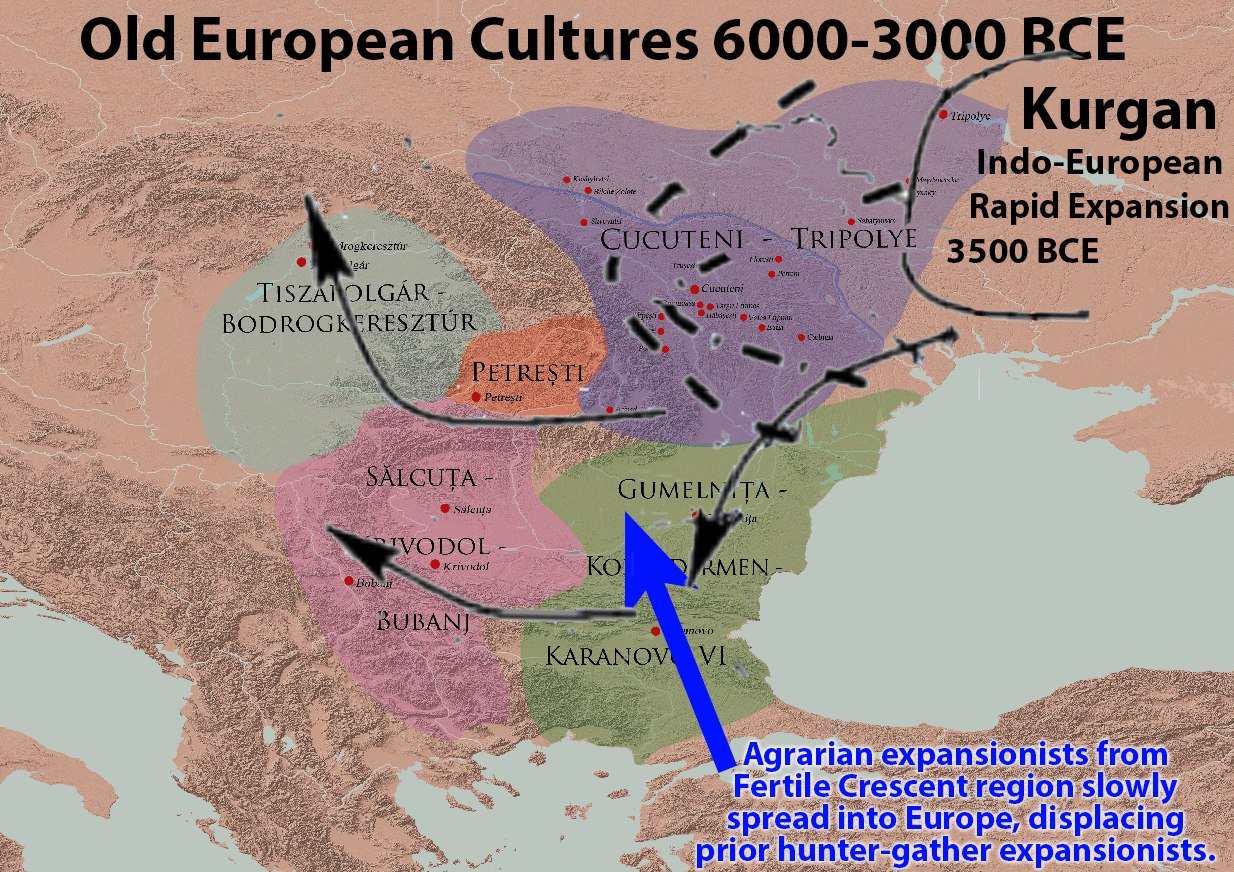
Early period Cucuteni pre-Indo-European expansion (5800-4050 BCE) inhabitants were agrarians with cattle, sheep, goats from Fertile Crescent region having a matrifocal culture. Early homes were pit-houses, then wood and clay-daub structures.
Middle period (5000–3500 BC) was one of expansion and population growth as more land was put under cultivation/grazing.
Late period (3500–3000 BC). Towards the end, 600-700 small settlements were abandoned as they would have no defense against a greater number of raiders on horses, and the culture/adult male population was replaced by Indo-Europeans with horses who imposed their language and cultural norms (and bred the females). The Old Europeans had displaced the partially renormalized hunter-gather indigenous expansionists while rarely interbreeding with or adopting their orphans.
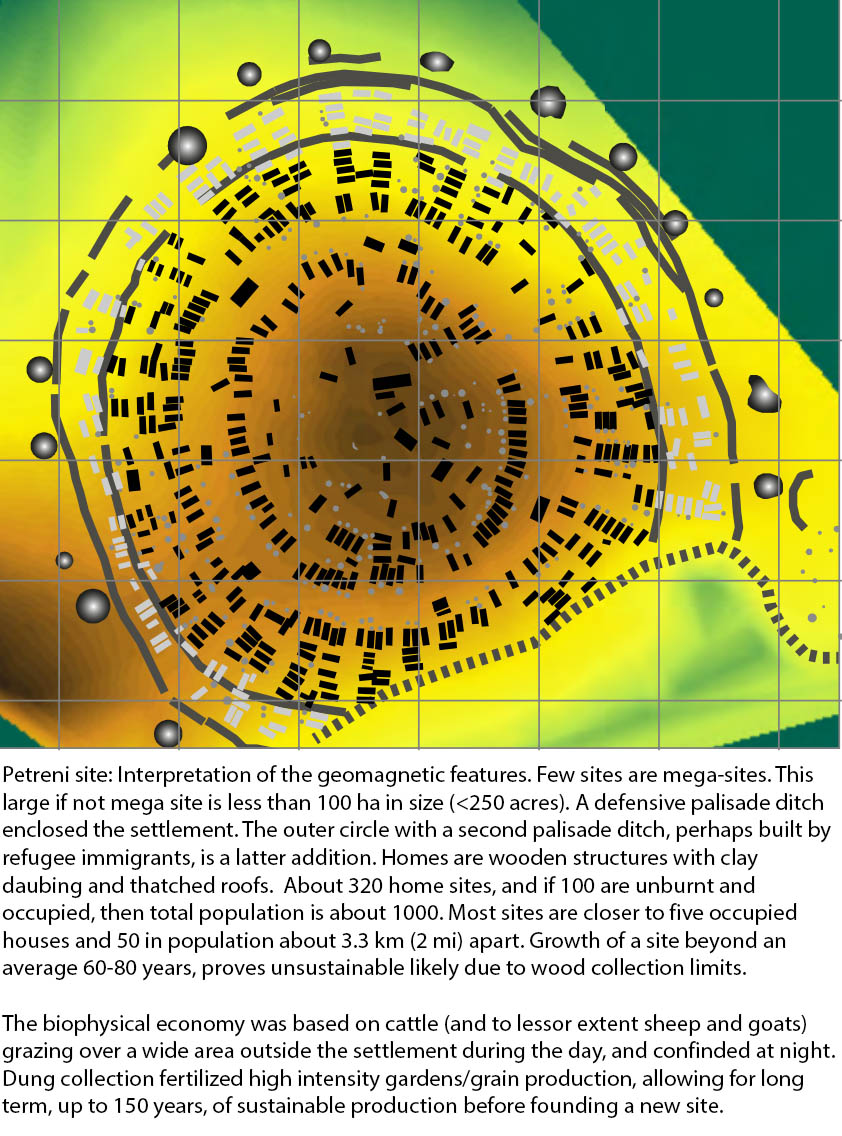
Some giant-settlements or mega-sites (>150 hectares/370 acres and of more than 1000 houses each) developed, lasting up to 150 years, the largest (Talianki) reaching 340 ha (840 acres). Settlements average lifespan was 60 to 80 years up to 150 years for mega-sites. One site had 13 levels of habitation between periods of abandonment.
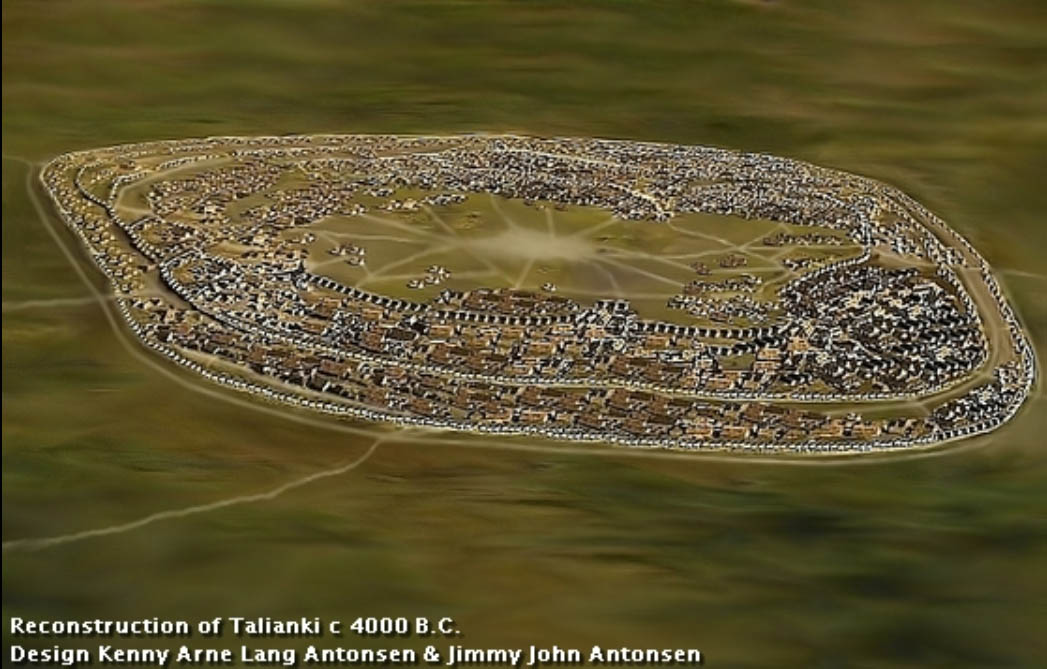
Early Indo-Europeans may have domesticated cattle 9 thousand years ago on the northern margins of the Fertile Crescent, and prior to developing wheeled cart technology, slowly moved north into the region of today's Moldova and covering substantial parts of western Ukraine and northeastern Romania. The majority of Cucuteni–Trypillia settlements were of small size (<150), high density (spaced 3 to 4 kilometers [1.9-2.5 miles] apart), concentrated mainly in the Siret, Prut and Dniester river valleys. During its middle phase (c. 4000 to 3500 BC), populations belonging to the Cucuteni–Trypillia culture built the largest settlements in Neolithic Europe, some of which contained as many as three thousand structures (3.4 burnt:1 unburnt) and were possibly inhabited by estimated >12,000 people (7-15 people/structure) at Maidanetske assuming all structures were occupied (settlements only lasted about 150 years and if houses lasted 30 years, they may have been burnt and a new one build near it, so total population may have been 5000).
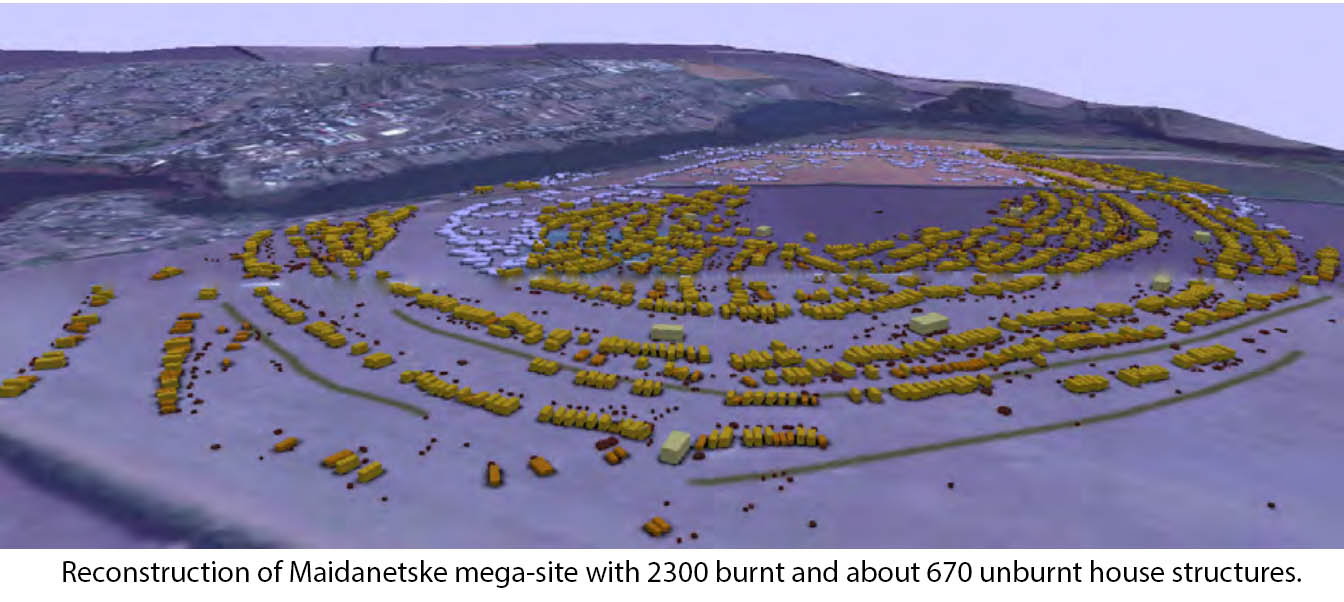
Average house size of 77m² (829 ft sq) known space requirements for persons in sedentary societies if 5-15m²/person in a house, averaging 6.97m²/person (75 sq ft/person, 10 persons/household) in prosperous settled communities.
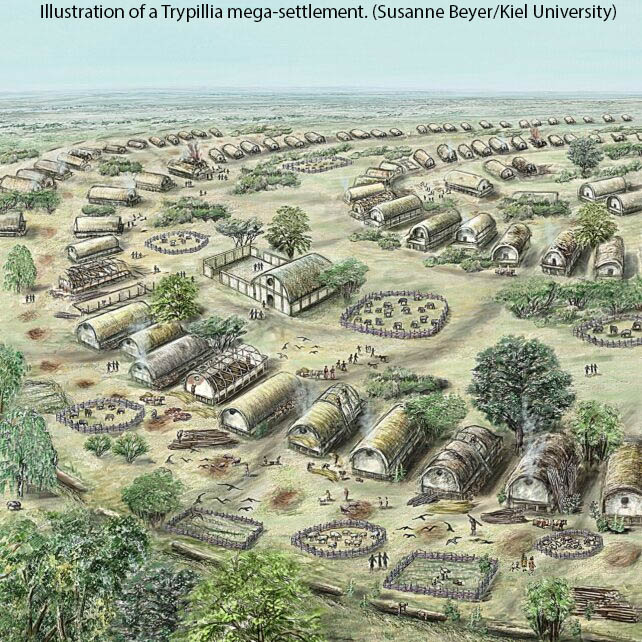
There is no evidence of an Indo-European Kurgan blitzkrieg (that took 5k years to perfect). The taking of the Cucuteni–Trypillia region may have taken a century or two to complete as the Indo-European conquest culture learned what works and how to do the vin, vidi, vici thing faster. That 64% of today's European males descend from just three Info-Eurpean paternal ancestors is "proof" of their metastatic superiority at they would view it—rapid growth also being the ideology of the cancer cell.

With a better understanding of agroecology, however, the Trypillia culture of shifting agriculture was sustainable at a low density, as is Swidden agriculture in the tropics. But recovering r-cultures are not renormalized K-cultures able to know their limits. The Trypillians were no match to the Indo-European aggressive expansionism on horse with bronze weapons.
At one point the Old Europeans out numbered the agressive expansionists 100:1 or greater. If they had recognized the existential threat of the Indo-Europeans (most of you reading this), and each community of 20 to 50 sent 1-2 Guardians to the east to confront them when they first started their expansion about 6000 BCE, then 100k vs 1k warriors would likely have had a different outcome, but likely waiting until 3000 BCE was too late. As an outcome, our global condition of overshoot may be game over for the last hominin standing.

5250-4500 BCE (750 years, 7200-6450 BA): The Hamangia culture, to the east of the Cucuteni–Trypillia culture, was late Neolithic settlements having mixed horticultural economies between the Danube and the Black Sea that was absorbed/conquered by the expanding Indo-Europeans making them the first Old European complex society to be conquered by another empire-building culture. The Hamangians celebrated the Goddess, but those who 'displaced' them did not. Hamangian cultural links with Anatolia suggest that it was the result of a recent settlement by people from Anatolia, unlike the neighboring cultures, whom the Hamangians displaced/conquered.
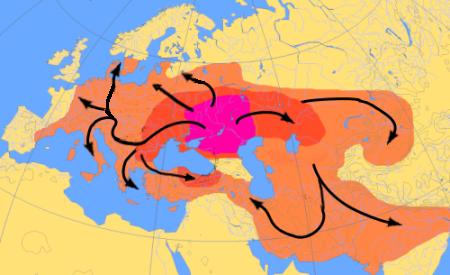 5200 BCE (7150 BA): The Indo-European expansion of language and culture that selects for rapid empire-building spread in several stages from the Pontic steppes into western Europe, central Asia and India. This process started with the introduction of cattle at the Eurasian steppes, which led to the rise of a new culture, to a kind of cowboy culture. Between 5000 and 2000 BCE, they spread-out with their cattle first and later horses over the Pontic steppes, and outside into Europe and Asia. Use of force was involved in displacing hunter-gatherers, but the expansion was based on cattle as the basis of the economic system that empowered them. Much as plant-based agriculture supported empires in Mesopotamia, Egypt, India, China, coastal Andes, and Mesoamerica, animal-based agriculture supported the spread of the Indo-Europeans. The first Indo-European speakers to build empire based on military force are the Hittites who had spread into central Turkey fighting with chariots and iron weapons. Linguistics has allowed the reliable reconstruction of a large number of words relating to kinship relations. These all agree in exhibiting a patriarchal, patrilocal and patrilineal social fabric that opposes the Paleolithic hunter-gatherer and Early and Middle Neolithic egalitarian norms. In patriarchies women are exogamous, joining their husband's (their overlord's) family. The mythology focuses on supreme beings, on really Big Gods with strongly alpha male natures who are intolerant of matriarchal narratives. Empire-building favors patriarchal values and the conquered become patriarchal. Wanting to be an alpha male is a biological atavism as is the capacity to fear and submit to alpha male elites, real or imagined, that goes with empire-building.
5200 BCE (7150 BA): The Indo-European expansion of language and culture that selects for rapid empire-building spread in several stages from the Pontic steppes into western Europe, central Asia and India. This process started with the introduction of cattle at the Eurasian steppes, which led to the rise of a new culture, to a kind of cowboy culture. Between 5000 and 2000 BCE, they spread-out with their cattle first and later horses over the Pontic steppes, and outside into Europe and Asia. Use of force was involved in displacing hunter-gatherers, but the expansion was based on cattle as the basis of the economic system that empowered them. Much as plant-based agriculture supported empires in Mesopotamia, Egypt, India, China, coastal Andes, and Mesoamerica, animal-based agriculture supported the spread of the Indo-Europeans. The first Indo-European speakers to build empire based on military force are the Hittites who had spread into central Turkey fighting with chariots and iron weapons. Linguistics has allowed the reliable reconstruction of a large number of words relating to kinship relations. These all agree in exhibiting a patriarchal, patrilocal and patrilineal social fabric that opposes the Paleolithic hunter-gatherer and Early and Middle Neolithic egalitarian norms. In patriarchies women are exogamous, joining their husband's (their overlord's) family. The mythology focuses on supreme beings, on really Big Gods with strongly alpha male natures who are intolerant of matriarchal narratives. Empire-building favors patriarchal values and the conquered become patriarchal. Wanting to be an alpha male is a biological atavism as is the capacity to fear and submit to alpha male elites, real or imagined, that goes with empire-building.
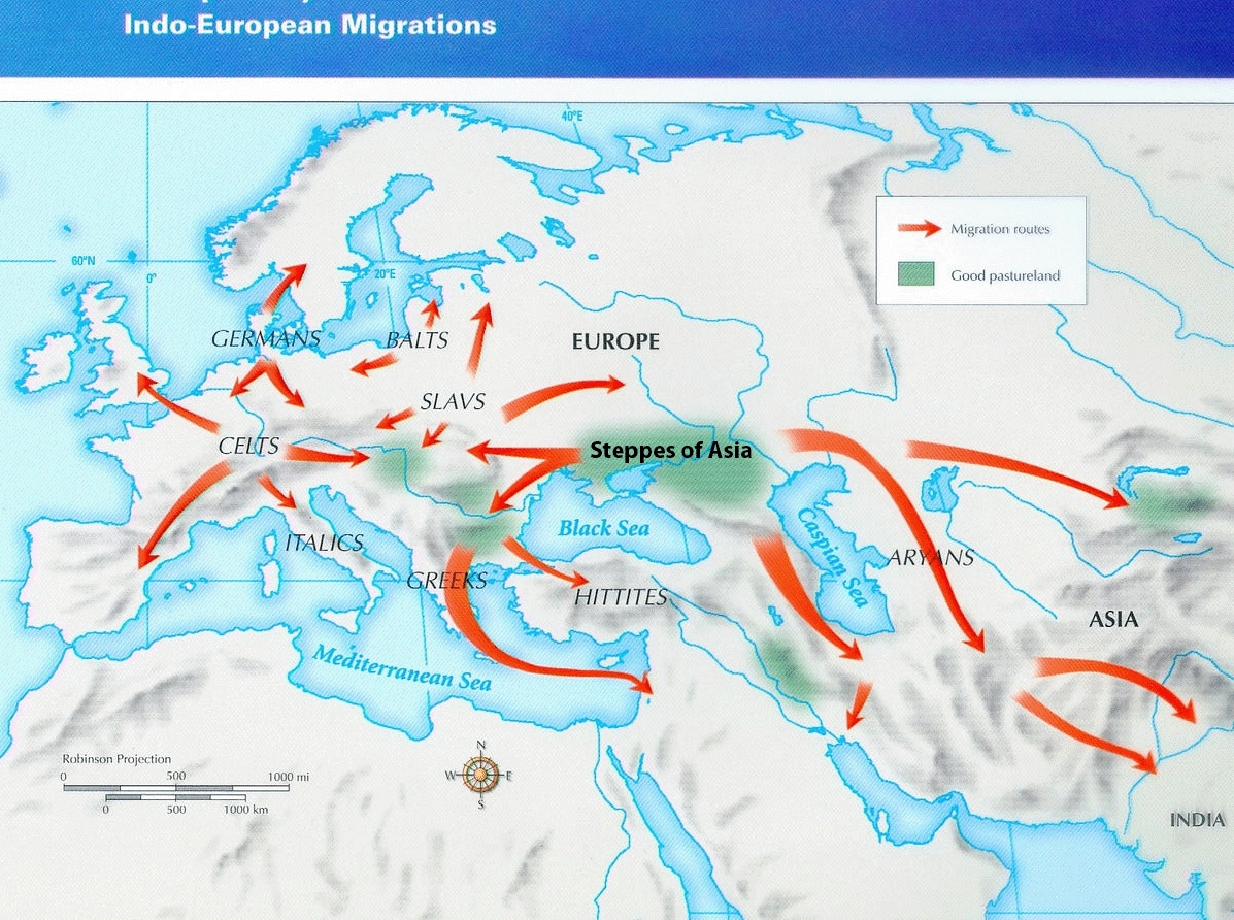
4000–3100 BCE (900 years, 5950-5050 BA): The Uruk period existed in the protohistoric Early Bronze Age period in the history of Mesopotamia and was the first state-level overcomplex, stratified, hierarchical society with an appreciable division of labor (weavers, artisans, priests, prostitutes, metalworkers, clerks, soldiers, cultivators) supported by taxes collected in the form of grain and labor to serve elite interests (priests and potentates). War was needed to acquire resources/slaves from outliers as there was as yet no nearby competing empire builders to threaten their taking. This period saw the emergence of urban life in Mesopotamia. It was followed by the Sumerian civilization. The late Uruk period (34th to 32nd centuries) saw the gradual emergence of the cuneiform script and corresponds to the Early Bronze Age; it may also be called the Protoliterate period.
4000–3800 BCE (200 years, 5950-5750 BA): Nebelivka, located in Ukraine, north of Black Sea, is the site of an ancient mega-settlement likely occupied for a part of each year as a ritual, ceremonial or defensive gathering place. Artefacts include female or Venus figurines. Perhaps 3,000 to 4,000 people inhabited Nebelivka for around one month each year. During that time, people who assembled at the megasite made new contacts, shared knowledge and goods, and conducted communal activities such as house building and burning. Perhaps 100 to 150 guardians lived at and maintained Nebelivka year-round. That bands of forager-hunters periodically meet up to exchange genes and memes was the hominid norm for millions of years. That the gatherings were so large, enabled by large wild grain harvest/storage then planted crops, left ruins from lithic construction, and allowed a permanent population to occupy the site, was not.
3900–2300 BCE (1600 years, 5850-4250 BA): Sannai Maruyama site in Japan, abundant marine life supported long term settlements of hunter-gatherers, for a time. Rapid growth in complexity to climax followed by decline to local extinction.
3850–3700 BCE (150 years, 5800-5650 BA): Talianki, is an archaeological site near the village of the same name in Ukraine, about 34 km walking distance from Nebelivka, currently the largest known settlement of the time in Neolithic Europe before the coming of the Indo-Europeans. At its height, Talianki could have been occupied by over 6k-15k inhabitants supported by cereal agriculture. Early settlements by matriarchal cultures followed egalitarian norms of the forager-hunters who added gardening to their culture until overcomplexity selected for hierarchy/inequality and high intensity farming over the centuries to support developing elite populations initially of priestesses/priests. Conquest by patriarchal Indo-Europeans tended to displace such cultures across Europe and Central Asia, then worldwide.
3650–1450 BCE (2,200 years, 5,600-3,400 BA): Minoan civilization (mature period 2000–1450 BCE) was an Aegean Bronze Age civilization that arose on the island of Crete and other Aegean islands. Homer recorded that Crete once had 90 cities. The Minoan writing system remains unreadable, so 100% of information recorded in it was lost.
3500–1800 BCE (1,700 years, 5450-3750 BA): The Norte Chico civilization (also Caral or Caral-Supe civilization) was a complex pre-Columbian society that included as many as 30 major population centers in what is now the Norte Chico region of north-central coastal Peru. Since the early 21st century, it has been established as the oldest known civilization in the Americas.
3500–2500 BCE (1,000 years, 5450-4550 BA): Two Ġgantija temples on the Mediterranean island of Gozo, Malta, are late Neolithic, which makes them the world's second oldest existing man made religious structures after Göbekli Tepe. The temples are elements of a ceremonial site with numerous figurines and statues associated with fertility rites.
c. 3400–2900 BCE (500 years, 5350-4850 BA): Oued Beht, Morocco, a recently (2024) reported farming culture, a a mixed population ancestry of local hunter-gatherers, Neolithic Iberian farmers and Saharan pastoralists, the earliest and largest agricultural complex in Africa beyond the Nile corridor, that cultivated barley, wheat, peas, pistachios and olives, and grazed sheep, goats, pigs and cattle with reliance on livestock on an area of 9–10ha (25 acres). The experiment in civilization building was brief for this time period. Agropastoralist practices likely not sustainable, part of the degrading of North Africa by livestock history.
3400–2250 BCE (1,200 years, 5350-4450 BA): The Liangzhu culture was the last Neolithic jade culture in the Yangtze River Delta of China. The culture was highly stratified, as jade, silk, ivory and lacquer artifacts were found exclusively in elite burials, while pottery was more commonly found in the burial plots of poorer individuals. This division of class indicates that the Liangzhu period was an early state, symbolized by the clear distinction drawn between social classes in funeral structures.
3300–3000 BCE (300 years, 5250-4950 BA): Start of Bronze Age. Weapons "improve," which facilitates empire-building. Technology becomes as a vat of wine to an alcoholic. Both feel good but have lamentable side effects. Imagine giving a hundred five year olds a machete and turning them loose on your Mother's Garden unsupervised for five hours. They would lay waste to the Garden, injure one another, and there would likely be fatalities—the story of Man's last five thousand years in the Great Mother's Garden Earth.
3300–1300 BCE (2,000 years, 5250-3250 BA): The Indus Valley Civilization (IVC) was a Bronze Age civilization (mature period 2600–1600 BCE) mainly in northwest South Asia, extending from what today is northeast Afghanistan to Pakistan and northwest India. Along with ancient Egypt and Mesopotamia it was one of three early civilizations of the Old World, and of the three the most widespread. It flourished in the basins of the Indus River and along a system of perennial, mostly monsoon-fed, rivers. The late Harappan phase, weakened but with no outside force to conquer it, witnessed large scale de-urbanization, population decrease, abandonment of many established settlements, lack of basic amenities, interpersonal violence and disappearance of the Harappan script (loss of two thousand years of information as what writing survived is unreadable–no literate Harappans survived or left a Rosetta book). Indo-European Aryans moved in the area to become the Brahmans of India.
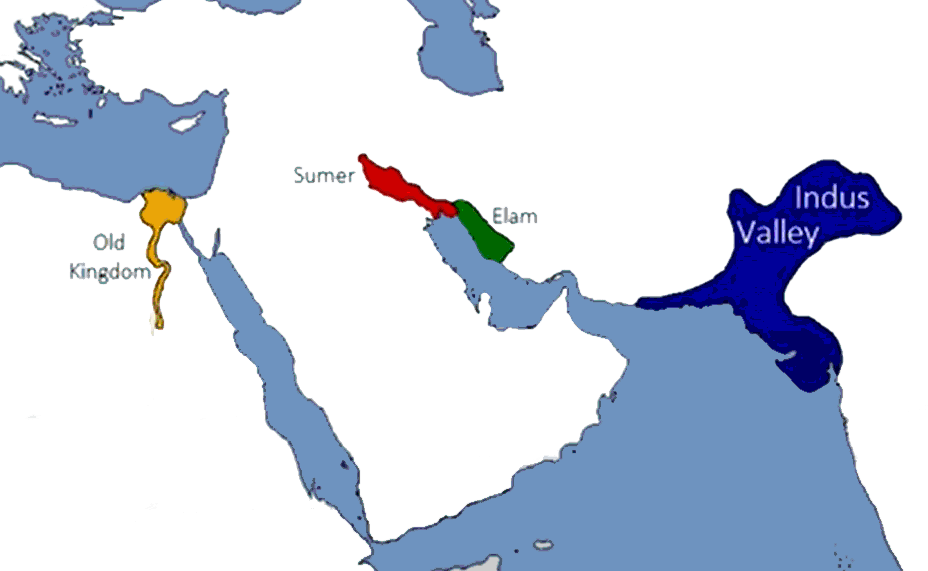
Per Wikipedia: 'Around 1900 BCE signs of a gradual decline began to emerge, and by around 1700 BCE most of the cities had been abandoned. Recent examination of human skeletons from the site of Harappa has demonstrated that the end of the Indus civilisation saw an increase in inter-personal violence and in infectious diseases like leprosy and tuberculosis. According to historian Upinder Singh, "the general picture presented by the late Harappan phase is one of a breakdown of urban networks and an expansion of rural ones."... there was a general decrease of long-distance trade.... Stone sculptures were deliberately vandalised, valuables were sometimes concealed in hoards, suggesting unrest, and the corpses of animals and even humans were left unburied in the streets and in abandoned buildings. During the later half of the 2nd millennium BCE [1500–1300 BCE], most of the post-urban Late Harappan settlements were abandoned altogether. Subsequent material culture was typically characterised by temporary occupation, "the campsites of a population which was nomadic and mainly pastoralist" and which used "crude handmade pottery."'
3000–2000 BCE (1,000 years, 4950-3950 BA): Stonehenge is a prehistoric monument in England. Stonehenge's ring of standing stones are set within earthworks in the middle of the most dense complex of Neolithic and Bronze Age monuments in England. The ceremonial site, like that of Göbekli Tepe, suggests an early empire of belief.
2700 – 539 BCE (2,161 years, 4650-2489 BA): Elam Empire western Iran region. Preceded by Proto-Elamite: c. 3200 – c. 2700 BCE period of small scale empire-building east of the Tigris and Euphrates alluvial plains, and divided into three periods: Old Elamite period: c. 2700 – c. 1500 BCE, Middle Elamite period: c. 1500 – c. 1100 BC (Anzanite Dynasty until the Babylonian invasion), Neo-Elamite period: c. 1100 – 540 BCE (characterized Assyrian and Median influence). Elam traded with the Indus Valley Civilization and the cities of Mesopotamia.
2686–2181 BCE (505 years, 4636-4131 BA): Egyptian Nile Empire, Ancient Egypt, Old Kingdom. The earliest known large-scale empire appears in Egypt when King Narmer of the Upper Valley conquered the lower Valley and laid the foundations for the Old Kingdom. Empire-building requires warriors and an agricultural surplus to support them, as well as the elites who command them. Alpha males favoring patriarchy prosper, though some empire-builders are matriarchal. New narratives as told by priests and the intelligentcia develop to normalize male and/or female elite dominance, inequality, and empire-building.
2500-1500 BCE (1,000 years, 4450-3450 BA): Kerma Kingdom. A sizable, populous empire in Upper Egypt and northern Sudan region rivaling Ancient Egypt. Around 1500 BCE, it was absorbed into the New Kingdom of Egypt, but rebellions continued for centuries.
2500–539 BCE (1,961 years, 4450-2489 BA): Phoenicia, a thalassocratic seaborne empire, ancient Semitic-speaking Mediterranean civilization that originated in the Levant, specifically Lebanon, in the west of the Fertile Crescent. The high point of Phoenician culture and sea power is usually placed c. 1200–800 BCE. Persian King Cyrus the Great conquered Phoenicia in 539 BCE.
2400–1200 BCE (1200 years, 4350-3150 BA): Hurrian Kingdom of Urkesh, emerged around the city of Urkesh in modern Iraq, during the third millennium BC. It was a major stop on trade routes between Anatolia, Syria, Mesopotamia, and the Mediterranean. Disassociated during the Late Bronze Age collapse.
2400–1900 BCE (500 years, 4350-3850 BA): Bactria–Margiana Archaeological Complex (short BMAC), also known as the Oxus civilization, numerous monumental structures in many sites, fortified by impressive walls and gates. Reports on the BMAC were mostly confined to Soviet journals beginning with excavations in the late 1970s, not well known in the West.
2025–609 BCE (1,416 years, 3975-2559 BA): Assyria, a major Mesopotamian East Semitic-speaking kingdom and empire of the ancient Near East, existed as an independent state from perhaps as early as the 25th century BCE, until its collapse between 612 BCE and 599 BCE, spanning the mid to Early Bronze Age through to the late Iron Age. Weakened by resource depletion, the fading empire was conquered by upstart empire builders on the outskirts.
2334–2154 BCE (180 years, 4284-4104 BA): The Akkadian Empire, established by Sargon of Akkad 24th century BCE, was an early all-Mesopotamian empire. Collapse followed by a 42 year "Dark Age" of famine and chaos with no prominent imperial authority until the Third Dynasty of Ur.
2112–2004 BCE (108 years, 4062-3954 BA): Third Dynasty of Ur. The last Sumerian Dynasty which came to preeminent power in Mesopotamia.
2070-1600 BCE (470 years, 4020-3550 BA): Xia Dynasty. The first dynasty in traditional Chinese history. Preceded by small scale empire-building. With size, large construction projects attempted to control flooding of Yellow River and eventually succeeded increasing agricultural output. Corruption lead to overthrow, creating the Shang Dynasty.
2050-1710 BCE (340 years, 4000-3660 BA): Middle Kingdom of Egypt. After the collapse of the Old Kingdom, Egypt entered a period of weak Pharaonic power and decentralization called the First Intermediate Period. Towards the end of this period, two rival dynasties fought for power over the entire country leading to the Middle Kingdom.
1900 BCE – 900 CE (2800 years, 3850 – 1050 BA): The Izapa, a pre-Columbian civilization on the Pacific coast plain of Central America, a huge temple centre near modern Tapachula, Chiapas. Its approximately 80 pyramidal mounds were built from earth and clay faced with river boulders. Climax cities 100 BCE– 400 CE, Terminal Formative (100 BCE – 250 CE), Early Classic (250–500 CE), Middle Classic (500–700 CE), Late Classic (700–900 CE). PostClassic period extending from A.D. 900–1521 CE. No conquest of the weakened empire until the Spanish take over of the remnant population living amid ruins. Geographically between Olmec (1500– 400 BCE) and Mayan Classic period of monument building (250 – 900 CE), Collapse of one overcomplex society leads to mass migration that can trigger the collapse of nearby complex societies as may have happened about 900 CE.
1900–1500 BCE (400 years, 3850-3450 BA): The Erlitou culture is an early Bronze Age urban society and first recorded dynasty of China. Considered the first state level society of East Asia. The earliest bronze knife dated 3000 BCE and the Yellow River was used for irrigation around 2205 BCE.
1894–1595 BCE (300 years, 3844-3545 BA): Old Babylon Empire was an ancient Akkadian-speaking state and cultural region based in central-southern Mesopotamia (present-day Iraq). Babylon greatly expanded during the reign of Hammurabi in the first half of the 18th century BCE. Babylon was then attacked by the Indo-European speaking and Asia Minor based Hittite Empire in 1595 BCE. Shamshu-Ditana was overthrown following the "sack of Babylon" by the Hittite king Mursili I. The Hittites did not remain for long.
1700–1027 BCE (673 years, 3650-1977 BA): In China rose the Shang Empire which conquered the Xia Dynasty to eventually weaken and fall to conquest by nearby empire builders.
1600 — c. 1260 BCE, (340 years, 3500-3160 BA): Mitanni Kingdom, a Hurrian-speaking state in northern Syria and southeast Anatolia (modern-day Turkey) with Indo-Aryan linguistic and political influences. Since no histories, royal annals or chronicles have yet been found in its excavated sites, knowledge about Mitanni is sparse compared to the other powers in the area, and dependent on what its neighbors commented in their texts.
1600–1180 BCE (420 years, 3500-3130 BA): The Hittites were an Ancient Anatolian people who established an empire centered on Hattusa in north-central Anatolia who spread, using horse and chariot tactics, and they were early iron workers. This empire reached its height during the mid-14th century BCE, when it encompassed an area that included most of Asia Minor as well as parts of the northern Levant and Upper Mesopotamia. The empire came to an end during the Bronze Age collapse, splintering into several independent "Neo-Hittite" city-states, some of which survived until the 8th century BCE (700 BCE).
1600–1100 BCE (500 years, 3500-3050 BA): Mycenaean Greece (or Mycenaean civilization) was the last phase of the Bronze Age in Ancient Greece. As with the later Roman Empire, the collapse of Mycenaean Greece was followed by a Dark Age which lacked a Holy Roman Empire type of institution to preserve some level of literacy. Mycenaeans developed Linear A script, which remains undeciphered, and Linear B script which the Classical Greeks came to base their written language on. During the Dark Age, information was passed on orally. Classical Greek thought was based on Homer's Dark Age narratives as they were eventually written down before being lost.
1595–1155 BCE (440 years, 3545-3105 BA): Middle Babylonian period, also known as the Kassite period, assumed political control over the region. Akkadian-speaking, their language was the lingua-franca of the Late Bronze Age societies of the eastern Mediterranean.
1570–1070 BCE (400 years, 3470-3020 BA): New Kingdom of Ancient Egypt, ruled by Thutmose III, was ancient Africa's major force upon incorporating Nubia and the ancient city-states of the Levant.
1500-500 BCE (1,000 years, 3400-2400 BA): Vedic Civilization. The period in the history of the northern Indian subcontinent following the end of the urban Indus Valley Civilization when Indo-European Aryans moved into the vacuum to bring Indo-European patriarchy and empire-building to India. The Aryans became the Brahmans at the top of the caste system that arose.
1500 BCE — 1523 CE (3022 years, 3400-427 BA): Mixtec Empire, a pre-hispanic archaeological culture, corresponding to the ancestors of the Mixtec people; they called themselves ñuu Savi, which means “people or nation of the rain”. It had its first manifestations in the Mesoamerican Middle Preclassic period (12th century BC — 10th century BC) and ended with the Spanish conquest in the first decades of the 16th century. When the Spaniards arrived in La Mixteca, many lords voluntarily submitted as vassals of Spain and retained some privileges. Other lordships tried to resist but were militarily defeated.
1500–400 BCE (1,100 years, 3400-2350 BA): Olmecs were the first major civilization in Mexico. They lived in the tropical lowlands of south-central Mexico, in the present-day states of Veracruz and Tabasco.
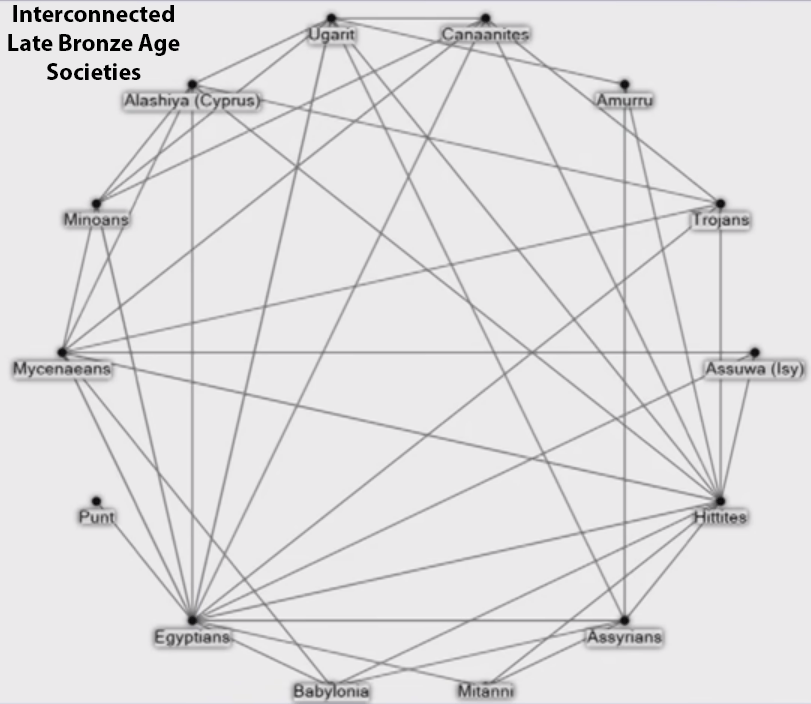
1200-300 BCE (900 years, 3150-2250 BA): Late Bronze Age collapse, a broad area wide collapse. Survivors of failed complex societies migrate (some becoming the People of the Sea and Land People) to exploit resources elsewhere which includes other complex societies. During collapse, conflict merely serves to see who inherits the rubble. History does not record the details, but a passage from Herodotus portrays the wandering and migration of Lydians from Anatolia because of famine: 'In the days of Atys, the [legendary] son of Manes, there was great scarcity through the whole land of Lydia ... So the king determined to divide the nation in half ... the one to stay, the other to leave the land. ... the emigrants should have his son Tyrrhenus for their leader ... they went down to Smyrna, and built themselves ships ... after sailing past many countries they came to Umbria ... and called themselves ... Tyrrhenians'. Migrants, aka Land Peoples, increased the human footprint elsewhere leading to collapse and more migrants. The increase in the number of migrants in the 21st century is exponential.
Near East (c. 1200 BC)
Anatolia, Caucasus, Elam, Egypt, Levant, Mesopotamia, Sistan, CanaanSouth Asia (c. 1200 BC)
Bronze Age South Asia, Ochre Coloured Pottery, Cemetery HEurope (c. 600 BC)
Aegean (Cycladic, Minoan, Mycenaean), Caucasus, Catacomb culture, Srubna culture, Beaker culture, Unetice culture, Tumulus culture, Urnfield culture, Hallstatt culture, Apennine culture, Canegrate culture, Golasecca culture, Atlantic Bronze Age, Bronze Age Britain, Nordic Bronze AgeEast Asia (c. 300 BC)
Erlitou, Erligang, Gojoseon, Jomon, Majiayao, Mumun, Qijia, Siwa, Wucheng, Xindian, YueshiVideo mentions the Hekla 3 Icelandic volcano eruption as possible cause, and 1100 BC as a date, which is too late to be a cause. Best guess current date is 1021 BC ±130, but some Egyptologists are certain 1159 BC is the exact date. Embrace ignorance and believe no one. Data says that for centuries steady and reliable rainfall had irrigated vast areas, increasing all human populations... until it didn't, carrying capacity for humans fell, and the human populations were in overshoot.
Another story is that Dorian pressure on the Mycenaean overcomplex society (one Indo-European conqueror invading another) as environmental productivity ebbed (perhaps beginning within the Dorian region in northern Greece) lead to regional collapses in northern Greece and populations of iron slashing sword armed migrant refugees (there was a late Bronze Age bronze shortage) who did what they had to do to persist short term. As already stress neighboring communities were taken, those who couldn't beat 'em joined 'em to move on to other settlements where some adaptive survivors joined them. Within a century Mycenae had collapsed (followed by Minoans...) and the Sea and Land Peoples spread to seriously threaten even Egypt. Assyrians persisted only by withdrawing away from the Mediterranean region back to their stronghold. The Phoenicians were already a sea people and expanded their empire while avoiding the newcomers who, as a dissipative structure, came to pass away with few remnant populations (e.g. Philistines) forming a non-marauding culture of would-be conquerors.
A 2020 video presentation by Eric Cline, archaeologist, offers a systems view of the Late Bronze Age collapse, i.e. 'it's complicated'. Systems collapse of complex interconnected societies has no one cause even if there is one trigger. In hindsight, collapse looks more like a perfect storm of negative feedback loops. This happening may be history's best preview of what is a happening now.
1200–675 BCE (525 years, 3150-2625 BA): Phrygian Kingdom, a kingdom in the west-central part of Anatolia, in what is now Asian Turkey, centered on the Sangarios River. After its conquest, it became a region of the great empires of the time. According to Homer’s Iliad, the Phrygians participated in the Trojan War as close allies of the Trojans. Phrygian power reached its peak in the late 8th century BC under another historical king, Midas, who dominated most of western and central Anatolia and rivaled Assyria and Urartu for power in eastern Anatolia. Over time Phrygians became Christian and Greek-speaking, assimilating into the Byzantine state; after the Turkish conquest of Byzantine Anatolia in the late Middle Ages, the name “Phrygia” passed out of usage as a territorial designation.
1200–546 BCE (654 years, 3150-2496 BA): Kingdom of Lydia, covered all of western Anatolia. Coins appear to have been invented in Lydia around the 7th century BCE and was the first to establish retail shops in permanent locations (first money and malls, what's not to like? They were also the first to debase their coinage.). A considerable building program during the 6th century BCE weakened the wealth of the kingdom. In 547 BC, the Lydians, seeking to enrich themselves as usual, besieged and captured the Persian city of Pteria and enslaved its inhabitants. The Persian king Cyrus The Great's army marched against the Lydians whose empire became a province of the Persian Empire per empire-building as usual.
1180-700 BCE (480 years, 3130-2650 BA): Phrygia. The Phrygians participated in the Trojan War as close allies of the Trojans. Phrygian power reached its peak in the late 8th century BCE when they dominated most of western and central Anatolia and rivaled Assyria and Urartu for power in eastern Anatolia. They gradually weakened and became assimilated into other cultures.
1046–256 BCE (790 years, 2996-2206 BA): The Zhou Empire replaced the Shang Empire. Both surpassed in territory their contemporary Near Eastern empires. The Zhou Empire dissolved in 770 BCE into a feudal multi-state system which lasted for five and a half centuries until the universal conquest of Qin in 221 BCE.
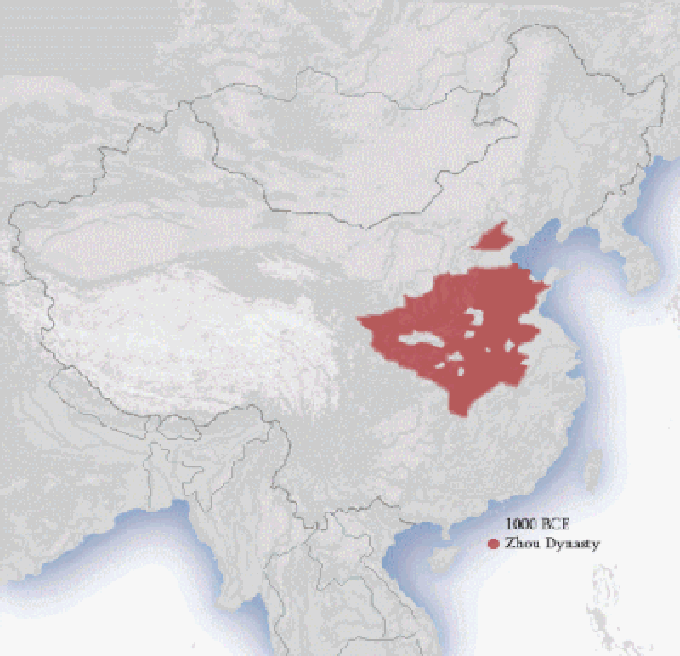
Agro-empowered Sino empire building expansionists were preceded by Man the Hunter expansionists.
1,020 - 722 BCE (298 years, 2970-2672 BA): Kingdom of Israel and Judah. The Kingdom of Israel existed as an independent state until 722 BCE when it was conquered by the Assyrian Empire, while the Kingdom of Judah (or Southern Kingdom) existed as an independent state until 586 BCE when it was conquered by the Neo-Babylonian Empire.
916–612 BCE (304 years, 2866-2562 BA): Neo-Assyrian Empire, the first empire comparable to Rome in organization.
900–200 BCE (700 years, 2850-2150 BA): The Chavín culture is an extinct prehistoric civilization that developed in the northern Andean highlands of Peru. The end was preceded by a large increase in population.
900–100 BCE (800 years, 2850-2050 BA): Etruscan Civilization. The decline was gradual, but by 500 BCE the political destiny of Italy had passed out of Etruscan hands. The last Etruscan cities were formally absorbed by Rome around 100 BCE.
900s–192 BCE (700 years, 2850-2150 BA): Spartan Empire, a prominent city-state in Laconia in ancient Greece. In antiquity, the city-state was known as Lacedaemon, while the name Sparta referred to its main settlement on the banks of the Eurotas River in the Eurotas valley of Laconia, in south-eastern Peloponnese. Around 650 BC, it rose to become the dominant military land-power in ancient Greece. Given its military pre-eminence, Sparta was recognized as the leading force of the unified Greek military during the Greco-Persian Wars, in rivalry with the rising naval power of Athens. Sparta was the principal enemy of Athens during the Peloponnesian War (431–404 BC), from which it emerged victorious after the Battle of Aegospotami. The decisive Battle of Leuctra against Thebes in 371 BC ended the Spartan hegemony, although the city-state maintained its political independence until its forced integration into the Achaean League in 192 BC. The city nevertheless recovered much autonomy after the Roman conquest of Greece in 146 BC and prospered during the Roman Empire, as its antiquarian customs attracted many Roman tourists. However, Sparta was sacked in 396 AD by the Visigothic king Alaric, and underwent a long period of decline, especially in the Middle Ages, when many of its citizens moved to Mystras.
860-590 BCE (248 years, 2810-2540 BA): Kingdom of Urartu. The kingdom rose to power in the mid-9th century BC, but went into gradual decline and was eventually conquered by the Iranian Medes in the early 6th century BCE. The geopolitical region would re-emerge as Armenia shortly after.
814–146 BCE (668 years, 2764-2096 BA): In the western Mediterranean the Empire of Carthage arises and falls. An ancient Semitic civilisation based in North Africa. Initially a settlement in present-day Tunisia, it later became a city-state and then an empire. Founded by the Phoenicians in the ninth century BC, Carthage reached its height in the fourth century BC as one of the largest metropolises in the world. It was the centre of the Carthaginian Empire, a major power led by the Punic people who dominated the ancient western and central Mediterranean Sea. Following the Punic Wars, Carthage was destroyed by the Romans in 146 BC.
808–146 BCE (662 years, 2758-2096 BA): Macedonian Empire or Macedon was an ancient kingdom on the northern periphery of Classical Greece and later the dominant state of Hellenistic Greece. The 7th century legendary foundation to 5th century. Before the 4th century BCE, Macedonia was a small kingdom outside of the area dominated by the great city-states of Athens, Sparta and Thebes. King Philip II (359–336 BC) subdued mainland Greece, and son Alexander, conquered the rest of the known to him world. For a brief period, his Macedonian Empire was the most powerful in the world - the definitive Hellenistic state, inaugurating the transition to a new period of Ancient Greek civilization. After Alexander's death in 323 BC, the ensuing wars led to the partitioning of Alexander's short-lived empire and ended ended with the establishment of the Roman province of Macedonia.
800-100 BCE (700 years, 2750-2050 BA): The Paracas culture was an Andean society with an extensive knowledge of irrigation and water management and significant contributions in the textile arts.
800-250 BCE (550 years, 2750-2200 BA): Scythian Empire, an ancient Eastern Iranic equestrian nomadic people who had migrated during the 9th to 8th centuries BCE from Central Asia to the Pontic Steppe in modern-day Ukraine and Southern Russia, where they remained established from the 7th century BCE until the 3rd century BCE. After being expelled from West Asia by the Medes, the Scythians retreated back into the Pontic Steppe and were gradually conquered by the Sarmatians.
785 BCE–350 CE (1,135 years, 2735-1600 BA): Kingdom of Kush, an ancient kingdom in Nubia, centered along the Nile Valley in what is now northern Sudan and southern Egypt. The region of Nubia was an early cradle of civilization, producing several complex societies that engaged in trade and industry. The Egyptians were the first to identify Kerma as “Kush” and over the next several centuries the two civilizations engaged in intermittent warfare, trade, and cultural exchange. The Kushite king Kashta (c. 750 BCE) was the first to establish himself on the Egyptian throne. He was followed by other great Kushite kings who reigned until the Assyrian invasion of Egypt by Ashurbanipal in 666 BCE. The Kingdom of Kush continued on with Meroe as its capital until an invasion by the Aksumites c. 330 CE which destroyed the city and toppled the kingdom. Overuse of the land, however, had already depleted the resources of Kush and the cities would most likely have been abandoned even without the Aksumite invasion.
753-27 BCE (726 years, 2703-1977 BA): Ancient Rome or Roman Kingdom was founded by Romulus, first of the seven Roman kings. 509 BCE Rome becomes a Republic, ruled by senators following a constitution and laws. 218E BCE Hannibal invades. Carthage was decisively defeated in 202 BCE. Rome defeated Macedonia in 200 BCE and the Seleucids in 190/189 BCE. In 45 BCE Julius Caesar becomes the first dictator of Rome. In 30 BCE, Rome annexed Ptolemaic Egypt. Caesar's assassination ends of the Roman Republic which reorganizes into the Roman empire in 27 BCE to continue expansion.
728–549 BCE (179 years, 2678-2499 BA): Median Empire. The Median Empire was the first empire within the territory of Persia, a political entity centered in Ecbatana [Iran] that existed from the 7th century BCE until the mid-6th century BCE and is believed to have dominated a significant portion of the Iranian plateau, preceding the powerful Achaemenid Empire. The frequent interference of the Assyrians in the Zagros region led to the process of unifying the Median tribes. By 612 BCE, the Medes became strong enough to overthrow the declining Assyrian Empire in alliance with the Babylonians. However, contemporary scholarship tends to be skeptical about the existence of a united Median “kingdom” or “state”, at least for most of the 7th century BCE.
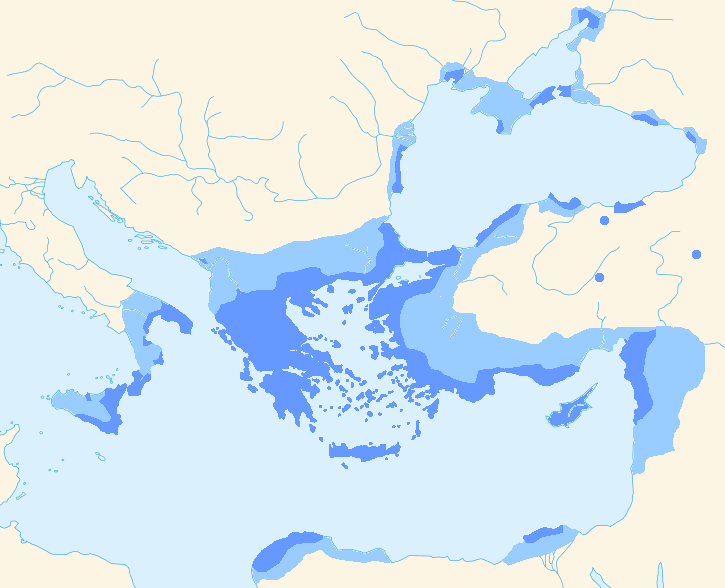 700 BCE – 415 CE (1,115 years, 2650-1535 BA): Ancient Greece was a civilization that flourished from Central Asia to the western end of the Mediterranean Sea. Included in ancient Greece is the period of Classical Greece, which flourished during the 5th to 4th centuries BCE. Classical Greece began with the repelling of a Persian invasion by Athenian leadership. Because of conquests by Alexander the Great of Macedonia, Hellenistic civilization flourished from Central Asia to the western end of the Mediterranean Sea. Classical Greek culture, especially philosophy, had a powerful influence on the Roman Empire, which carried a version of it to many parts of the Mediterranean Basin and Europe. For this reason Classical Greece is generally considered to be the seminal culture which provided the foundation of modern Western non-Christian culture and is considered as the cradle of Western civilization. Vestiges lingered, but the end of Classical Greek culture can be marked by the burning of the Library of Alexandria or death by mob of Hypatia in 415 CE.
700 BCE – 415 CE (1,115 years, 2650-1535 BA): Ancient Greece was a civilization that flourished from Central Asia to the western end of the Mediterranean Sea. Included in ancient Greece is the period of Classical Greece, which flourished during the 5th to 4th centuries BCE. Classical Greece began with the repelling of a Persian invasion by Athenian leadership. Because of conquests by Alexander the Great of Macedonia, Hellenistic civilization flourished from Central Asia to the western end of the Mediterranean Sea. Classical Greek culture, especially philosophy, had a powerful influence on the Roman Empire, which carried a version of it to many parts of the Mediterranean Basin and Europe. For this reason Classical Greece is generally considered to be the seminal culture which provided the foundation of modern Western non-Christian culture and is considered as the cradle of Western civilization. Vestiges lingered, but the end of Classical Greek culture can be marked by the burning of the Library of Alexandria or death by mob of Hypatia in 415 CE.
700 BCE – 700 CE (1,400 years, 2650-1250 BA): The Zapotec civilization was an indigenous pre-Columbian civilization that flourished in the Valley of Oaxaca in Mexico. The Zapotec left archaeological evidence at the ancient city of Monte Albán in the form of buildings, ball courts, magnificent tombs and grave goods including finely worked gold jewelry. Monte Albán was one of the first major cities in Mesoamerica and the center of a Zapotec state.
678–549 BCE (129 years, 2628-2499 BA): The Medes or Medean Empire, after having allied with the Babylonians to defeat the Neo-Assyrian Empire, the Medes were able to establish their own empire, which was the largest of its day.
626-539 BCE (87 years, 2576-2489 BA): Neo-Babylonian Empire (also Chaldean Empire). The period witnessed a general improvement in economic life and agricultural production, and a great flourishing of architectural projects, the arts and science. The Neo-Babylonian period ended when Cyrus the Great conquered the empire.
612 BCE-72 CE (540 years, 2562-1878 BA): Orontid Dynasty, a hereditary Armenian Dynasty and the rulers of the successor state to the Iron Age kingdom of Urartu. The Orontids established their supremacy over Armenia around the time of the Scythian and Median invasion in the 6th century BCE. It ends in 72 AD when it becomes part of the Roman Empire.
600 BCE to 200 CE (800 years, 2550-1750 BA): Scythia. Steppes of Central Asia to Southern Russia. They formed a loose kingdom called Scythia around 600 BC. Their kingdom lasted until 200 AD when they were defeated by the Sarmatians.
600– 345 BCE (265 years, 2550-2295 BA): Mahajanapadas, India. A set of sixteen kingdoms or oligarchic republics that began when the tribes of the late Vedic period decided to form their own territorial communities, which eventually gave rise to new and permanent areas of settlements as states. It saw the emergence of India's first large cities after the collapse of the Indus Valley Civilization.
600–150 BCE (450 years, 2550-2050 BA): Dong Hu tribal confederation, a tribal confederation of “Hu” nomadic people that was first recorded from the 7th century BCE and was conquered by the Xiongnu in 150 BCE.
550 BCE-1550 CE (2100 years, 2500-400 BA): Sao culture, a civilization that lived in Central Africa from the 6th century BCE to the 16th century AD. They occupied the Lake Chad basin and the Adamawa Plateau in Cameroon, and lived by the Chari River basin in territory that is now part of Cameroon and Chad. The Sao were Sudanic-speaking people who were made up of several patrilineal clans united into a single polity with one language, race, and religion. The city-states of the Sao reached their apex sometime between the ninth and fifteenth centuries CE, and cease to exist after the expansion of the Bornu Empire.
550–330 BCE (220 years, 2500-2280 BA): The Achaemenid Empire, also known as the first Persian Empire, covered Mesopotamia, Egypt, parts of Greece, Thrace, the Middle East, much of Central Asia, and Pakistan. It is considered the first great empire of Ancient History. It was overthrown and replaced by the short-lived empire of Alexander the Great. His Empire was succeeded by three Empires ruled by the Diadochi—the Seleucid, Ptolemaic, and Macedonian, which, despite being independent, are called the "Hellenistic Empire" by virtue of their similarities in culture and administration.
544 BCE-1162 CE (1,706 years, 2496-788 BA): Magadha Empire in eastern India. Following the invasion of India by Indo-European Ayarians after the collapse of the Indus Valley Harappan civilization, empire-building became the norm. Gautama Buddha lived much of his life in the kingdom of Magadha. The Magadha region hosted many nominal and actual empires. Some were empires in name but some were merely regime changes, so each and every empire will not be listed separately.
544–492 BCE (52 years): Haryanka Empire (Bimbisara Dynasty)
492–413 BCE (79 years): Udayin Empire (Udayin Dynasty)
413-344 BCE (79 years): Shishunaga Empire
344-321 BCE (23 years): Nanda Empire
321-185 BCE (136 years): Maurya Empire
185-75 BCE (110 years): Shunga Empire
75-30 BCE (45 years): Kanva Empire
30 BCE-320 CE (350 years): Satavahana Empire
321-550 CE (229 years): Gupta Empire
750-1162 CE (412 years): Pala Empire
500-BCE to 600 CE (1100 years, 2450-1150 BA): West Amazonia ‘Garden Urbanism’ culture, Sangay, Kilamope and Upano cultures, discovered by LiDAR, 6,000 earthworks in what is now eastern Ecuador. Corn based, three crops/year dispersed agrarian urban populations in 15 urban centers, houses and communal buildings, set amid vast tracts of carefully drained farmland and linked by a network of roads. A dispersed and extensive form of city compared to those in Eurasia. Decline from 300 - 600 BCE, no occupation for 200-600 years. After 200 years of environmental recovery, the Huapula culture began to move into the area to reuse remaining infrastructure, i.e. the Kilamope and Upano cultures collapsed to regional extinction.
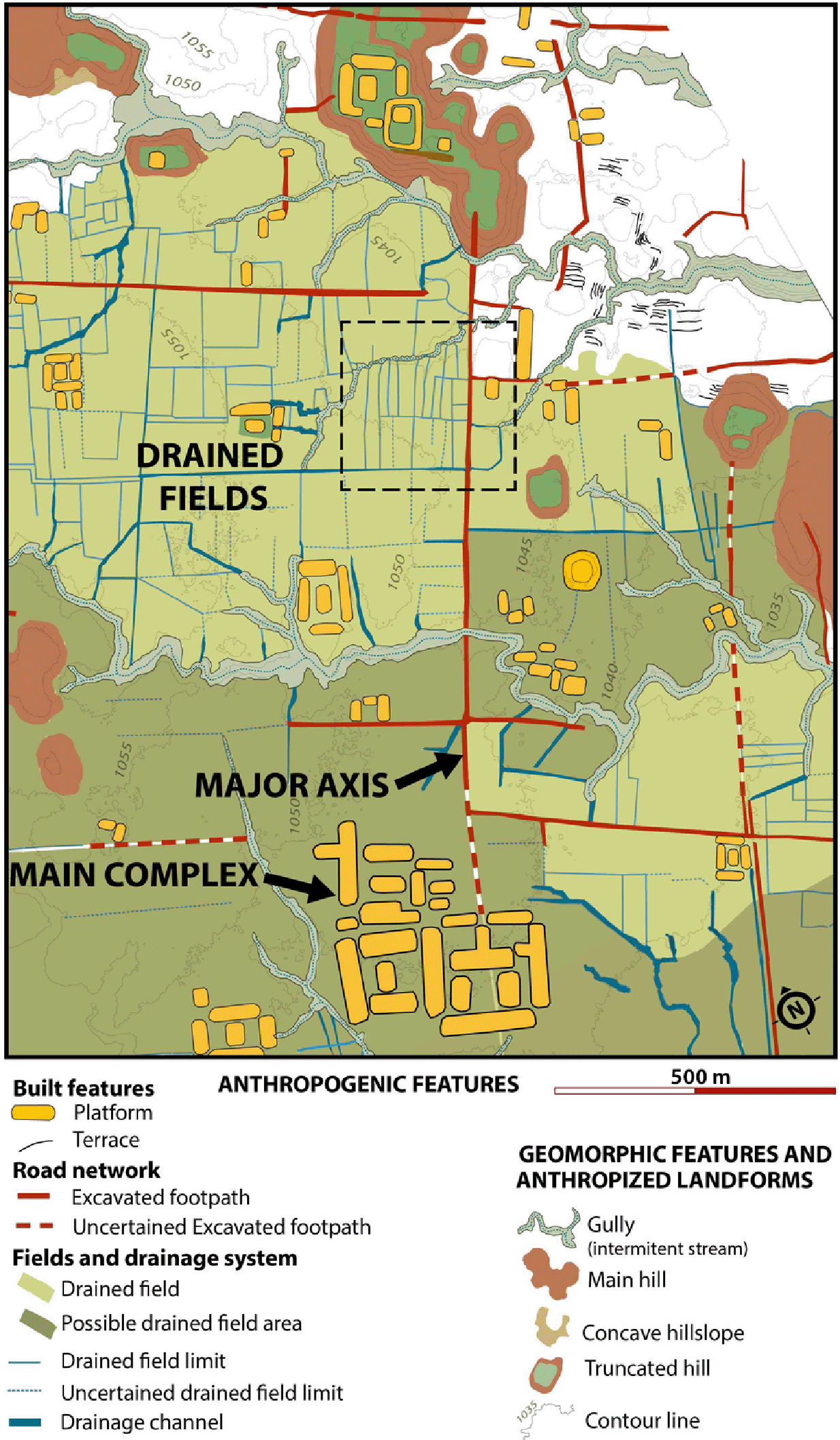
453-221 BCE (232 years, 2403-2171 BA): Warring States Period, Sino region. Different scholars point toward different dates ranging from 481 BC to 403 BC as the "true" beginning of the Warring States period. Scholars are divided into five schools of thought as to the true beginning of the Warring States era, and all are wrong as there was no one event/incident beginning the period. The Warring States era overlaps with the dissolution of the Zhou Dynasty when the king of Zhou ruled merely as a figurehead during descent.
Over 100 smaller states, who had been "united" by conquest under the Zhou Dynasty, contended for dominance and were in due time assimilated/subsumed/consolidated by conquest into seven major states large enough to contend with one another. This was the period of Zhuangzi and the Hundred Schools of Thought, of which all but one sought to serve their state (e.g. Confucius and Mencius).
What once looked like a near consensus narrative to the Western mind (that growth is good—in the 20th century global academics were mostly singing the same song, the one of the globalizing monetary culture of the Modern Techno-industrial socioeconomic-political world system whose bread they ate) is now fragmenting into another ideological battle ground within which another Hundred (to Thousands) of Schools of Thought are and will increasingly contend to see which can deny that they are wrong the longest. Laozi may have lived in the early Warring States period or the dissolution preceding it. This period may resemble the dissolution of the Euro-Sino Empire in the 21st century, but without a global reunification. O Laozi/Zhuangzi, the voices not serving empire, where art thou?
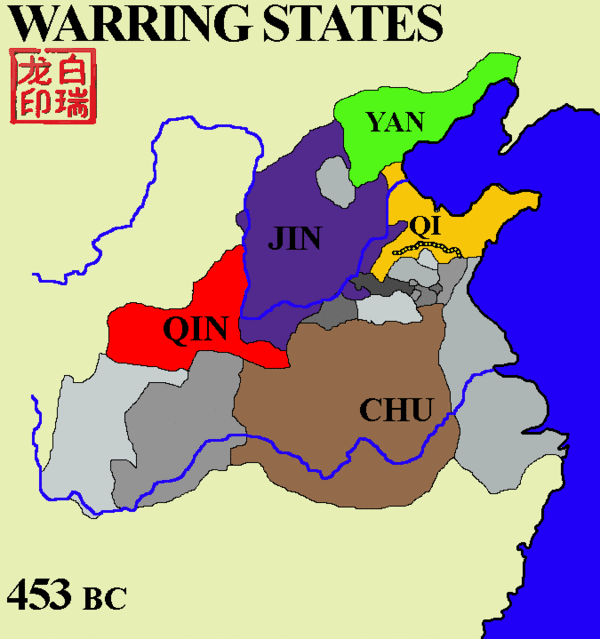
323-31 BCE (292 years, 2273-1986 BA): Hellenist Period, Greece. Starts with the death of Alexander the Great in 323 BC and ends with the conquest by the Roman Empire as signified by the Battle of Actium in 31 BCE and fall of the Ptolemaic Kingdom in 30 BCE. At this time, Greek cultural influence and power was at its peak in Europe, North Africa and Western Asia, experiencing prosperity and progress in the arts, exploration, literature, theatre, architecture, music, mathematics, philosophy, and science (for a time).
321–185 BCE (136 years, 2271-2135 BA): Maurya Empire, in India during the Axial Age appeared a geographically extensive and powerful empire, ruled by the Mauryan Dynasty. The empire rapidly expanded westward across central and western India, taking advantage of the disruptions of local powers following the withdrawal by Alexander the Great. By 320 BC, the Maurya Empire had fully occupied northwestern India as well as defeating and conquering the satraps left by Alexander. Under Emperor Asoka the Great, the Maurya Empire became the first Indian empire to conquer all of the Indian Peninsula—an achievement repeated only twice, by the Gupta and Mughal Empires. In the reign of Asoka Buddhism spread to become the dominant religion in ancient India. It has been estimated that the Maurya Dynasty controlled an unprecedented one-third of the world's entire economy, was home to one-third of the world's population at the time (an estimated 50 million out of 150 million humans), contained the world's largest city of the time (Pataliputra, estimated to be larger than Rome under Emperor Trajan) and according to Megasthenes, the empire wielded a military of 600,000 infantry, 30,000 cavalry, and 9,000 war elephants.
331 BCE to 428 CE (442 years, 2271-1522 BA): Kingdom of Armenia. Originally inhabited by Proto-Armenian tribes which committed empire on the chiefdom level before becoming a unitary state or nation. The highlands were first united by tribes in the vicinity of Lake Van into the Kingdom of Van. The kingdom competed with Assyria over supremacy in the highlands of Ararat and the Fertile Crescent. The Armenian kingdom was the first state to embrace Christianity officially. Ideological belief-based systems compete for minds instead of energy and material resources.
312–63 BCE (249 years, 2269-2013 BA): The Seleucid Empire was a Hellenistic state ruled by the Seleucid Dynasty. It was founded by Seleucus I Nicator following the division of the Macedonian empire vastly expanded by Alexander the Great.
305–30 BC (275 years, 2255-1980 BA): Ptolemaic Kingdom, Egypt. Started with Ptolemy I Soter who declared himself pharaoh of Egypt and created a powerful Macedonian Greek Dynasty after the death of Alexander the Great in 323 BC and which ended with the death of Cleopatra and the Roman conquest in 30 BC.
300s BCE–1279 CE (1,570 years, 2250-671 BA): Chola Dynasty, India, one of the longest-ruling dynasties in history. The Chola fleet represented the zenith of ancient Indian sea power.
281 BCE–62 CE (343 years, 2231-1888 BA): Pontic (Pontus) Empire, kingdom was proclaimed by Mithridates I in 281 BCE and lasted until its conquest by the Roman Republic in 63 CE. The Kingdom of Pontus reached its largest extent under Mithridates VI the Great, who conquered Colchis, Cappadocia, Bithynia, the Greek colonies of the Tauric Chersonesos, and for a brief time the Roman province of Asia. After a long struggle with Rome in the Mithridatic Wars, Pontus was defeated. The western part of it was incorporated into the Roman Republic as the province Bithynia et Pontus; the eastern half survived as a client kingdom until 62 AD.
256–125 BCE (131 years, 2206-2075 BA): Greco-Bactrian Kingdom, north of present-day Afghanistan. Formed when it seceded from the Seleucid Empire. Highly expansionistic in strength, weakened by excess, Bactria was invaded by nomadic tribes from the North and destroyed not unlike Rome was later to be.
247 BCE – 224 CE (445 years, 2197-1726 BA): Parthian Empire, also known as the Arsacid Empire, was a major Iranian political and cultural power in ancient Iran and Iraq.
230 BCE-220 CE (450 years, 2180-1730): Satavahana Empire, an ancient Indian Brahmin dynasty based in the Deccan region. The Satavahanas were early issuers of Indian state coinage struck with images of their rulers. They formed a cultural bridge and played a vital role in trade and the transfer of ideas and culture to and from the Indo-Gangetic Plain to the southern tip of India. The dynasty was extinguished following the rise of its feudatories, perhaps on account of a decline in central power.
221–207 BCE (14 years, 2171-2157 BA): Qin Dynasty in China, the era of the Warring States ended with the universal conquest of Qin. The King of Qin, Ying Zheng, became China's First Emperor and began the pattern of successive dynasties. Ying Zheng connected all the existing defense walls of northern China into what is known today as the Great Wall of China which marked the northern frontier of China. The Qin Dynasty was short lived and in 207 BCE was overthrown by the Han Dynasty.
209-25 BCE (184 years, 2159-1975 BA): Xiongnu Empire, China. A tribal confederation of nomadic peoples who, according to ancient Chinese sources, inhabited the eastern Eurasian Steppe. After their previous overlords migrated into Central Asia during the 2nd century BC, the Xiongnu became a dominant power on the steppes of north-east Central Asia later called Mongolia.
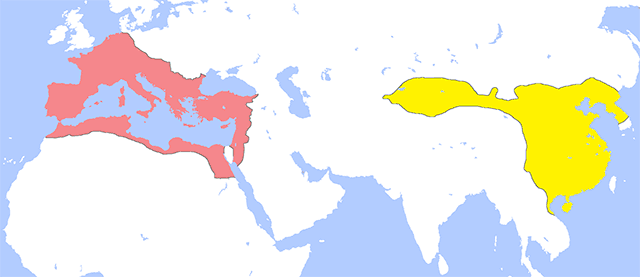 207 BCE – 220 CE (457 years, 2157-1730 BA): Han Dynasty became one of East Asia's most long-lived dynasties. In the Second century CE the Han Empire expanded into Central Asia. By this time only three Empires stretched between the Pacific and the Atlantic—China, Parthia, and Rome. The Roman Empire came later, but existed during the Han Empire, lasting not quite as long.
207 BCE – 220 CE (457 years, 2157-1730 BA): Han Dynasty became one of East Asia's most long-lived dynasties. In the Second century CE the Han Empire expanded into Central Asia. By this time only three Empires stretched between the Pacific and the Atlantic—China, Parthia, and Rome. The Roman Empire came later, but existed during the Han Empire, lasting not quite as long.
202-40 BCE (162 years, 2152-1990 BA): Numidia, North Africa. It is considered to be one of the first major states in the history of Algeria and the Berber world. After the death of the last king, Numidia became the Roman province.
200 BCE to 200 CE (400 years, 2150-1700 BA): Chera Dynasty, India. The Chera people of southern India owed their importance to exchange of spices, especially black pepper, with Middle Eastern and Graeco-Roman merchants.
185–75 BCE (110 years, 2135-2025 BA): Shunga Empire, eastern India, noted for its numerous wars with both foreign and indigenous powers. The dynasty rapidly discorporated after the death of its second king.
100 BCE – 800 CE (900 years, 2050-1100 BA): The Nazca culture (also Nasca) was the archaeological culture that flourished from beside the arid, southern coast of Peru in the river valleys of the Rio Grande de Nazca drainage and the Ica Valley. The Nazca produced an array of crafts and technologies such as ceramics, textiles, and geoglyphs—specifically the Nazca Lines. They also built an impressive system of underground aqueducts, known as puquios, that still function today. From 500 CE, the civilization started to decline and by 750 CE the civilization had fallen completely. This is thought to have occurred when an El Niño triggered widespread and destructive flooding. Evidence also suggests that the Nazca people may have exacerbated the effects of these floods by gradually cutting down trees to make room for maize and cotton agriculture. These trees play an extremely important role as the ecological keystone of this landscape: in particular preventing river and wind erosion. Gradual removal of trees would have exposed the landscape to the effects of climate perturbations such as El Niño, leading to erosion and failure of irrigation systems.
100 BCE-550 CE (650 years, 2050-1400 BA): Teotihuacan, central Mexico. Teotihuacan was the largest city in the pre-Columbian Americas, with a population estimated at 125,000 or more, making it the sixth largest city in the world during its epoch. Its major monuments were sacked and systematically burned around 550 CE.
100 BCE – 900 CE: (1000 years, 2050-1050 BA): The Quimbaya civilization was a South American civilization in Columbia, noted for spectacular gold work characterized by technical accuracy and detailed designs. The Quimbaya reached their zenith during the 4th to 7th century CE period. Around the 10th century the Quimbaya culture disappeared entirely due to unknown circumstances.
100 BCE-c. 200 CE (300 years, 2050-1750 BA): Satavahana Dynasty, India. They conquered predecessors and the kingdom fragmented into smaller states by the early 3rd century CE.
75-30 BCE (45 years, 2025-1980 BA): Kanva Empire, eastern India. The last ruler of the Shunga Dynasty was overthrown by his minister who founded the Kanva Dynasty in 75 BC, so more of a regime change than a new empire as was the Satavahana Empire that followed.
57 BCE-668 CE (725 years, 2007-1282 BA): Three Kingdoms of Korea, The three kingdoms occupied the entire Korean Peninsula and most of Manchuria. Frequent warfare, here as elsewhere, played a major role in the development of peninsular states.
57 BCE — 935 CE (992 years, 2007-1015 BA): Silla, Kingdom of, 57 BCE — 935 CE, a Korean kingdom located on the southern and central parts of the Korean Peninsula. Silla, along with Baekje and Goguryeo, formed the Three Kingdoms of Korea. Silla had the lowest population of approximately 850,000 people (170,000 households), which was significantly smaller than those of Baekje (3,800,000 people) and Goguryeo (3,500,000 people). After nearly 1,000 years of rule, Silla fragmented into the brief Later Three Kingdoms of Silla, Later Baekje, and Taebong, handing over power to Goryeo in 935.
37 BCE - 668 CE (705 years, 1987-1282 BA): Goguryeo Kingdom, a Korean kingdom, one of the three, located in the northern and central parts of the Korean Peninsula and the southern and central parts of modern day Northeast China. At its peak of power, Goguryeo controlled most of the Korean Peninsula, large parts of Manchuria and parts of eastern Mongolia and Inner Mongolia as well as Russia. It was an active participant in the power struggle for control of the Korean peninsula and was also associated with the foreign affairs of neighboring polities in China and Japan. Internal strife (531 to 551) lead to wars and decline, and a Chinese army invaded, ending the Kingdom in 668.
27 BCE – 395 CE (422 years, 1977-1555 BA): The Imperial Roman Empire was the first nation to invent and embody the concept of empire in their two mandates: to wage war and to make and execute laws. They were the most extensive Western empire until the early modern period, and left a lasting impact on Western Europe. The empire split in 395 CE and the Western Roman Empire fell in 476 CE. Many languages, cultural values, religious institutions, political divisions, urban centers, and legal systems can trace their origins to the Roman Empire. The Roman Empire governed and rested on exploitative actions, but for two hundred years they didn't have to conquer anyone (Pax Romana). They took slaves and money from the peripheries to support the imperial center. However, the absolute reliance on conquered peoples to carry out the empire's fortune, sustain wealth, and fight wars would ultimately lead to the collapse of the Roman Empire. The Romans were strong believers in what they called their "civilizing mission". This term was legitimized and justified by writers like Cicero who wrote that only under Roman rule could the world flourish and prosper. This ideology, that was envisioned to bring a new world order, was eventually spread across the Mediterranean world and beyond. People started to build houses like Romans, eat the same food, wear the same clothes and engage in the same cruel games. Even rights of citizenship and authority to rule were granted to people not of Roman or Italian birth. This authority given to people outside of Roman culture is an example of how its empire collapsed, with a strong dependence on "foreign" rulers.
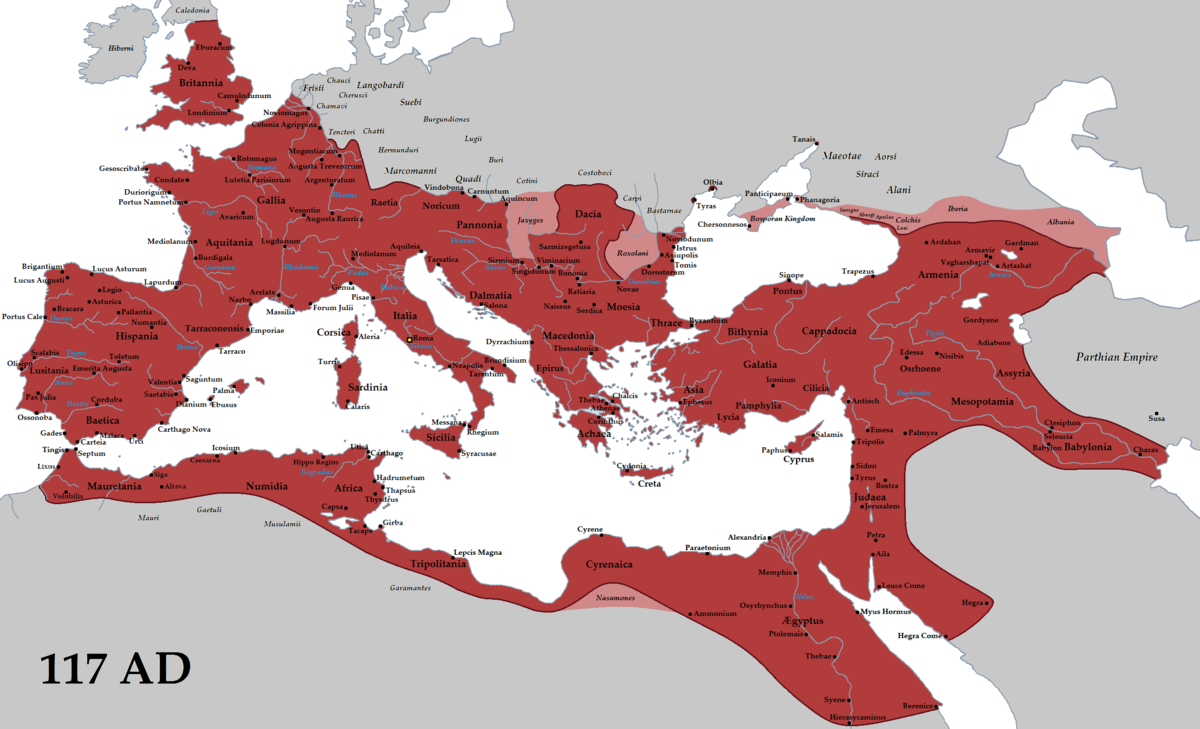
18 BCE–660 CE (678 years, 1968-1290 BA): Baekje (Paekche) Kingdom, a Korean kingdom, one of the Three Kindoms, located in southwestern Korea. It was one of the Three Kingdoms of Korea, together with Goguryeo and Silla. While the three kingdoms were in separate existence, Baekje had the highest population of approximately 3,800,000 people (760,000 households), which was similar to that of Goguryeo (3,500,000 people) and much larger than that of Silla (850,000 people).
0
19–226 CE (208 years, 1932-1724 BA): Indo-Parthian Kingdom, ruled an area covering parts of eastern Iran, various parts of Afghanistan and the northwest regions of the Indian subcontinent (most of modern Pakistan and parts of northwestern India). The rulers may have been members of the House of Suren, and the kingdom has even been called the “Suren Kingdom” by some authors. The governor declared independence from the Parthian Empire, leading expeditions to the east, conquering territory from the Indo-Scythians and Indo-Greeks, thus transforming the kingdom into an empire. Conquest by the Sasanian Empire.
30–375 CE (205 years, 1920-1575 BA): Kushan Empire, spread to encompass much of Afghanistan and then the northern parts of the Indian subcontinent. The Kushan Dynasty had diplomatic contacts with the Roman Empire, Sasanian Persia, the Aksumite Empire and the Han Dynasty of China. While much philosophy, art, and science was created within its borders, the only textual record of the empire's history today comes from inscriptions and accounts in other languages, particularly Chinese.
35–415 CE (380 years, 1915-1535 BA): Western Satrap (Western Kshatrapa) Kingdom, were Indo-Scythian (Saka) rulers of the western and central parts of India (extending from Saurashtra in the south and Malwa in the east, covering modern-day Sindh, Gujarat, Maharashtra, Rajasthan and Madhya Pradesh states), between 35 and 415 CE. Called “Western Satraps” in modern historiography in order to differentiate them from the “Northern Satraps”, who ruled in Punjab and Mathura until the 2nd century CE. The Western Satraps, having been defeated by the Abhiras/Ahirs, declined rapidly during the second half of the third century.
50–1650 CE (1,160 years, 1900-300 BA): Tairona civilization was a group of chiefdoms in the region of Sierra Nevada de Santa Marta, Colombia, South America, which goes back at least to the 1st century CE and had significant demographic growth around the 11th century. In the post population peak recovery, the Tairona 3 phase, the Tairona lived sustainably until all Taironans, except the highland Kogi, were eliminated by determined Spanish efforts at genocide (1600–1650 CE). A remnant population, the Kogi, retain an intact culture and complex society, the only one to have resisted assimilation into the industrial society collective.
68–550 CE (482 years, 1832-1400 BA): Funan, Kingdom of, an ancient Indianized state — or, rather a loose network of states (Mandala) — located in mainland Southeast Asia centered on the Mekong Delta. Extensive human settlement in the region may go back as far as the 4th century BCE. Funan may have been a collection of city-states that sometimes warred with one another and at other times constituted a political unity. The Funanese established a strong system of mercantilism and commercial monopolies that would become a pattern for empires in the region. Funan was superseded and absorbed in the 6th century by the Khmer polity.
100–800 CE (700 years, 1850-1150 BA): The Moche or Mochica culture, Early Chimu flourished in northern Peru with its capital near present-day Moche and Trujillo. They were likely a group of autonomous polities that shared a common elite culture, as seen in the rich iconography and monumental architecture that survived. Moche history may be broadly divided into three periods – the emergence of the Moche culture in Early Moche (100–300 CE), its expansion and florescence during Middle Moche (300–600 CE), and the urban nucleation and subsequent collapse in Late Moche (500–750 CE). The defensive works suggest social unrest, possibly the result of climatic changes, as factions fought for control over increasingly scarce resources.
100 – c. 940 CE (840 years, 1850-1010 BA) Aksumite Empire, Kingdom of Aksum also known as the Kingdom of Axum, northern Ethiopia. Emperors were powerful sovereigns, styling themselves as King of kings, and became a major player on the commercial trade route between the Roman Empire and Ancient India.
100–650 CE (550 years, 1850-1300 BA): The Lima culture was an indigenous civilization which existed in modern-day Lima, Peru. This pre-Incan culture, which overlaps with surrounding Paracas, Moche, and Nazca civilizations, was located in the desert coastal strip of Peru. Starting around 600, climatic and environmental changes in the Andean region were brought about by cycles of droughts and El Niño phenomenon. The Lima underwent radical reorganizations and shifting populations in order to compensate for the change in rainfall and water availability. Lima culture was steadily disbanded, and new culture groups developed and dominated Coastal Peru.
150 BCE–400 CE (250 years, 1800-820 BA): Indo-Scythian (Saka) Kingdom, a group of nomadic Iranian peoples of Scythian origin who migrated from Central Asia southward into the northwestern Indian subcontinent, precisely into the modern-day South Asian regions of Afghanistan, Pakistan and northern India. The migrations persisted from the middle of the 2nd century BCE to the 4th century CE. The Indo-Scythians extended their supremacy over north-western subcontinent, conquering the Indo-Greeks and other local kingdoms. The Indo-Scythians were apparently subjugated by the Kushan Empire.
200–1130 CE (930 years, 1750-820 BA): Mimbres culture, Southwest USA culture known only by pottery style/ruins. Pottery production ended 1130 CE suggesting collapse of complex society. Some farming persisted in a declining population to 1450 CE when all agriculture in the region ended.
220–1911 CE (1691 years, 1730-39 BA): Imperial China: May be considered to include Han dynasty that ended in 220. Han dark age, 220–c.580; Sui, Tang, and Five dynasties periods, c.581–960; Song dynasty period, 960–1279; Yuan dynasty period, 1279–1368; Ming dynasty period, 1368–1644; Qing or Manchu dynasty period, 1636–1911.
224–651 CE (427 years, 1726-1299 BA): Sasanian Empire, also called the "Empire of Empires," was the last Iranian empire before the rise of Islam.
250–900 CE (650 years, 1700-1050 BA): Mayan Classic period is largely defined as the period during which the lowland Maya raised dated monuments using the Long Count calendar. This period marked the peak of large-scale construction and urbanism, the recording of monumental inscriptions, and demonstrated significant intellectual and artistic development, particularly in the southern lowland regions. The Classic period Maya political landscape has been likened to that of Renaissance Italy or Classical Greece, with multiple city-states engaged in a complex network of alliances and enmities.
300 and 1500 CE (1200 years, 1650-450 BA): The Hohokam was a culture in the North American Southwest in what is now part of Arizona, United States, and Sonora, Mexico. Extensive canals supported agriculture and a large population, for a time, and was the most complex in the pre-contact north of Mesoamerica. It had collapsed prior to Spanish conquest, but after the Pueblo collapse, some of whom emigrated to Hohokam territory and persisted for a time before being assemilated into Hohokam culture or otherwise failing to persist.
319–c. 550 CE (231 years, 1669-1400 BA): Gupta Empire, an ancient Indian empire. At its zenith, from approximately 319 to 467 CE, it covered much of the Indian subcontinent. This period has been considered as the Golden Age of India by some historians, although this characterisation has been disputed by other historians. The ruling dynasty of the empire was founded by Gupta. The 5th-century CE Sanskrit poet Kalidasa credits the Guptas with having conquered about twenty-one kingdoms, both in and outside India. Decline and Hun invasion, disestablished 550.
320–550 CE (230 years, 1630-1400 BA): The Gupta Empire was an ancient Indian empire, founded by Sri Gupta, and covered much of the Indian subcontinent.
330–555 CE (225 years, 1620-1395 BA): Rouran (Juan Juan) Khaganate, a tribal confederation and later state founded by a people of Proto-Mongolic Donghu origin. The Rouran supreme rulers used the title of “khagan”, a popular title borrowed from the Xianbei. The Rouran Khaganate lasted from the late 4th century until the middle 6th century, when they were defeated by a Göktürk rebellion at the peak of their power, which subsequently led to the rise of the Turks in world history.
330–1453 CE (1,123 years, 1620-497 BA): Byzantine Empire, Eastern Roman remnant of empire persisted by intentionally reducing complexity, scaling back to avoid, for a time, collapse. The weakening, slowly declining Byzantine Empire, fell to the expanding Islamic Caliphate. Some scholars and their books were able to emigrate to Europe to join the rebirth of learning that served expanding empires.
370–469 CE (99 years, 1580-1481 BA): Huns, pastoral nomadic people who lived in Central Asia, the Caucasus, and Eastern Europe. The Huns established a vast, if short-lived, dominion in Europe, conquering the Goths and many other Germanic peoples living outside of Roman borders, and causing many others to flee into Roman territory. The Huns, especially under their King Attila, made frequent and devastating raids into the Eastern Roman Empire. In 451, the Huns invaded the Western Roman province of Gaul, where they fought a combined army of Romans and Visigoths, and in 452 they invaded Italy. After Attila's death in 453, the Huns ceased to be a major threat to Rome and lost much of their empire.
418–c. 720 CE (302 years-, 1532-1230 BA): Visigothic Kingdom, occupied what is now southwestern France and the Iberian Peninsula. The Visigoths were romanized central Europeans who had moved west from the Danube Valley. When Western Roman Empire fell in 476 AD, the Visigoths believed they had the right to take the territories that Rome had promised in Hispania in exchange for attempting to restore the Roman order. By 716, most of the Iberian Peninsula was under Islamic rule.
435–534 CE (99 years-, 1515-1416 BA): Vandals, Kingdom of the, a confederation of Vandals and Alans, which is one of the barbarian kingdoms established under Gaiseric, a Vandal warrior. It ruled in North Africa and the Mediterranean from 435 to 534 AD. In 429 AD, the Vandals, estimated to number 80,000 people, had crossed by boat from Hispania to North Africa. They advanced eastward, conquering the coastal regions of what is now Tunisia, and Algeria. In 435, the Western Roman Empire, then ruling North Africa, allowed the Vandals to settle in the provinces of Numidia and Mauretania when it became clear that the Vandal army could not be defeated by Roman military forces. In 439 the Vandals renewed their advance eastward and captured Carthage, the most important city of North Africa. The fledgling kingdom then conquered the Roman-ruled islands of Mallorca, Sicily, Sardinia, and Corsica in the western Mediterranean. In the 460s, the Romans launched two unsuccessful military expeditions by sea in an attempt to overthrow the Vandals and reclaim North Africa. The conquest of North Africa by the Vandals was a blow to the beleaguered Western Roman Empire as North Africa was a major source of revenue and a supplier of grain (mostly wheat) to the city of Rome. The Vandal Kingdom ended in 534, when it was conquered by Belisarius in the Vandalic War and incorporated into the Eastern Roman Empire (or Byzantine Empire). The surviving Vandals either assimilated into the indigenous African population or were dispersed among the Byzantine territories.
440s–560 CE (120 years, 1510-1390 BA): Hephthalites or Whte Huns, were a people of Central Asia who were militarily important circa 450–560. They were based in Bactria and expanded east to the Tarim Basin, west to Sogdia and south through Afghanistan to northern India. They were a tribal confederation and included both nomadic and settled urban communities. They have often been linked to the Huns who invaded Eastern Europe during the same period, and/or have been referred to as "Huns", but there is no consensus among scholars about such a connection. The Imperial Hephthalites were militarily important from 450 CE when they defeated the Kidarites, to 560 CE, when combined forces from the First Turkic Khaganate and the Sasanian Empire defeated them.
476 CE (to present, 1474 BA to present): Euro-Sino Empire, Euro beginnings after fall of Western Roman Empire as empire of belief before becoming a multiplicity of about 300 feudal societies/principalities by 1495, some becoming maritime powers, who transitioned from wood to fossil fuels to become the first industrial global empire which climaxed in the Sino region. Did 'you' begin as a fertilized ovum, a newborn, or as an adult? An alternative beginning date, 0 BA/AA, is 1950 CE as that is when the global growth economy dramatically accelerated and when all prior empires, apart from a few outliers such as North Korea, had been fully assimilated, resistance as nation-states having proved futile.
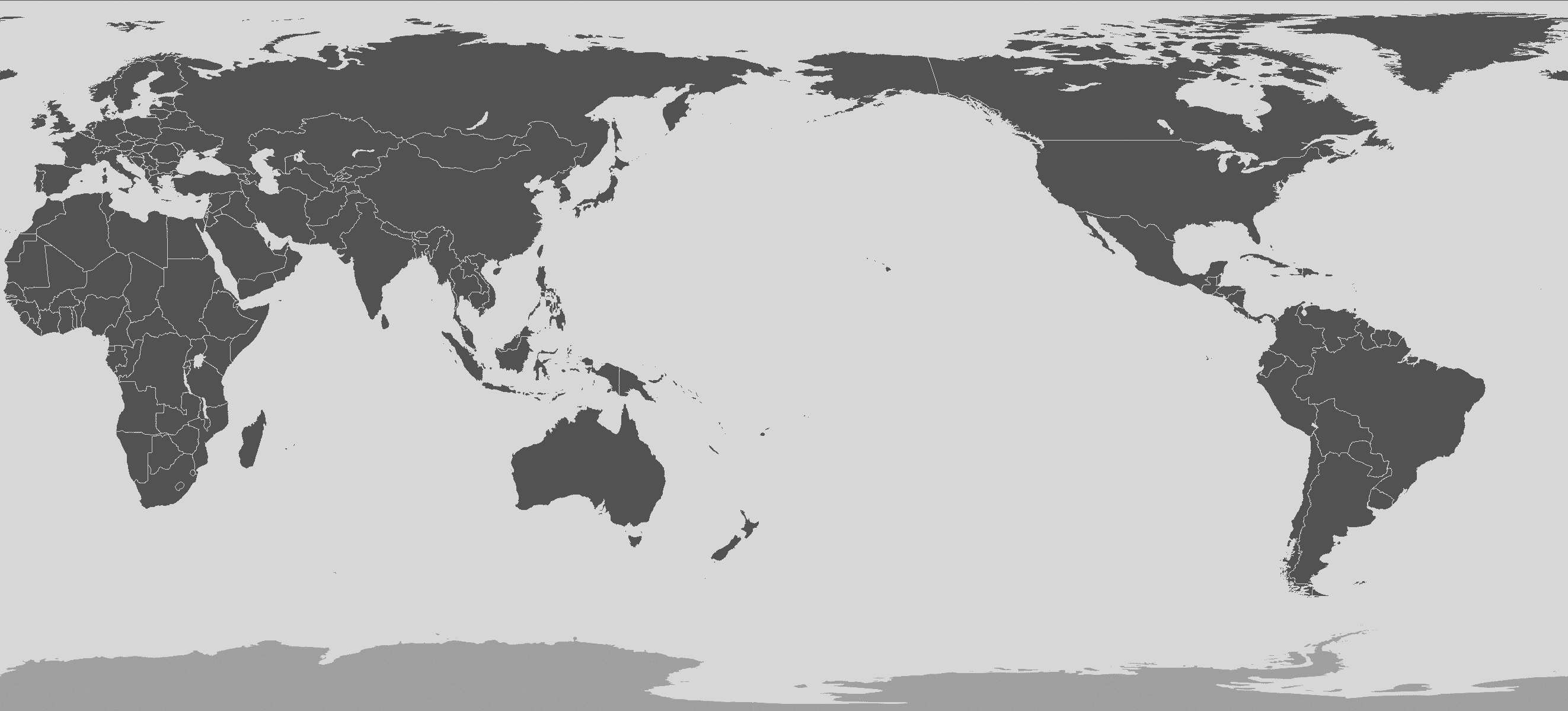

500–1000 CE (500 years, 1450-950 BA): The Wari flourished in the south-central Andes and coastal area of modern-day Peru. The Wari culture began to deteriorate around 800 CE. Archaeologists have determined that the city of Wari was dramatically depopulated by 1000 CE. Archaeological evidence shows significant levels of interpersonal violence, suggesting that warfare and raiding increased amongst rival groups upon the collapse of the Wari state structure.
500–1400 CE (900 years, 1450-550 BA): The Casarabe culture built a low-density urban system that included straight, raised causeways running for several kilometers (sustainability enthusiasts who dream of all humanity living in ecovillages to become like the Casarabe cite a 1542 Spanish confabulous report of '30 legues', or 165 km, of 'very fine highways' connecting 'very large cities that glistened in white', but note the dates of the rise and fall of the Casarabe empire), canals and reservoirs. Such low-density urban sprawl from pre-Columbian times was previously unknown in the Amazon or anywhere else in South America. They were maize farmers and hunter/fisher foragers. The lidar data has revealed 26 sites. Beginning about 1250 CE other complex low-density development arose along the Southern Rim Area of the Amazon. The pattern was repeated. The Casarabe endgame may have resulted in a wave of migrants spreading out (auto-organizing a marauding horde culture). Outliers fortified their settlements, but by 1500 CE all complex societies in the Southern Rim Region experienced a Darker Age without recovery (confabulists note that as regional collapse ended about 1500, 8 years after Columbus sailed to the Caribbean, that Old World diseases caused the collapse and caused the dying people to build extensive fortifications in the 15th century after abandonment of the Casarabe region by 1400). As migrants spread, as the Land (and Sea) Peoples of the Late Bronze Age Collapse did, settlements fall and some survivors join the marauding horde culture, increasing their numbers, who move on to repeat the pattern over multiple generations until they can't. The indigenous did not live in large cities sustainably glistening in white and neither will those who imagine posterity will if 8 billion people (or 10.4 billion as projected for 2086) would just choose to live in ecovillages like the Casarabe did before the Spanish conquest.
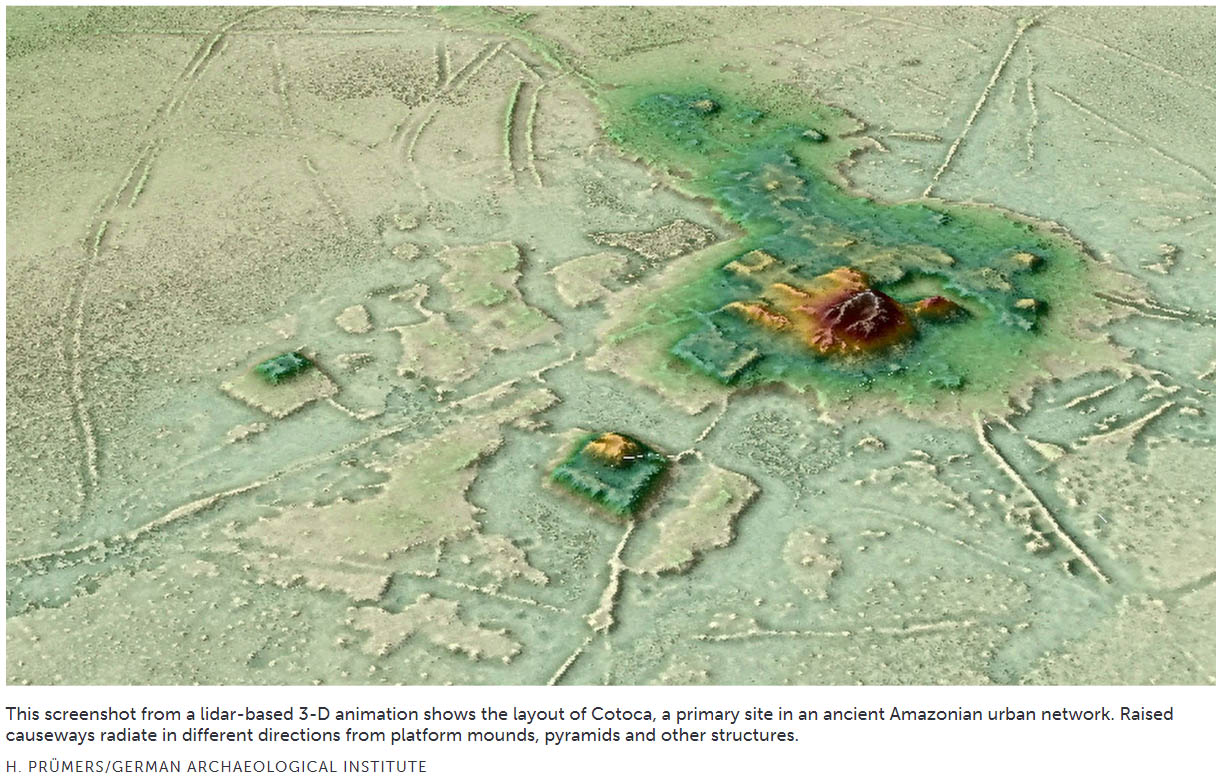
539–1218 CE (679 years, 1411-732 BA):Kyrgyz Khaganate, the khaganate’s territory at its height would briefly include parts of modern-day China, Kazakhstan, Kyrgyzstan, Mongolia, and Russia. After the 10th century, there was little information on the Yenisei Kyrgyz.
567– after 822 CE (255 years, 1383-1128 BA): Avar Khaganate, the Pannonian Avars were an alliance of several groups of Eurasian nomads of various origins. They established the Avar Khaganate, which spanned the Pannonian Basin and considerable areas of Central and Eastern Europe from the late 6th to the early 9th century.
568–774 CE (206 years, 1382-1176 BA): Lombard Kingdom, was an early medieval state established by the Lombards, a Germanic people, on the Italian Peninsula. The king was traditionally elected by the very highest-ranking aristocrats, the dukes, as several attempts to establish a hereditary dynasty failed. The kingdom was subdivided into a varying number of duchies, ruled by semi-autonomous dukes, which were in turn subdivided into gastaldates at the municipal level. The capital of the kingdom and the center of its political life was Pavia in the modern northern Italian region of Lombardy. Over time, the Lombards gradually adopted Roman titles, names, and traditions. Initially the Lombards were Arian Christians or pagans, which put them at odds with the Roman population as well as the Byzantine Empire and the Pope. However, by the end of the 7th century, their conversion to Catholicism was all but complete. Nevertheless, their conflict with the Pope continued and was responsible for their gradual loss of power to the Franks, who conquered the kingdom in 774.
581–657 CE (76 years, 1369-1293 BA): Western Turkic Khaganate or Onoq Khaganate was a Turkic khaganate formed as a result of the wars in the beginning of the 7th century after the split of the Göktürk Khaganate (founded in the 6th century in Mongolia by the Ashina clan) into the Western khaganate and the Eastern Turkic Khaganate.The Western Turkic Khaganate was subjugated by the Tang Empire in 657
600–1300 CE (700 years, 1350-650 BA): Cahokia was the largest and the most influential urban settlement in the Mississippian culture which developed advanced societies across much of what is now the central and southeastern United States, beginning more than 1000 years before European contact. Cahokia's population, peak estimate 40,000, began to decline during the thirteenth century, and then was abandoned post collapse.
600–1600 CE (1,000 years, 1350-350 BA): The Muisca (or Chibcha) civilization flourished in ancient Colombia. The Muisca Confederation 1450–1537 CE (87 years) was a rather loose confederation of different Muisca chiefdoms in the central Andean highlands of present-day Colombia. Population between 300,000 and two million people, one of four advanced civilizations of the Americas (apart from the Aztec, Mayans and Incas. They were developing writing. They were advanced but not war-like, there was no absolute monarch, nor was it an empire-as-usual, because it did not dominate other ethnic groups or peoples. The chiefdoms were united by an empire of belief, a priest class who, unlike monarchs and military rulers, neglected to indulge in vast monument building. The shared military force was for defense, not conquest. Defeated by Spanish conquistadors who encountered them in 1537 and conqued them by 1542.
600–1000 CE (400 years, 1350-950 BA): Tiwanaku (Tiahuanaco) culture, a Pre-Columbian polity in western Bolivia based in the southern Lake Titicaca Basin. Tiwanaku was one of the most significant Andean civilizations. Its influence extended into present-day Peru and Chile. Its capital was the monumental city of Tiwanaku, located at the center of the polity’s core area in the southern Lake Titicaca Basin. This area has clear evidence for large-scale agricultural production on raised fields that probably supported the urban population of the capital. Researchers debate whether these fields were administered by a bureaucratic state (top-down) or through a federation of communities with local autonomy (bottom-up). Tiwanaku was once thought to be an expansive military empire, based mostly on comparisons to the later Inca Empire. However, recent research suggests that labelling Tiwanaku as an empire or even a state may be misleading. Tiwanaku is missing a number of features traditionally used to define archaic states and empires: there is no defensive architecture at any Tiwanaku site or changes in weapon technology, there are no princely burials or other evidence of a ruling dynasty or a formal social hierarchy, no evidence of state-maintained roads or outposts, and no markets. Tiwanaku was a multi-cultural network of powerful lineages that brought people together to build large monuments. Tiwanaku grew into the Andes’ most important pilgrimage destination and one of the continent’s largest Pre-Columbian cities, reaching a maximum population of 10,000 to 20,000 around 800 CE. Around 1000 AD, Tiwanaku ceramics stopped being produced as the state’s largest colony (Moquegua) and the urban core of the capital were abandoned within a few decades. One theory of collapse is that internal social dynamics led to Tiwanaku’s demise. Some areas of the capital show signs of intentional destruction, though this could have taken place at any time. Monolithic gates, like Gateway of the Sun, were tipped over and broken. By the end of Tiwanaku V period the Putuni complex was burned and food storage jars smashed. This indicates an event of destruction, followed by abandonment of the site. Colonies in Moquegua and on Isla del Sol were also abandoned around this time. Dispersing remnant populations in search of new suitable environments might have caused long-distance ripple effects of both migration and technological diffusion across the south-central and south Andes between c. 1100 to 1300 CE.
606 -647 CE (41 years, 1344-1303 BA): Harsha Empire, a one emperor empire who ruled northern India. He was the son of Prabhakaravardhana who had defeated the Alchon Hun invaders. At the height of Harsha’s power, his realm covered much of northern and northwestern India. Harsha was defeated by the Emperor Pulakeshin II when he tried to expand his empire into the southern peninsula of India.
618–907 CE (289 years, 1332-1043 BA): In East Asia, various Celestial Empires arose periodically between periods of war, civil war, and foreign conquests. The greatest of them was the Tang Empire.
618–842/848 CE (230 years, 1332-1102 BA): Tibetan Empire, an empire centered on the Tibetan Plateau, formed as a result of imperial expansion under the Yarlung dynasty heralded by its 33rd king, Songtsen Gampo, in the 7th century. The empire further expanded under the 38th king, Trisong Detsen, and expanded to its greatest extent under the 41st king, Rapalchen, whose 821–823 treaty was concluded between the Tibetan Empire and the Tang dynasty. This treaty, carved into the Jokhang Pillar, delineated Tibet as being in possession of an area larger than the Tibetan Plateau, stretching east to Chang’an, west beyond modern Afghanistan, and south into modern India and the Bay of Bengal. A civil war that arose over who should be a successor led to the collapse of the Tibetan Empire. The period that followed, known traditionally as the Era of Fragmentation, was dominated by rebellions against the remnants of imperial Tibet and the rise of regional warlords.
622–1927 CE (1305 years, 1336-7 BA): In Middle East, the Muslim Empire was a secession of caliphates, dynasties, beginning with Muhammad's expansionist conquests in 622 to his conquest of Mecca in 630 whose empire building ended upon his death in 632. Rashidun Caliphate, the first caliphate to succeed the Islamic prophet Muhammad. It was ruled by the first four successive caliphs of Muhammad after his death in 632 CE (11 AH). During its existence, the empire was the most powerful economic, cultural, and military force in the Middle East. Umayyad Caliphate, the second caliphate established after the death of the Islamic prophet Muhammad. From 661–750. Abbasid Caliphate, the third caliphate to succeed the Islamic prophet Muhammad. It was founded by a dynasty descended from Muhammad's uncle, Abbas ibn Abd al-Muttalib (566–653 CE), from whom the dynasty takes its name. From 750–1258, 1261–1517, in 1258 with the sack of Baghdad by the Mongols under Hulagu Khan and the execution of al-Musta'sim. The Abbasid line of rulers, and Muslim culture in general, re-centred themselves in the Mamluk capital of Cairo in 1261. Ottoman Empire, the fourth major caliphate, the Ottoman Caliphate, the rulers of the Ottoman Empire claimed caliphal authority from 1517 until the caliphate was abolished as part of the 1924 secularisation of Turkey.
632–661 CE (29 years, 1318-1289 BA): The Rashidun Caliphate expanded from the Arabian Peninsula and swiftly conquered the Persian Empire (633–654 CE) and much of the Byzantine Roman Empire.
650-1430 CE (780 years, 1300-520 BA): Gao Empire, 7th century–1430, founded along the Niger River, it was a profitable location for fisherman to settle, and is one of the oldest trading centers in western Africa. It became Islamic early 11th century and was able to flourish most notably via the trans-Saharan trade of gold, copper, slaves, and salt.
650–969 CE (319 years, 1300-981 BA): Khazar Khaganate, a nomadic Turkic people that established a major commercial empire covering the southeastern section of modern European Russia, southern Ukraine, Crimea, and Kazakhstan. They created what for its duration was the most powerful polity to emerge from the break-up of the Western Turkic Khaganate. Astride a major artery of commerce between Eastern Europe and Southwestern Asia, Khazaria became one of the foremost trading empires of the early medieval world, commanding the western marches of the Silk Road and playing a key commercial role as a crossroad between China, the Middle East and Kievan Rus’. For some three centuries (c. 650–965) the Khazars dominated the vast area extending from the Volga-Don steppes to the eastern Crimea and the northern Caucasus. The Prince of Kiev Sviatoslav I finally succeeded in destroying Khazar imperial power in the 960s, in a circular sweep that overwhelmed Khazar fortresses, and then back to Kyiv. Sarkel fell in 965, with the capital city of Atil following, c. 968 or 969.
650–1377 CE (727 years, 1300-573 BA): Srivijaya Empire. In the 7th century, Maritime Southeast Asia witnessed the rise of a Buddhist thalassocracy (sea based empire), the Srivijaya Empire, which thrived for 600 years and was succeeded by the Hindu-Buddhist Majapahit Empire that ruled from the 13th to 15th centuries.
661–750 CE (89 years, 1289-1200 BA): The Umayyad Caliphate expanded across North Africa and into the Iberian Peninsula. By the beginning of the 8th century, the Umayyad Caliphate had become the largest empire in history, it would not be surpassed in size until the establishment of the Mongol Empire in the 13th century. In 750 the Caliphate clashed with the Tang China at Talas. By this time only these two Empires stretched between the Atlantic and the Pacific.
681–1018 CE and 1185–1396 CE (548 years, 1269-554 BA): The Bulgarian Empire wherein it acted as a key regional power occurred in two distinct periods: between the seventh and eleventh centuries, and again between the twelfth and fourteenth centuries. The two "Bulgarian Empires" are not treated as separate entities, but rather as one state restored after a period of Byzantine rule over its territory.
692–1574 CE (882 years, 1242-376 BA): Ifriqiya, medieval empires of, (Aghlabid Empire, Zirid Empire, Tulunid, Fatimid, Hafsid Empire. Ifriqiya was a medieval region that included present-day Tunisia, eastern Algeria, and western Libya. The word Ifriqiya is Arabic for “Africa”. Created by early (692 conquest of Carthage) Islamic expansion from the east. Multiple Muslim dyansties persisted until 1574, when Ifriqiya became an Ottoman province.
697–1797 CE (1,100 years, 1253-153 BA): Venetian Empire, a sovereign state and maritime republic in parts of the present-day Italian Republic, Istria and Dalmatia. Centered on the lagoon communities of the prosperous city of Venice, it incorporated numerous overseas possessions in modern Croatia, Slovenia, Montenegro, Greece, Albania and Cyprus. The republic grew into a trading power during the Middle Ages and strengthened this position during the Renaissance. Most citizens spoke the Venetian language, although publishing in Italian became the norm during the Renaissance. The opening of new trade routes to the Americas and the East Indies via the Atlantic Ocean marked the beginning of Venice’s decline as a powerful maritime republic. The city-state also suffered defeats at the hands of the navy of the Ottoman Empire. In 1797, the republic was plundered by retreating Austrian and then French forces, following an invasion by Napoleon Bonaparte.
698–926 CE (228 years, 1248-1024 BA): Parhae, Balhae, a multi-ethnic kingdom established in 698 and originally known as the Kingdom of Jin (Zhen) until 713 when its name was changed to Balhae. At its greatest extent it corresponded to what is today Northeast China, the northern half of the Korean Peninsula and the southeastern Russian Far East. Balhae survived as a distinct population group before disappearing under Mongol rule.
699–766 CE (65 years, 1249-1184 BA): Türgesh Khaganat, a Turkic tribal confederation. Once belonging to the Duolu wing of the Western Turkic On Oq elites, Türgeshes emerged as an independent power after the demise of the Western Turks and established a khaganate in 699. The Türgesh Khaganate lasted until 766 when the Karluks defeated them.
700–1900 CE (1200 years, 1250-50 BA): Kanem-Bornu Empire, from 700 as Kanem Empire to 1380 and as Bornu Empire until 1900, a slave trading empire that existed from the 9th to the 19th century. It was ruled by the Sef (Sayf) dynasty and controlled the area around Lake Chad. The empire’s territory included parts of what are now Chad, Cameroon, Nigeria, Niger, and Libya. Region taken from prior Sao culture. Slaves, mostly young women and girls, were imported from the south of Lake Chad by raiding, and then transported to market, where the slaves were traded for horses and weapons. Fortified settlements genocidally destroyed. The annual number of slaves traded increased from 1,000 in the 7th century to 5,000 in the 15th totally 2 million.
711–1492 CE (548 years, 1269-554 BA): Al-Andalus (Muslim Conquest of Iberia), 711–1492, the name is used by modern historians for the former Islamic states in modern Spain, Portugal, and France. The name describes the different Muslim states that controlled these territories at various times between 711 and 1492.
730–1036 CE (306 years, 1220-914 BA): Gurjara-Pratihara (Pratihara) Empire, ruled much of Northern India, were instrumental in containing Arab armies moving east of the Indus River. By the end of the tenth century the Gurjara-Pratihara domains had dwindled to a small state centered on Kannauj.
750-1162 CE (412 years, 1200-788 BA): Pala Empire, India, were astute diplomats and military conquerors. Their army was noted for its vast war elephant corps. Their navy performed both mercantile and defensive roles in the Bay of Bengal. The resurgent Hindu Sena Dynasty dethroned the Pala Empire in the 12th century, ending the reign of the last major Buddhist imperial power in the Indian subcontinent.
750 to 850 CE (412 years, 1200-1100 BA): Sailendra Empire of Java, a thalassocracy ruled vast swathes of maritime Southeast Asia; however, they also relied on agricultural pursuits, by way of intensive rice cultivation on the Kedu Plain of Central Java. The dynasty appeared to be the ruling family of the Mataram Kingdom of Central Java, and for some period, the Srivijaya Kingdom in Sumatra.
753–982 CE (229 years, 1197-968 BA): Rashtrakuta Empire, was a Hindu dynasty ruling large parts of the Indian subcontinent between the 6th and 10th centuries. The earliest known Rashtrakuta inscription is a 7th-century copper plate grant detailing their rule from Manapur, a city in Central or West India. Other ruling Rashtrakuta clans from the same period mentioned in inscriptions were the kings of Achalapur and the rulers of Kannauj. Several controversies exist regarding the origin of these early Rashtrakutas, their native homeland and their language. The Rashtrakutas empire spread over the areas from Cape Comorin to Kannauj and from Banaras to Bharuch.
777–909 CE (132 years, 1173-1041 BA): Rustamid Imamate, was an Ibadi Persian dynasty centered in present-day Algeria. The dynasty governed as a Muslim theocracy for a century and a half from its capital Tahert (present day Tagdemt) until the Ismaili Fatimid Caliphate defeated it. Rustamid authority extended over what is now central and western Algeria, parts of southern Tunisia, and the Jebel Nafusa and Fezzan regions in Libya as far as Zawila.
786–1215 CE (429 years, 1162-735 BA): Ghurid Sultanate, a Persianate dynasty of presumably eastern Iranian Tajik origin, which ruled from the 8th-century in the region of Ghor, an Afganistan province, that became an Empire from 1175 to 1215. Initially starting out as local chiefdoms, they gradually converted to Sunni Islam after the conquest of Ghor by the Ghaznavid ruler Mahmud of Ghazni in 1011. Leader assassinated in 1206 and dynasty became extinguished all together by 1215.
800–1470 CE (670 years, 1150-480 BA): The Cara culture flourished in coastal Ecuador. In the 10th century CE, they followed the Esmeraldas River up to the high Andean valley now known as the city San Francisco de Quito. They defeated the local Quitu tribe and set up a kingdom. The combined Quitu-Cara culture was known as the Shyris civilization, or the Caranqui civilization which thrived from 800 CE to the 1470s. The Caras and their allies were narrowly defeated in the epic battles of Tiocajas and Tixán in 1462, by an army of 250,000 led by Túpac Inca, the son of the Emperor of the Incas. After several decades of consolidation, the Kingdom of Quito became integrated into the Incan Empire. In 1534 the remnant Quitu-Cara culture war conquered by the Spanish.
800–1450 CE (600 years, 1150-500 BA): The Great Zimbabwe city-state from 9th to 15th century when it was abandoned. Overpopulation, resource shortage (longage of demand) and famine likely involved.
802–1431 CE (629 years, 1148-519 BA): The Khmer Empire, Angkor civilization, the predecessor state to modern Cambodia, was a powerful Khmer Hindu-Buddhist empire in Southeast Asia. The empire, which grew out of the former kingdoms of Funan and Chenla, at times ruled over and/or vassalised most of mainland Southeast Asia, parts of modern-day Laos, Thailand, and southern Vietnam.
819–999 CE (180 years, 1131-951 BA): The Samanid Empire, also known as the Samanid Dynasty, Samanid Emirate, or simply Samanids, was a Sunni Iranian empire.
840–1212 CE (372 years, 1027-738 BA): Karakhanid Khanate, originated from a confederation of multiple groups. The Khanate conquered Transoxiana in Central Asia and ruled it independently between 999 and 1089. Their arrival signaled a definitive shift from Iranian to Turkic predominance in Central Asia, yet the Kara-khanids gradually assimilated the Perso-Arab Muslim culture, while retaining some of their native Turkic culture.
849–1885 CE (1036 years, 1001-65 BA): Burmese Empire, 849–1885, Pagan Kingdom 849–1297, Toungoo dynasty 1510–1752, and Konbaung dynasty 1752–1885 as 1st, 2nd, and 3rd. Note Pagan Dark Age. Repeated Mongol invasions (1277–1301) toppled the declining four-century-old kingdom in 1297. The collapse was followed by 213 years of political fragmentation that lasted well into the 16th century when the Toungoo/Konbaung dynasties arose. Conquered by British.
850–1241 CE (709 years, 1100-65 BA): Volga Bulgar Emirate, a historical Bulgar state that existed between the 9th and 13th centuries around the confluence of the Volga and Kama River, in what is now European Russia. Volga Bulgaria was a multi-ethnic state with large numbers of Bulgars, Finno-Ugrians, Varangians and East Slavs. Its strategic position allowed it to create a local trade monopoly with Norse, Cumans, and Pannonian Avars. In 1236, the Mongols returned and in five years had subjugated the whole country, which at that time was suffering from internal war. Henceforth Volga Bulgaria became a part of the Golden Horde. It was divided into several principalities; each of them became a vassal of the Golden Horde and received some autonomy. By the 1430s, the Khanate of Kazan was established as the most important of these principalities.
861–1003 CE (142 years, 1101-947 BA): Saffarid Empire ruled over parts of eastern Iran, with its capital at Zaranj (a city now in southwestern Afghanistan). Khorasan, Afghanistan and Balochistan.
880–1035 CE (155 years, 1120-915 BA): Kimek–Kipchak confederation, a medieval Turkic state formed by seven tribes on the steppes of eastern Central Asia. The bulk of these migrated to present-day Kazakhstan after the destruction of the Uyghur Khaganate. The Kimek state was ruled by a khagan who was supreme among subject leaders. In the beginning of the 11th century the Kimaks and Kipchaks pushed to the south, west, and north. Individual Khanlyks grew stronger, separatist forces increased, undermining central authority. The Khakan became only a militia leader, there was no central army, the confederation disestablished, each subject Khan had his small army.
900-1350 CE (450 years, 1050-600 BA): Pueblo culture developed in the Southwest area of today's USA. Chaco Canyon (in present-day New Mexico) was a major regional center. Settlements consist of large pueblos, cliff dwellings, towers and turkey pens. The distinction between the Hohokam and Ancient Pueblo people becomes blurred. The Chaco Canyon center of power and control stopped growing by 1125 CE and elites moved to the Mesa Verde area to rebuild empire on new ground. The Mesa Verde population grew until many elites were living in pueblos dependent on outlying small agricultural settlements. Over 40,000 people lived in the Mesa Verde area at its peak, but the area was depopulated by 1290 CE.
900–1470 CE (570 years, 1050-480 BA): The Chimú culture was centered on Chimor, Peru. The Inca emperor Topa Inca Yupanqui led a campaign which conquered the Chimú around 1470.
900–1168 CE (268 years, 1050-782 BA): The Toltec culture is an archaeological Mesoamerican culture that dominated a state centered in Tula, Hidalgo, Mexico in the early post-classic period of Mesoamerican chronology. The later Aztec culture saw the Toltecs as their intellectual and cultural predecessors and described Toltec culture emanating from Tōllān as the epitome of civilization.
916–1125 CE (209 years, 1070-825 BA): Khitan (Liao) Empire, an imperial dynasty of China ruled by the Yelü clan of the Khitan people. Founded around the time of the collapse of the Tang dynasty, at its greatest extent it ruled over Northeast China, the Mongolian Plateau, the northern part of the Korean Peninsula, southern portions of the Russian Far East, and the northern tip of the North China Plain. The Liao dynasty was destroyed by the Jurchen-led Jin dynasty in 1125 with the capture of the Emperor Tianzuo of Liao.
918–1392 CE (474 years, 1068-558 BA): Goryeo (Koryo) Kingdom, a Korean state founded during a time of national division called the Later Three Kingdoms period, that unified and ruled the Korean Peninsula until 1392. Goryeo achieved what has been called a “true national unification” by Korean historians as it not only unified the Later Three Kingdoms but also incorporated much of the ruling class of the northern kingdom of Balhae, who had origins in Goguryeo of the earlier Three Kingdoms of Korea. The name “Korea” is derived from the name of Goryeo, also romanized as Koryŏ, which was first used in the early 5th century. It was during the Goryeo period that the individual identities of Goguryeo, Baekje and Silla were successfully merged into a single entity that became the basis of the modern-day Korean identity. Goryeo was the successor state to Later Goguryeo and Goguryeo.
919–1482 CE (563 years, 1031-468 BA): Burgundy, Duchy (States) of, 918–1482, one of the largest ducal territories that existed at the time of the emergence of Early Modern Europe.
950-1800 CE (850 years, 1000-150 BA): The Pacific Northwest Cedar/Salmon People were hunter-gatherers who used red cedar to make large plank houses and to build large canoes able to gather resources via waterways to support sedimentary villages along the coast. Settlements became common by 3-4 thousand years ago and some coastal tribes developed war canoes able to hold up to 60 warriors each. Armadas of war canoes enabled conquest of other less aggressive coastal peoples, i.e. empire-building was enabled by red cedar canoe technology and weapons such as tethered rocks that could be heaved at 'enemy' canoes attempting to protect their settlement to sink them. Those few who became war-like were selected for. Their success was at the expense of those who had been living peaceably for thousands of years (as usual) and they soon normalized their behavior. The raiders enslaved and exploited the conquered who adapted as evidenced by a rapid increase in the number of occupied forts after 1000 BA. Smallpox reduced the regional population about 90 percent in the late 18th century, followed by European migration mainly via the Oregon Trail.
950–1947 CE (997 years, 1000-3 BA): Yap and the Yapese Empire (Micronesia), an ancient maritime empire located in the western Caroline Islands in the north Pacific region of Micronesia. In circa 950 CE, Yap became the seat of the Empire when the Gatcheper Village in the chiefdom of Gagil (modern-day Gagil Municipality) established an expansive maritime trade network and exerted socio-economic and political influence to its neighbouring islands to the east. Although small and informal compared to other marine empires, the Empire at its peak covered over 1,300 kilometres, stretching from the Yap main islands to parts of modern-day Chuuk State. The Empire coexisted with the Tongan Empire located in the southern Pacific. Christianized and became a US Trust Territory.
950–1865 CE (915 years, 1000-85 BA): The Tuʻi Tonga Empire or Tongan Empire in Oceania are descriptions sometimes given to Tongan expansionism and projected hegemony which reached its peak during the period 1200–1500. In Oceania, the Tonga Empire was a lonely empire that existed from the Medieval to the Modern period.
962–1806 CE (844 years, 988-144 BA): The Holy Roman Empire was a multi-ethnic complex of territories in central Europe that developed during the Early Middle Ages. It was neither holy, Roman, nor an Empire.
968–1804 CE (836 years, 982-146 BA): Vietnamese (Dai Viet) Empire, a monarchy in eastern Mainland Southeast Asia from the 10th century CE to the early 19th century, centered around the region of present-day Hanoi, Northern Vietnam. Its early name, Đại Cồ Việt, was established in 968 by Vietnamese ruler Đinh Bộ Lĩnh after he ended the Anarchy of the 12 Warlords, until the beginning of the reign of Lý Thánh Tông (r. 1054–1072), the third emperor of the Lý dynasty. Đại Việt lasted until the reign of Gia Long (r. 1802–1820), the first emperor of the Nguyễn dynasty, when the name was changed to Việt Nam. The state slowly annexed Champa and Cambodia’s territories, expanding Vietnamese territories to the south and west. The Empire of Đại Việt was the primary precursor to the country of Vietnam and the basis for its national historic and cultural identity.
1000–1808 CE (808 years, 950-142 BA): Hausa Kingdoms, a collection of states started by the Hausa people, non-Bantu westward expansionists, situated between the Niger River and Lake Chad (modern day northern Nigeria). of Hausa peoples. They arrived to Hausaland when the terrain was converting from woodlands to savannah, started cultivating grains, which led to a denser peasant population. They had a common language, laws and customs. The Hausa were known for fishing, hunting, agriculture, salt-mining, and blacksmithing. The primary exports were slaves, leather, gold, cloth, salt, kola nuts, animal hides, and henna. Sunni Muslims since 11th century, defeated by Sunni Sokoto Caliphate.
1000–1301 CE (301 years, 950-649 BA): Hungary, medieval Kingdom of, came into existence in Central Europe when Stephen I, Grand Prince of the Hungarians, was crowned king in 1000 or 1001. He reinforced central authority and forced his subjects to accept Christianity. Civil wars and pagan uprisings, along with attempts by the Holy Roman emperors to expand their authority over Hungary, jeopardized the new monarchy. A policy of expansion towards the Balkan Peninsula and the lands east of the Carpathian Mountains, transformed the kingdom into one of the major powers of medieval Europe. The kingdom received a major blow from the Mongol invasion of 1241–42. The erection of fortresses by landlords after the withdrawal of the Mongols, led to the development of semi-autonomous “provinces” dominated by powerful magnates. The last male descendant’s death was followed by a period of interregnum and anarchy.
1000–1406 CE (406 years, 950-544 BA): Pisa, Republic of, an independent state existing from the 11th to the 15th century and centered on the Tuscan city of Pisa. It rose to become an economic powerhouse, a commercial center whose merchants dominated Mediterranean and Italian trade for a century, before being surpassed and superseded by the Republic of Genoa. The power of Pisa as a mighty maritime nation began to grow and reached its apex in the 11th century when it acquired traditional fame as one of the main historical Maritime Republics of Italy. With Florence’s domination began an unstoppable decline of the city which, in the past centuries had spread its Romanesque architectural style, even in Sardinian churches.
1008–1490 CE (482 years, 958-460 BA): Georgian Empire, a medieval Eurasian monarchy that reached its Golden Age of political and economic strength from the 11th to 13th centuries. Georgia became one of the pre-eminent nations of the Christian East and its pan-Caucasian empire and network of tributaries stretching from Eastern Europe to Anatolia and northern frontiers of Iran, while also maintaining religious possessions abroad. It was the principal historical precursor of present-day Georgia. The kingdom fell to the Mongol invasions in the 13th century, but managed to re-assert sovereignty by the 1340s. The following decades were marked by the Black Death, as well as numerous invasions that devastated the country’s economy, population, and urban centers. The Kingdom’s geopolitical situation further worsened after the conquest of the Byzantine Empire and the Empire of Trebizond by the Ottoman Turks. As a result of these processes, by the end of the 15th century Georgia turned into a fractured entity. This whole series of events also led to the final collapse of the kingdom into anarchy by 1466 and the mutual recognition of its constituent kingdoms of Kartli, Kakheti, and Imereti as independent states between 1490 and 1493 — each led by a rival branch of the Bagrationi dynasty, and into five semi-independent principalities.
1037–1194 CE (157 years, 913-756 BA): The Seljuk Empire or Great Seljuk Empire was a medieval Turko-Persian Sunni Muslim empire, originating from the Qynyq branch of Oghuz Turks.
1038–1227 CE (189 years, 912-723 BA): Tangut Empire of the Great Xixia, also known as the Western Xia, Great Xia, or Daxia, was a Buddhist imperial dynasty in northwestern China. The Tanguts, a Tibetan-speaking tribe, established the kingdom in 1038 and ruled over the modern-day provinces of Gansu and Shaanxi. The Tanguts controlled the Silk Road, the trade route between China and Central Asia, and were one of three great empires that ruled northern China during the Song period. Western Xia was annihilated by the Mongols in 1227, most of its written records and architecture were destroyed.
 1050–1650 CE (600 years, 900-300 BA): Rapa Nui (Easter Island) an island off of Chile in the southeastern Pacific Ocean, at the southeastern most point of the Polynesian Triangle, famous for its 887 monumental statues. In the final century the population went from maybe 15,000 to 3,000, an 80% die-off.
1050–1650 CE (600 years, 900-300 BA): Rapa Nui (Easter Island) an island off of Chile in the southeastern Pacific Ocean, at the southeastern most point of the Polynesian Triangle, famous for its 887 monumental statues. In the final century the population went from maybe 15,000 to 3,000, an 80% die-off.
1050–1896 CE (846 years, 900-54 BA): Mossi Empire, a group of powerful kingdoms in modern-day Burkina Faso which dominated the region of the upper Volta river for hundreds of years. The first kingdom was founded when Dagomba warriors from the region that is present-day Ghana and Mandé warriors moved into the area and intermarried with local people. Centralization of the political and military powers of the kingdoms begin in the 13th century and led to conflicts between the Mossi kingdoms and many of the other powerful states in the region. In 1896, the French took over the kingdoms and created the French Upper Volta which largely used the Mossi administrative structure for many decades in governing the colony.
1050 -1355 CE (205 years, 900-595 BA): Hoysala Empire, originating from the Indian subcontinent that ruled most of what is now Karnataka. The empire is remembered today primarily for Hoysala architecture; 100 surviving temples are scattered across Karnataka. The Hoysala capital was besieged and sacked twice, in 1311 and 1327, ending in Muslim conquest.
1066–1300 CE (234 years, 889-650 BA): Anglo-Norman Empire, a period marked the end of the Germanic Saxon rule in England. Norman French substituted English as the language of the court and high aristocracy. Only educated clergy spoke and wrote in Latin, and English belonged to the masses and the ruled.
1070–1230 CE (160 years, 890-720 BA): Sena Empire, a Hindu dynasty during the early medieval period on the Indian subcontinent, that ruled from Bengal through the 11th and 12th centuries. The empire at its peak covered much of the north-eastern region of the Indian subcontinent. Downfall of Sena dynasty was destined under the rule of weak rulers of this dynasty.
1071 and 1194 CE (135 years, 891-756 BA): Italo-Norman Empire, a period of time between 1071 and 1194 when the Normans ruled southern Italy.
1077–1308 CE (231 years, 873-642 BA): Seljuk Sultanate of Anatolia (Rum), was a culturally Turco-Persian Sunni Muslim state, established over conquered Byzantine territories and peoples (Rûm) of Anatolia by the Seljuk Turks following their entry into Anatolia after the Battle of Manzikert (1071). The dissolution of the Seljuk state left behind many small Anatolian beyliks (Turkish principalities), among them that of the Ottoman dynasty, which eventually conquered the rest and reunited Anatolia to become the Ottoman Empire.
1077–1231 CE (154 years, 873-719 BA): Khwarazmian Empire, a culturally Persianate, Sunni Muslim empire of Turkic mamluk origin. Khwarazmians ruled large parts of present-day Central Asia, Afghanistan, and Iran in the approximate period of 1077 to 1231, first as vassals of the Seljuk Empire and the Qara Khitai (Western Liao dynasty), and from circa 1190 as independent rulers, up until the Mongol conquest in 1219–1221. The empire became “the most powerful and aggressively expansionist empire in the Persian lands”, defeating the Seljuk Empire and the Ghurid Empire, even threatening the Abbasid caliphate before being defeated. Business as usual a thousand years ago.
1098–1291 CE (193 years, 892-779 BA): Crusader States (Eastern Mediterranean), the Crusader States, also known as Outremer or the Latin East, were four Roman Catholic realms in the Middle East. The states were created by Latin Catholic leaders of the First Crusade to maintain the territorial gains made by Christian armies.
1099–1797 CE (698 years, 893-153 BA): Genoese Republic, a medieval and early modern maritime republic in Liguria on the northwestern Italian coast. During the Late Middle Ages, it was a major commercial power in both the Mediterranean Sea and the Black Sea. Between the 16th and 17th centuries, it was one of the major financial centers in Europe. The Genoese established numerous colonies throughout the Mediterranean and the Black Sea. In 1625, a French-Savoian army briefly laid siege to Genoa. Though it was eventually lifted with the aid of the Spanish, the French would later bombard the city in 1684 for its support of Spain during the War of the Reunions. A plague killed as many as half of the inhabitants in 1656–57. Genoa continued its slow decline well into the 18th century, losing its last Mediterranean colony to the Bey of Tunis in 1742. Napoleon ended the Republic in 1797.
1136–1478 CE (342 years, 814-472 BA): Novgorod Republic, a medieval state that existed from the 12th to 15th centuries in northern Russia, stretching from the Gulf of Finland in the west to the northern Ural Mountains in the east. Its capital was the city of Novgorod. The republic prospered as the easternmost trading post of the Hanseatic League, and its people were much influenced by the culture of the Byzantines, with the Novgorod school of icon painting producing many fine works. The formal annexation of Novgorod marked a major step in the unification of Russia around Moscow.
1154–1214 CE (60 years, 796-736 BA): Angevin (Plantagenet) Empire, 1154–1214, the House of Plantagenet during the 12th and 13th centuries, when they ruled over an area covering roughly half of France, all of England, and parts of Ireland and Wales, and had further influence over much of the remaining British Isles.
1164–1707/1715 CE (551 years, 796-235 BA): Crown of Aragon, 1164–1707/1715, a composite monarchy ruled by one king, originated by the dynastic union of the Kingdom of Aragon and the County of Barcelona and ended as a consequence of the War of the Spanish Succession. At the height of its power in the 14th and 15th centuries, the Crown of Aragon was a thalassocracy controlling a large portion of present-day eastern Spain, parts of what is now southern France, and a Mediterranean empire which included the Balearic Islands, Sicily, Corsica, Sardinia, Malta, Southern Italy (from 1442) and parts of Greece (until 1388).
1180–1897 CE (717 years, 770-71 BA): Benin (Edo city-state), Kingdom of, 1180–1897, a kingdom within what is now southern Nigeria. It has no historical relation to the modern republic of Benin, which was known as Dahomey from the 17th century until 1975. The Kingdom of Benin’s capital was Edo, now known as Benin City in Edo State, Nigeria. The Benin Kingdom was “one of the oldest and most developed states in the coastal hinterland of West Africa”. It grew out of the previous Edo Kingdom of Igodomigodo around the 11th century AD, and lasted until it was annexed by the British Empire in 1897.
12th century–1961 CE (800 years, 800 BA-11 AA): Rwanda, Kingdom of, was a Nile source sovereign state in the former Kitara expanse. Now the modern-day Republic of Rwanda, It was ruled by a Tutsi monarchy. It was one of the oldest and the most centralized kingdoms in the Central and East Africa region. It was later annexed under German and Belgian colonial rule while retaining some of its autonomy. The Tutsi monarchy was abolished in 1961 after ethnic violence erupted between the Hutu and the Tutsi during the Belgian-led Hutu Revolution which started in 1959. After a 1961 referendum, Rwanda became a Hutu-dominated republic under discreet supervisory of the Belgian overseers but still received its independence from Belgium in 1962.
1200–1428 CE (237 years, 759-522 BA): Tepanec Empire, a Mesoamerican people who arrived in the Valley of Mexico in the late 12th or early 13th centuries. The Tepanec were a sister culture of the Aztecs (or Mexica) as well as the Acolhua and others — these tribes spoke the Nahuatl language and shared the same general pantheon, with local and tribal variations. The death of Tezozomoc in 1426 brought his sons Tayatzin and Maxtla to the throne, with Maxtla most likely poisoning Tayatzin. In 1428, Maxtla was overthrown by the nascent Aztec Triple Alliance.
1204–1261 CE (57 years, 746-689 BA): Latin Empire: after the Fourth Crusade conquered Constantinople, the crusaders established a Latin Empire in that city. The Empire of Nicaea was the largest of the three Byzantine Greek successor states founded by the aristocracy of the Byzantine Empire that fled after Constantinople was occupied by Western European and Venetian forces during the Fourth Crusade.
1204–1461 CE (257 years, 746-489 BA): The Empire of Trebizond or the Trapezuntine Empire was a monarchy that flourished during the 13th through 15th centuries, comprising the far northeastern corner of Anatolia and the southern Crimea.
1206–1526 CE (320 years, 748-424 BA): Delhi Sultanate, 1206–1526, a late medieval empire primarily based in Delhi that stretched over large parts of the Indian subcontinent, for 320 years. Following the Muslim invasion of South Asia, five dynasties ruled over the Delhi Sultanate sequentially.
1206–1368 CE (162 years, 744-582 BA): Mongol Empire in the 13th century. The Mongol Empire emerged from the unification of nomadic tribes in the Mongolia homeland under the leadership of Genghis Khan. A rapid increase in the number of war horses and other livestock significantly enhanced Mongol military strength. Unlike the Indo-Europeans, cattle were not the most important livestock fueling their expansion. Horses, ridden, eaten and milked, were.
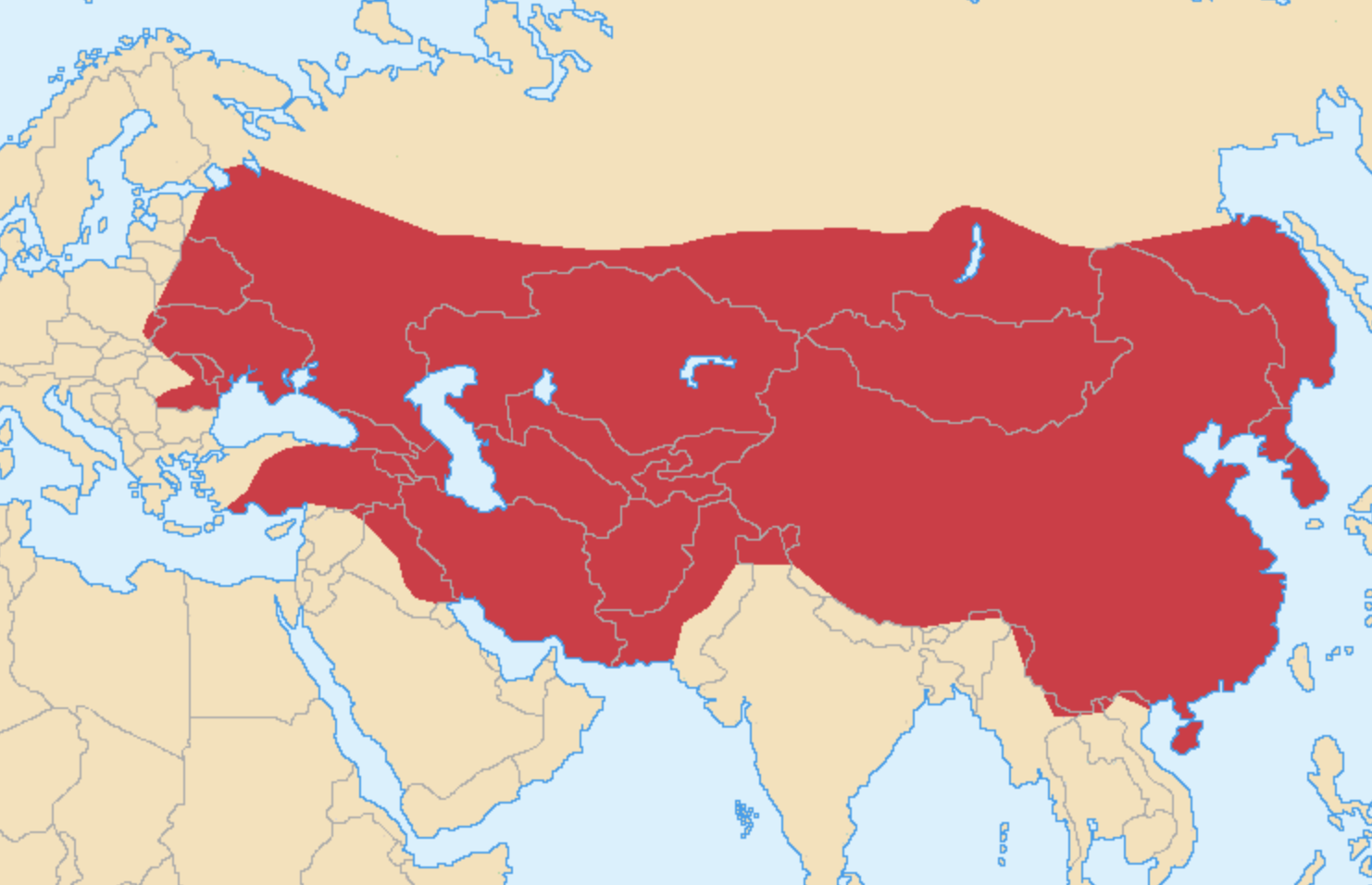
1222–1292 CE (70 years, 728-658 BA): Singhasari Kingdom of Java, a Hindu-Buddhist kingdom in eastern Java, Indonesia. The kingdom was founded by Ken Arok, a local warrior who defeated the previous ruling kingdom of Kediri in 1222. The name Singhasari comes from the Sanskrit words singha, meaning “lion”, and sari, which could mean “essence” or “to sleep”. Enraged by this humiliation and the disgrace committed against his envoy and his patience, in late 1292 Kublai Khan sent 1,000 war junks for a punitive expedition to destroy the Kingdom.
1226–1561 CE (335 years, 724-389 BA): Teutonic Order, State of the, a theocratic state, located along the southeastern shore of the Baltic Sea in northern Europe. It was formed by the knights of the Teutonic Order during the early 13th century Northern Crusades in the region of Prussia. In 1237, the Livonian Brothers of the Sword merged with the Teutonic Order of Prussia and became known as its branch — the Livonian Order (while their state, Terra Mariana, covering present-day Estonia and Latvia, became part of the State of the Teutonic Order). Following the battles of Grunwald in 1410 and Wilkomierz in 1435, the State fell into decline. After losing extensive territories in the imposed Peace of Thorn in 1466, the extant territory of its Prussian branch became known as Monastic Prussia or Teutonic Prussia and existed until 1525 as a part and fiefdom of the Kingdom of Poland. The Livonian branch joined the Livonian Confederation and continued to exist as part of it until 1561.
1235–1670 CE (435 years, 615-280 BA): The Mali Empire was an empire in West Africa that became renowned for the wealth of its rulers.
1236–1795 CE (459 years, 614-155 BA): Lithuania, Grand Duchy of, founded by Lithuanians, who were at the time a polytheistic nation of several united Baltic tribes from Aukštaitija, which by 1440, became the largest European state controlling an area from the Baltic Sea in the north to the Black Sea in the south. The pagan state was targeted in a religious crusade by the Teutonic Knights and the Livonian Order, but survived. Eventually, the Union of Lublin of 1569 created a new state, the Polish–Lithuanian Commonwealth. The federation was terminated by the passing of the Constitution of 3 May 1791, however, the newly reformed Commonwealth was invaded by Russia in 1792 and partitioned between neighbouring states.
1242–1502 CE (260 years, 608-280 BA): Golden Horde Khanate, 1242–1502, a Mongol and later Turkicized khanate originating as the northwestern sector of the Mongol Empire. After 1259, it became a functionally separate khanate. The Horde’s military power peaked during the reign of Uzbeg Khan (1312–1341), who adopted Islam. The territory of the Golden Horde at its peak extended from Siberia and Central Asia to parts of Eastern Europe from the Urals to the Danube in the west, and from the Black Sea to the Caspian Sea in the south, while bordering the Caucasus Mountains and the territories of the Mongol dynasty known as the Ilkhanate.
1250–1890 CE (640 years, 700-60 BA): Bunyoro-Kitara, Kingdom of, Uganda region, rose to power and controlled a number of the holiest shrines in the region, as well as the lucrative Kibiro saltworks of Lake Mwitanzige. Having the highest quality of metallurgy in the region made it one of the strongest economic and military powers in the Great Lakes region.
1250–1500 CE (250 years, 700-450 BA): Pre-Columbian complex societies in southern Amazonia. Much of what has been viewed as pristine forests are abandoned agricultural lands. Pre-Columbian populations were denser and their environmental impact, including earthwork construction, was higher in seasonal climates such as found in the SRA (Southern Rim Area). Today's fossil-fueled settlement of the Amazon may be less sustainable and species extinction may be vaster.
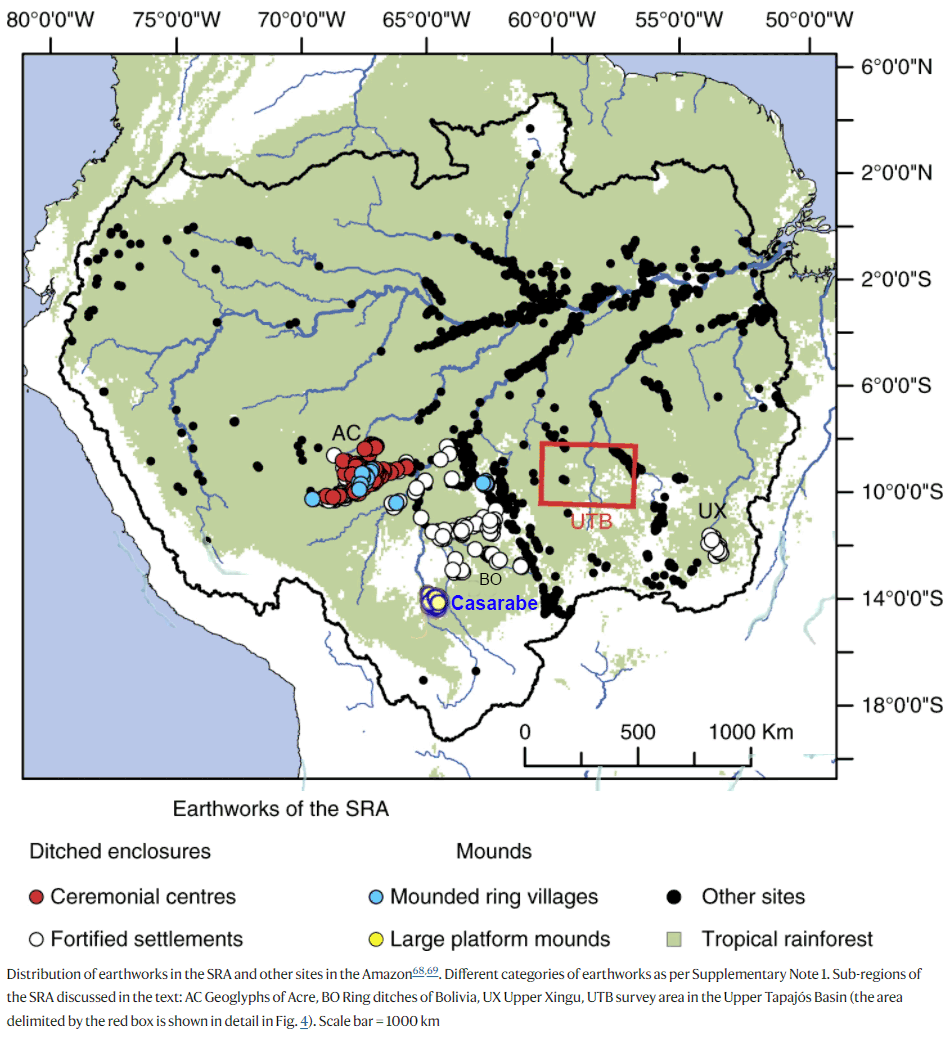
1261–1453 CE (192 years, 689-497 BA): Constantinople was retaken by the Byzantine successor state centered in Nicaea, re-establishing the Byzantine Empire until 1453, by which time the Turkish-Muslim Ottoman Empire (ca. 1300–1918), had conquered most of the region.
1270–1974 CE (704 years, 698 BA-24 AA): Ethiopian Empire, aka Abyssinian, 1270–1974, spanned the geographical area of present-day Ethiopia and Eritrea from the establishment of the Solomonic dynasty.
1275–1403 CE (128 years, 703-547 BA): Ifat, Sultanate of, a medieval Sunni Muslim state in the eastern regions of the Horn of Africa having the oldest mosque in Africa. Conquered during Abyssinian invasion.
1293–1527 CE (234 years, 657-423 BA): The Majapahit Empire was a vast archipelagic empire based on the island of Java.
1299–1923 CE (624 years, 651-27 BA): The Ottoman Empire, also known as the Turkish Empire, Ottoman Turkey, or simply Turkey, was an empire founded by Oghuz Turks under Osman I in northwestern Anatolia. The Ottoman Empire was a successor of the Abbasid Empire and it was the most powerful empire to succeed the Abbasi empires at the time, as well as one of the most powerful empires in the world.
1300–1530 CE (230 years, 650-420 BA): The Tarascan state in pre-Columbian Mexico, roughly covered the geographic area of the present-day Mexican state of Michoacán, parts of Jalisco, and Guanajuato. At the time of the Spanish conquest, it was the second-largest state in Mesoamerica.
1336–1646 CE (310 years, 614-304 BA): Vijayanagara Empire, aka Karnata Kingdom, a medieval Hindu empire that ruled much of southern India. It was established in 1336 by the brothers Harihara I and Bukka Raya I of the Sangama dynasty, members of a pastoralist cowherd community that claimed Yadava lineage. The empire lasted until 1646, although its power greatly declined after a major military defeat in the Battle of Talikota in 1565 by the combined armies of the Deccan sultanates.
1347–1527 CE (180 years, 697-417 BA): Bahmani Sultanate, a Muslim empire that ruled the Deccan Plateau in South India. The Bahmani Sultanate came to power in 1347 during the Rebellion of Ismail Mukh after Ismail Mukh abdicated in favor of Zafar Khan, who would establish the Bahmani Sultanate. The Bahmani Sultanate was in perpetual war with its neighbors, including its rival, the Vijayanagara Empire, which would outlast the Sultanate.
1350–present (673 years, 700 BA-73 AA): Buganda, Kingdom of, 14th century to present, a Bantu kingdom within Uganda. The kingdom of the Baganda people, Buganda is the largest of the traditional kingdoms in present-day East Africa, consisting of Buganda’s Central Region, including the Ugandan capital Kampala. The 14 million Baganda make up the largest Ugandan region, representing approximately 16% of Uganda’s population.
1352–1539 and 1554–1576 CE (209 years): Bengal Sultanate, a late medieval South Asian sultanate based in the Bengal region between the 14th and 16th century. It was the dominant power of the Ganges-Brahmaputra Delta, with a network of mint towns spread across the region. The Bengal Sultanate had a circle of vassal states in the Indian subcontinent, including parts of Odisha in the southwest, Arakan in the southeast, and Tripura in the east.
1354–1707 CE (353 years, 596-443 BA): Lan Xang was one of the largest kingdoms in Southeast Asia. The "million elephants under the white parasol." For three and a half centuries, Lan Xang was one of the largest kingdoms in Southeast Asia building empire as usual. The kingdom is the basis for Laos’s national historic and cultural identity. The Tai peoples migrated south in a series of waves beginning in the 7th century and accelerated following the Mongol conquest of Yunnan (1253–1256). Access to advanced European weapons proved decisive during the Burmese invasions of Lan Xang and would become more important in subsequent wars with Vietnam and Thailand during the eighteenth and nineteenth centuries.
1360–1549 CE Jolof Empire or Wolof Empire, a Wolof and Sereer confederacy state that ruled parts of West Africa, most precisely modern-day Senegal, Mali, Gambia and Mauritania from around the 12th century, its vassal states were fully or de facto independent; in this period it is known as the Jolof Kingdom. Jolof was a vassal of the Mali Empire for much of its early history. It remained within that empire’s sphere of influence until the latter half of the 14th century. In 1549, Kayor successfully broke from the Jolof Empire by defeating Jolof at the Battle of Danki.
1368–1888 CE (520 years, 596-62 BA): Brunei, Sultanate of, a Malay sultanate, centred in Brunei on the northern coast of Borneo island in Southeast Asia. Brunei became a sovereign state around the 15th century, when it grew substantially after the fall of Malacca to the Portuguese, extending throughout coastal areas of Borneo and the Philippines, before it declined in the 17th and 18th centuries. The first ruler or sultan of Brunei was a Muslim. It became a British protectorate in the 19th century.
1370–1507 CE (137 years, 580-443 BA): The Timurid Empire, self-designated as Gurkani, was a Persianised Turco-Mongol empire comprising modern-day Iran, the Caucasus, Mesopotamia, Afghanistan, much of Central Asia, as well as parts of contemporary Pakistan, Syria, and Turkey.
1378–1503 CE (125 years, 572-447 BA): Turkoman confederations, the (Aqqoyunlu and Qaraqoyunlu), a culturally Persianate, Sunni Turkoman tribal confederation that ruled parts of present-day eastern Turkey. The last Aq Qoyunlu sultan, Morad, who hoped to regain the throne with the help of Ottoman troops, was defeated and killed by Ismail’s Qizilbash warriors in the last fortress of Rohada, ending the political rule of the Aq Qoyunlu dynasty.
1390–1894 CE (500 years, 556-56 BA): Kongo, Kingdom of, a large kingdom in central Africa. It was home to over 2 million people and was prosperous due to the trade of ivory, salt, slaves, cattle hides, and copper. The kingdom was located in present-day northern Angola, the western portion of the Democratic Republic of the Congo, Southern of Gabon and the Republic of the Congo. The kingdom’s religious history is equally as important as its influence on world history. In Kongo, a unique fusion of indigenous traditions and Roman Catholicism developed. It was taken over by the Kingdom of Portugal inn 1914.
1392–1894 CE (502 years, 558-56 BA): Choson (Joseon) Korea, consolidated its effective rule over the Korean peninsula and saw the height of classical Korean culture, trade, literature, and science and technology. In the 1590s, the kingdom was severely weakened due to the two failed Japanese invasions.
1400–1511 CE (110 years, 550-439 BA): Melaka (Malacca) Sultanate, at the height of the sultanate’s power in the 15th century, its capital grew into one of the most important transshipment ports of its time, with territory covering much of the Malay Peninsula, the Riau Islands and a significant portion of the northern coast of Sumatra in present-day Indonesia.
1415–1999 CE (584 years, 535 BA-49 AA): Portuguese Empire, was one of the largest empires, but not, as Wikipedia claims, one of the longest-lived. It stretched across the globe, with bases in North and South America, Africa, and various regions of Asia and Oceania. The empire ended in 1999 when Macau, the first and last outpost of European empire-building, was taken back by China.
1415–1577 CE (162 years, 535-373 BA): Adal Sultanate, a medieval Sunni Muslim Empire which was located in the Horn of Africa.
1427–1519 CE (92 years, 523-431 BA): The Aztec Empire was a tribute empire based in Tenochtitlan that extended its power throughout Mesoamerica in the late postclassic period. It originated in 1427 as a triple-alliance between the city-states Tenochtitlan, Texcoco, and Tlacopan, and was conquered by the Spanish conquistadors.
1430–1760 CE (330 years, 520-190 BA): The Kingdom of Mutapa, the Mutapa Empire, Mwenemutapa, was an African empire covering vast territories in what are now modern day Zimbabwe, Zambia, Mozambique and South Africa. Infighting among different factions led to opposing sides calling on the Portuguese for military aid. However, the Portuguese proved to be happy with the downfall of the Mutapa state which became a puppet Portuguese empire. The Mwenemutapa ruler died in 1759, sparking yet another civil war for the throne. This one was more destructive than its predecessors and Mutapa never recovered. The "winners" ended up governing an even more reduced land area.
1430s–1591 CE (161 years, 520-359 BA): Songhai Empire, a state located in the western part of the Sahel during the 15th and 16th centuries. At its peak, it was one of the largest African empires in history. The state is known by its historiographical name, derived from its largest ethnic group and ruling elite, the Songhai people. Sonni Ali established Gao as the empire’s capital, although a Songhai state had existed in and around Gao since the 11th century. Other important cities in the kingdom were Timbuktu and Djenné, where urban-centred trade flourished; they were conquered in 1468 and 1475, respectively. Initially, the Songhai Empire was ruled by the Sonni dynasty (c. 1464–1493), but it was later replaced by the Askia dynasty. The Songhai Empire collapsed after the defeat at the Battle of Tondibi in 1591.
1438–1552 CE (114 years, 512-398 BA): Kazan Khanate, a medieval Tatar Turkic state that occupied the territory of former Volga Bulgaria between 1438 and 1552. It was one of the successor states of the Golden Horde (Kipchak Khanate), and it came to an end when it was conquered by the Tsardom of Russia.
1438–1572 CE (134 years, 512-378 BA): The Inca Empire was the largest empire in pre-Columbian America. The Inca civilization arose from the highlands of Peru sometime in the early 13th century, and the last Inca stronghold was conquered by the Spanish in 1572.
1440s–1634 CE (190 years, 506-316 BA): Nogai Horde, they were pastoral nomads grazing sheep, horses, and camels. Main sources of income was raiding for slaves, caravan taxation, and seasonal agricultural migration. A confederation founded by the Nogais that occupied the Pontic–Caspian steppe from about 1500 until they were pushed west by the Kalmyks and south by the Russians in the 17th century.
1450–1916 CE (378 years, 500-34 BA): Lozi Empire, c. 1450–1916, a major pre-colonial African polity centered on the Upper Zambezi floodplain, dominated the region for over a century. Structures of ritual, political, economic, and social power were built into the fabric of the empire, and the power of tribute and slaves sustained it. A powerful, centralized state forged a polity that met the colonial moment from a position of unusual strength. Great Britain granted a royal charter to the British South Africa Company allowing the company to acquire Barotseland under the guise of the British government.
1451–1779 CE (378 years, 499-171 BA): Iroquois Confederacy, also known as the Haudenosaunee, was a union of six Native American nations. The Confederacy consisted of the Mohawks, Oneidas, Onondagas, Cayugas, and Senecas. In 1712, the Tuscaroras joined the Confederacy. The Huron did not join and in the late 16th century joined the Wyandot, Bear and Cord in a defensive alliance against the Haudenosaunee nations. They lost and some managed to flee to Canada and southern Ohio. In 1649 the Haudenosaunee went to Canada to complete the extermination. In 1744 the Iroquois Confederacy sold the state of Virginia all their remaining claims in the Shenandoah Valley for 200 pounds in gold. During the American Revolution, the Oneida and Tuscarora sided with the American colonists while the rest of the league fought for the British. The loyalist Iroquois were defeated in 1779, and the confederacy came to an end. Or the confederacy lost 4 members and the Iroquois Confederacy will rise again.
1465–1847 CE (382 years, 485-103 BA): Kazakh Khanate, a Kazakh state in Central Asia, successor of the Golden Horde. From the 16th to the 17th centuries, the Kazakh Khanate ruled and expanded its territories to eastern Cumania (modern-day West Kazakhstan), most of Uzbekistan, Karakalpakstan and the Syr Darya river with military confrontation as far as Astrakhan and Khorasan, which are now in Russia and Iran, respectively. The Khanate was later weakened by a series of Oirat and Dzungar invasions in the 17th and 18th centuries. These resulted in a decline and further disintegration into three jüz, which gradually lost their sovereignty and were incorporated to the expanding Russian Empire in the 19th century.
1467–1615 CE (148 years, 483-335 BA): Sengoku period in Japan, also known as the Warring States Period, was a time of civil war and social unrest in Japan. During this period, rival factions and warlords, known as daimyo, fought for control of the country.
1480–1891 CE (411 years, 470-59 BA): Maravi Kingdom, straddled the current borders of Malawi, Mozambique, and Zambia, in the 16th century. The Maravi Confederacy was founded by Bantu people immigrating into the valley of the Shire River (flowing out of Lake Nyassa) around 1480 AD. It prospered into the late 18th century, extending to reach what is now belonging to Zambia and Mozambique. A British consul was also sent there in 1883. David Livingstone visited Lake Nyasa in 1859, and other Protestant missionaries soon followed.
1490–1686 CE (192 years, 456-264 BA): Deccan Sultanates, five late-medieval Indian kingdoms on the Deccan Plateau that were ruled by Muslim dynasties.
1492–1975 CE (483 years, 458 BA-25 AA): Spanish Empire was one of the largest empires in history as the Americas were continents for the taking an they were the first to get there. Its empire included the Philippines and also territories in Europe, Africa and Oceania. It was the first empire upon which the sun never set.
1496–1903 CE (407 years, 462-47 BA): Aceh Sultanate, was centered in the modern-day Indonesian province of Aceh. It was a major regional power in the 16th and 17th centuries, before experiencing a long period of decline.
1501–1736 CE (235 years, 467-214 BA): Safavid Empire, one of the largest and long-standing Iranian empires after the 7th-century Muslim conquest of Persia, which was ruled from 1501 to 1736 by the Safavid dynasty. It is often considered the beginning of modern Iranian history, as well as one of the gunpowder empires. The Safavid Shāh Ismā’īl I established the Twelver denomination of Shīʿa Islam as the official religion of the empire, marking one of the most important turning points in the history of Islam.
1501–1912 CE (429 years, 467-38 BA): Wadai (Ouaddai) Empire, an African sultanate located to the east of Lake Chad. Prior to the 1630s, Wadai region people were a pre-Islamic Tunjur kingdom, established around 1501. In 1635, small groups in the region rallied to the Islamic banner, ruling until the arrival of the French.
1504–1821 CE (317 years, 470-93 BA): Funj Sultanate of Sinnar, a monarchy in what is now Sudan, northwestern Eritrea and western Ethiopia. Founded in 1504 by the Funj people, it quickly converted to Islam, although this conversion was only nominal. Until a more orthodox form of Islam took hold in the 18th century, the state remained an “African empire with a Muslim façade”. It reached its peak in the late 17th century, but declined and eventually fell apart in the 18th and 19th centuries.
1526–1857 CE (331 years, 424-93 BA): The Mughal Empire or Mogul Empire, self-designated as Gurkani, was an empire based in the Indian Subcontinent, established and ruled by a Muslim Persianate Dynasty of Chagatai Turco-Mongol.
1528–1855 CE (329 years, 426-91 BA): Johor-Riau Empire, a sultanate in Malaysia. In the 17th century Johor became the dominant regional power competing with other colonial powers, defeated by British in 1855.
1536–1953 CE (417 years, 434 BA-3 AA): Danish Empire, Overseas Colonies, The period of colonial expansion marked a rise in the status and power of Danes and Norwegians in the Kalmar Union. Danes and Norwegians during this time increasingly saw themselves as citizens of the same “State Fatherland”, the realm of the . In the 17th century, following territorial losses on the Scandinavian Peninsula, Denmark–Norway began to develop forts with trading posts in West Africa, and colonies in the Caribbean, and the Indian subcontinent. Christian IV first initiated the policy of expanding Denmark–Norway’s overseas trade, as part of the mercantilist wave that was sweeping Europe.
1537–1867 CE (330 years, 435-83 BA): Kaabu Empire, 1537–1867, a federation of Mandinka kingdoms centered within modern northeastern Guinea-Bissau. It rose to prominence as an imperial military province of the Mali Empire. After the decline of the Mali Empire, Kaabu became independent. Kaabu’s many wars of expansion produced up to half of the African people sold into slavery during the 17th and 18th centuries.
1540–1897 CE (357years, 432-53 BA): Merina Empire, , or Kingdom of Madagascar, was a pre-colonial state off the coast of Southeast Africa that, by the 18th century, dominated most of what is now Madagascar. The Merina kings and queens who ruled over greater Madagascar in the 19th century were the descendants of a long line of hereditary Merina royalty. In 1883, France invaded the Merina Kingdom to establish a protectorate. France invaded again in 1894 and conquered the kingdom, making it a French colony, in what became known as the Franco-Hova Wars.
1569–1795 CE (136years, 381-155 BA): Polish–Lithuanian Empire, a bi-confederal[11] state, sometimes called a federation, of Poland and Lithuania ruled by a common monarch in real union, who was both King of Poland and Grand Duke of Lithuania. It was one of the largest and most populous countries of 16th- to 17th-century Europe. At its largest territorial extent, in the early 17th century, the Commonwealth covered almost 1,000,000 km2 (400,000 sq mi) and as of 1618 sustained a multi-ethnic population of almost 12 million. Polish and Latin were the two co-official languages, and Roman Catholicism served as the state religion. by 1768, it started to be considered by Russians as a protectorate of the Russian Empire despite the fact that it was still an independent state. A majority of control over Poland was central to Catherine the Great’s diplomatic and military strategies. Attempts at reform, such as the Four-Year Sejm’s May Constitution, came too late. The country was partitioned in three stages by the Russian Empire, the German Kingdom of Prussia, and the Austrian Habsburg Monarchy. By 1795, the Polish–Lithuanian Commonwealth had been completely erased from the map of Europe. Poland and Lithuania were not re-established as independent countries until 1918.
1580–1640 CE (60 years, 370-310 BA): The Spanish–Portuguese Empire of the Iberian Union was the first global imperial entity.
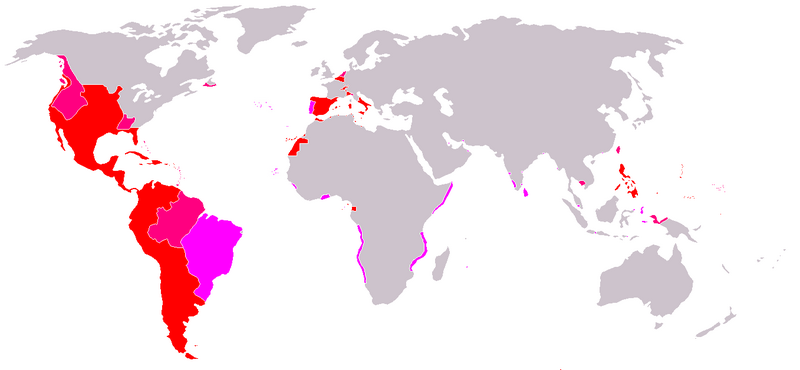
1583–1815 CE (232 years, 370-135 BA): The British Empire established their first empire in North America (1583–1783 CE) by colonizing lands that made up British America, including parts of Canada and the Thirteen Colonies. In 1776, the Continental Congress of the Thirteen Colonies declared itself independent from the British Empire, thus beginning the American Revolution. Britain turned towards Asia, the Pacific, and later Africa, with subsequent exploration leading to the rise of the Second British Empire (1783–1815), which was followed by the Industrial Revolution and Britain's Imperial Century (1815–1914). It became the largest empire in world history, encompassing one quarter of the world's land area and one fifth of its population, the impacts of which are still widespread in the current age.
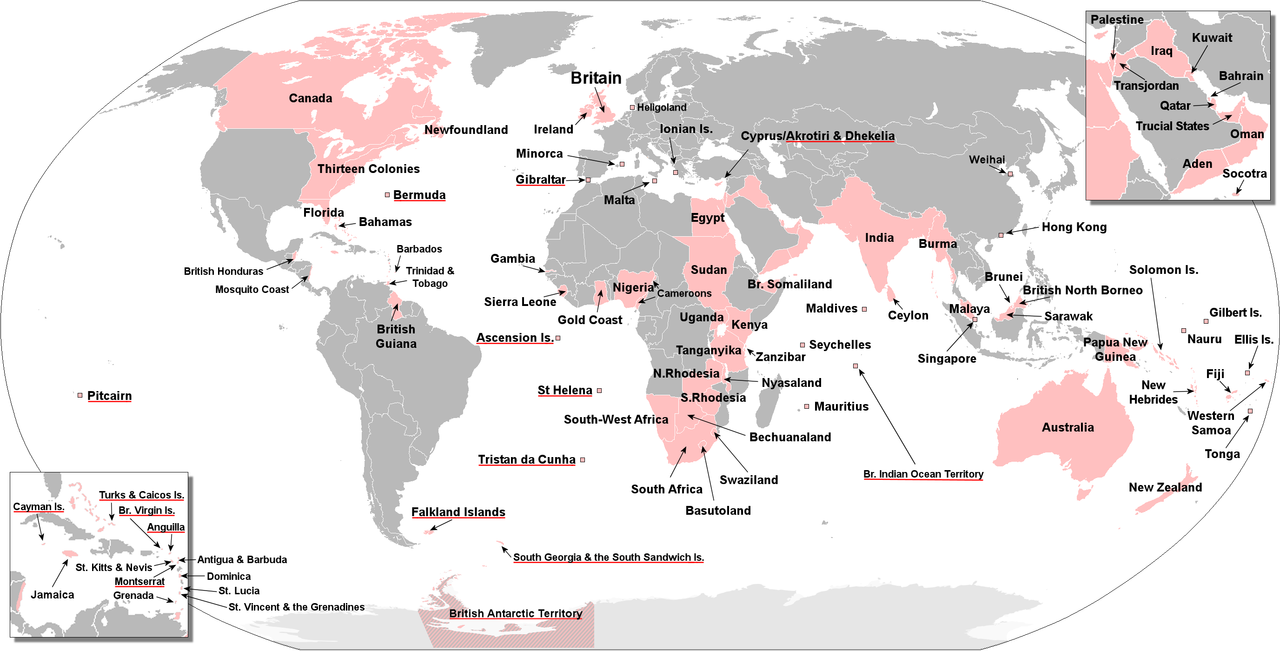
1585–1889 CE (294 years, 365-71 BA): Luba–Lunda states, a pre-colonial Central African state that arose in the marshy grasslands of the Upemba Depression in what is now southern Democratic Republic of Congo. The economy was complex and based on a tribute system that redistributed agricultural, hunting and mining resources among nobles. The ruling class held a virtual monopoly on trade items such as salt, copper, and iron ore. Ultimately, long-distance trade destroyed the kingdom of Luba. In the 1870s and 1880s, traders from East Africa began searching for slaves and ivory in the savannas of central Africa. The empire was raided for slaves beginning the rapid destruction of the Luba Kingdom. In 1889 it was split in two by a succession dispute, ending the unified state, and later joined the Belgian Congo Free State.
1600–1904 CE (304 years 350-46 BA): Dahomey, Kingdom of, West African kingdom located within present-day Benin. A key regional state, after eventually ending tributary status to the Oyo Empire organized domestic economy built on conquest and slave labor, significant international trade and diplomatic relations with Europeans.
1602–2010 CE (304 years 352 BA-60 AA): Dutch Empire: a colonial empire administered by Dutch chartered companies — mainly the Dutch East India Company and the Dutch West India Company — and subsequently by the Dutch Republic, an early corporatocracy.
1611 to 1809 CE (198 years 339-141 BA) Swedish Empire, the period in Swedish history spanning much of the 17th and early 18th centuries during which Sweden became a European great power that exercised territorial control over much of the Baltic region. The beginning of the period is usually taken as the reign of Gustavus Adolphus, who ascended the throne in 1611, and its end as the loss of territories in 1721 following the Great Northern War. The last traces of occupied continental territory vanished during the Napoleonic Wars, and Finland went to Russia in 1809, marking the end of Sweden’s period as a great power.
1634–1758 CE (124 years 316-192 BA) Zünghar Khanate, Dzungar Khanate, an Inner Asian khanate of Oirat Mongol origin. At its greatest extent, it covered an area from southern Siberia in the north to present-day Kyrgyzstan in the south, and from the Great Wall of China in the east to present-day Kazakhstan in the west. The core of the Dzungar Khanate is today part of northern Xinjiang, also called Dzungaria. 1755–1758 Qing army occupation of Dzungaria and genocide.
1674–1818 CE (144 years 276-132 BA): The Maratha Empire (also known as the Maratha Confederacy) was a Hindu state located in present-day India. It existed from , and at its peak, the empire's territories covered much of Southern Asia. The empire was founded and consolidated by Shivaji. After the death of Mughal Emperor Aurangzeb, it expanded greatly under the rule of the Peshwas.
1680–1818 CE (298 years 282 BA-16 AA): Burundi, Kingdom of, 1680–1966. The region was originally inhabited by Twa pygmy hunter-gatherers before the influx of Bantu farmers who displaced them from all arable lands from about the 11th century. The Kingdom of Burundi was probably founded in the 16th or 17th century when Bantu pastoralists with cattle entered the area. The pastoralists arrived in waves and initially founded a number of small kingdoms, exploiting the lack of unity among the already settled farmers. After gaining control over the existing population, the newly arrived settlers ultimately assimilated them. The region’s pastoralists were considered the ancestors of the later Tutsi ethnic group, while the agriculturalists became the Hutus.
1701–1896 CE (195 years, 249-54 BA): The Ashanti Empire (or Confederacy), also Asanteman, was a West African state of the Ashanti, the Akan people of the Ashanti Region, Akanland in modern-day Ghana. The Ashanti (or Asante) were a powerful, militaristic and highly disciplined people in West Africa. Their military power, which came from effective strategy and an early adoption of European firearms, created an empire that stretched from central Akanland (in modern-day Ghana) to present day Benin and Ivory Coast, bordered by the Dagomba kingdom to the north and Dahomey to the east. Due to the empire's military prowess, sophisticated hierarchy, social stratification and culture, the Ashanti empire had one of the largest historiographies of any indigenous Sub-Saharan African political entity.
1710–1898 CE (188 years, 240-52 BA): Kong (Ouattara or Wattara) Empire, a pre-colonial African Muslim state. It was located in present-day Côte d’Ivoire and Burkina Faso. In 1710, Seku Ouattara (Wattara), a Dioula warrior, invaded the area and conquered the city of Kong. He established himself as ruler and the city became the capital of the Kong Empire. At its height in the 1730s, the empire stretched from the fringes of Asante, nearly to Jenné in the north, and westward to the Bamana Kingdoms. It became the largest kingdom thus far south of the Niger River. The empire lasted until 1897, when it was destroyed by Samory Touré.
1712 CE: (238 BA): Industrial Revolution begins with first commercial steam engine used to pump water from coal mines. The fossil-fueled belief-in-growth based Euro-Sino Empire emerges to subsume all prior empires.
1712–1861 CE: (149 years, 238-387 BA): Bamana Empire of Segu, one of the largest states of West Africa in the 18th century. Along with Kaarta it was one of the most important successors of the Songhai Empire. Based on an earlier kingdom established in 1640, it grew into a powerful empire in the early 18th century under Bitòn Coulibaly. The empire existed as a centralized state from 1712 until the 1861 invasion by the Toucouleur conqueror El Hadj Umar Tall.
1721–1917 CE (196 years, 229-33 BA): The Russian Empire in 1866 became the second largest contiguous empire to have ever existed. The Russian Empire was a state that existed until overthrown by the short-lived liberal February Revolution in 1917.
1725–1912 CE (187years, 233-38 BA): Futa Jalon, Imamate of, Semi-nomadic Fulɓe first came to the Fouta Djallon over successive generations between the 15th and 16th centuries. Initially, they followed a traditional African religion and coexited peacefully with the native Yalunka people. In the 18th century an influx of Muslim Fulɓe from Macina, Mali changed the fabric of Fula society. The West African Islamic State conquered the native people, assimilating women and livestock.
1736-1926 CE (190years, 214-24 BA): Persian Empire, later (Afsharid to Qajar), the Afsharid Empire was an Iranian empire established in 1736 by the Turkoman Afshar tribe. The empire’s capital was Mashhad and it was ruled by the Afsharid dynasty in the mid-eighteenth century. The empire’s greatest extent was under Nader Shah, who ruled from 1736 to 1747. The Afsharid army was primarily a cavalry-based force. It peaked at 375,000 men in 1743, an unsustainable figure that led to the collapse of the empire’s economy by 1796 followed by the Qajars (1796–1926), both of which are considered Safavid successor states.
1747–1823 CE (76 years, 255-127 BA): Durrani Empire, an Afghan empire that spanned parts of Central Asia, the Iranian plateau, and the Indian Subcontinent. At its peak, it ruled over the present-day Afghanistan, much of Pakistan, parts of northeastern and southeastern Iran, eastern Turkmenistan, and northwestern India. Next to the Ottoman Empire, the Durrani Empire is considered to be among the most significant Islamic Empires of the 18th century.
1776–1859 CE (83 years, 174-91 BA): Futa Toro, Imamate of, a West African theocratic monarchy. Following the trend of jihads in the late 17th century and early 18th century, the religious leader led a jihad in 1776. His successor, the expansionist Abdul Kader defeated the emirates of Trarza and Brakna and by his death in 1806, power became decentralized between a few elite families of Torodbes. Threatened by both the expansion of the Toucouleur Empire and the French in the mid-19th century, Futa Toro was eventually annexed in 1859. By the 1860s, the power of the Almamy became nominal and the state was further weakened when a cholera epidemic killed a quarter of its population in 1868.
1782–1932 CE (150 years, 168-18 BA): Siamese Empire or Rattanakosin Kingdom is the fourth traditional center of power in the History of Thailand (or Siam). It was founded with the establishment of Bangkok as the capital city.
1789–1961 CE (172 years, 161 BA-11 AA): American Empire expands westward and beyond until subsumed by the "Military Industrial Complex" (aka global Euro-Sino Empire of commerce) it was warned about. America was the most warlike empire-builder in the history of the world.
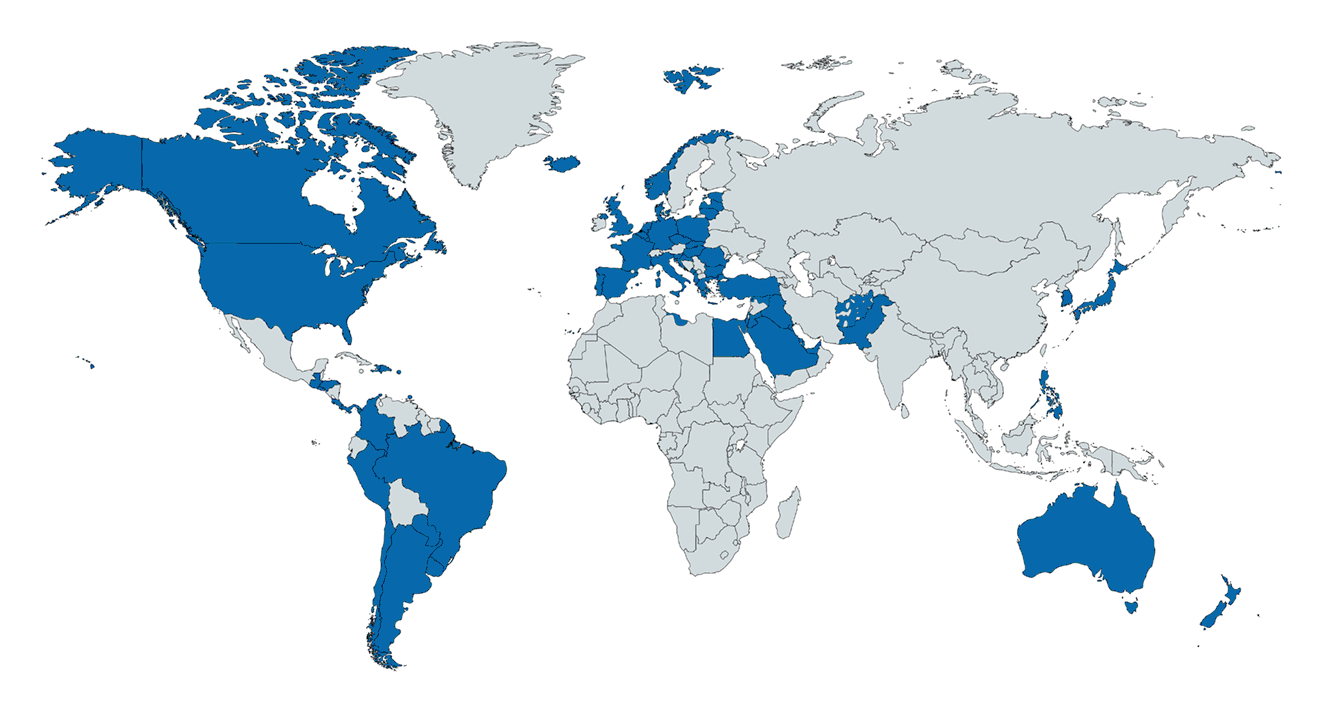
1795–1891 CE (96 years, 155-59 BA): Tukulor Empire, a Toucouleur empire emerged which reached its peak influence in the 19th century under the Islamic leader Omar Saidou Tall. Omar was born in a Toucouleur clerical family in 1797. During his visit to Mecca in 1827, Omar was designated as the “Caliph of Black Africa.” He returned to West Africa in 1833, and subsequently learned political and state building strategies from his father-in-law in the Sokoto Caliphate. The Toucouleur Empire of Omar Saidou Tall expanded from Futa Toroo into new regions (red) in the 19th century. Omar returned to Senegal in 1845, where he began preaching Islam among the Toucouleur. He obtained weapons from Europe, then mobilized the Toucouleur to pursue an Islamic holy war in 1854 against the non-Muslim ethnic groups and those Muslims who had strayed. The Toucouleur armies succeeded. The Toucouleur Empire grew and extended from Senegal to much of Mali over the next ten years. His son Mustafa reigned over this empire and the Toucouleur between 1864 and 1870, followed by Omar’s second son, Ahmadu Tall a “Toucouleur-Muslim despot” over the Mandinka people and Bambara people. The empire collapsed in the 1880s as the Fulani, Tuaregs and the Moors attacked the Toucouleurs, and a civil war between local Toucouleur leaders engulfed the region. The empire ended in 1891, after the French colonial forces invaded the region.
1799–1846 CE (47 years, 151-104 BA): The Sikh Empire was established in the Punjab region of India. The empire collapsed when its founder, Ranjit Singh, died and its army fell to the British.
1804–1814 CE (10 years, 146-136 BA): The First French Empire was the empire of Napoleon Bonaparte of France and the dominant power in much of continental Europe at the beginning of the 19th century.
1804–1818 CE (14 years, 146-132 BA): Austrian Empire (1804 to 1867); Austro-Hungarian Empire (1867–1918), during its existence, it was the third most populous monarchy in Europe after the Russian Empire and the United Kingdom. Along with Prussia, it was one of the two major powers of the German Confederation. Geographically, it was the third-largest empire in Europe after the Russian Empire and the First French Empire.
1818–1862 CE (44 years, 132-88 BA): The Massina Empire, was one of the most organized theocratic states of its time on the African continent. It was ruled by an almami with the help of a Grand Council that possessed the power to elect new rulers after the death of the previous one. While, in theory, the almami did not have to be a member of the Bari family, but only someone who was learned and pious, every almami elected happened to be a son of the previous ruler.
1822–1889 CE (67 years, 128-61 BA): Empire of Brazil, a 19th-century state that broadly comprised the territories which form modern Brazil and (until 1828) Uruguay. Its government was a representative parliamentary constitutional monarchy under the rule of Emperors Pedro I and his son Pedro II. A colony of the Kingdom of Portugal, Brazil became the seat of the Portuguese Empire in 1808, when the Portuguese Prince regent, later King Dom John VI, fled from Napoleon’s invasion of Portugal and established himself and his government in the Brazilian city of Rio de Janeiro.
1852–1870 CE (18 years, 98-80 BA): The Second French Empire was the Imperial Bonapartist regime of Napoleon III.
1868–May 3, 1947 CE (79 years, 82-3 BA): The Empire of Japan, at its maximum extent in 1942, was the historical Japanese nation-state that existed from the Meiji Restoration in 1868 to the enactment of the 1947 constitution of modern Japan, part of the Euro-Sino Empire, that serves commercial interests.
1871–1918 CE (47 years, 79-42 BA): The German Empire, another "heir to the Holy Roman Empire."
1882–1947 CE (65 years, 68-3 BA): The Italian (colonial) Empire, ending in Fascism. Founded in Africa in the 19th century comprised the colonies, protectorates, concessions and dependencies included in the territories of present-day Libya, Eritrea, Somalia and Ethiopia.
1884–1920 CE (65 years, 66-30 BA): German Colonial Empire, states unified in 1871, the chancellor of this time period was Otto von Bismarck. Short-lived attempts at colonization by individual German states had occurred in preceding centuries, but Bismarck resisted pressure to construct a colonial empire until the Scramble for Africa in 1884. Claiming much of the remaining uncolonized areas of Africa, Germany built the third-largest colonial empire at the time, after the British and French. The German colonial empire encompassed parts of several African countries, including parts of present-day Burundi, Rwanda, Tanzania, Namibia, Cameroon, Gabon, Congo, Central African Republic, Chad, Nigeria, Togo, Ghana, as well as northeastern New Guinea, Samoa and numerous Micronesian islands. All colonies disestablished in 1920 post WWI.
1897–1920 CE (23 years, 53-30 BA): Dervish State (Somali), a territory in the Horn of Africa established by Mohammed Abdullah Hassan, a Muslim religious leader and spiritual leader to his Somali followers. The Dervish State was a mobile proto-state with shifting boundaries and a fluctuating population. It was one of the longest and bloodiest militant movements in sub-Saharan Africa during the colonial era, overlapping with World War I.
1908-1962 CE (54 years, 42 BA-12 AA): Belgian Empire, overseas territory was just one colony (about 76 times larger than Belgium itself) — known as the Belgian Congo. The colony was founded in 1908 following the transfer of sovereignty from the Congo Free State, which was the personal property of Belgium’s king, Leopold II. The violence used by Free State officials against indigenous Congolese and the ruthless system of economic extraction had led to intense diplomatic pressure on Belgium to take official control of the country. Belgian rule in the Congo was based on the “colonial trinity” (trinité coloniale) of state, missionary and private company interests.
1933-1945 CE (12 years, 17-5 BA): Nazi Germany, Heil Hitler!
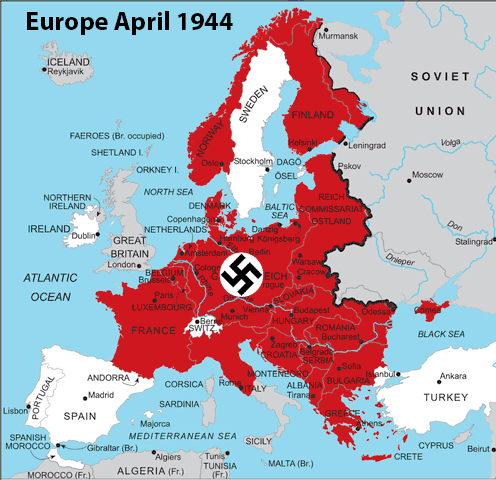
1949-present (75+ years, 1 BA+): China, People’s Republic of, 1949 to present.
1949-1991 CE (42 years, 1 BA-41 AA): Soviet Empire, an imperialist colonial power maintaining a socialist façade.
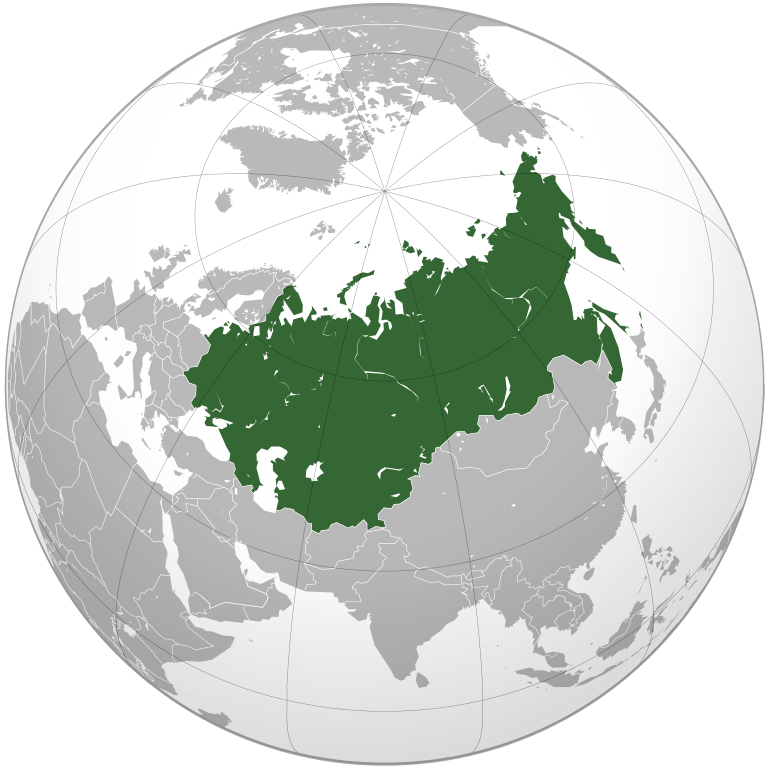
2001 CE (51 AA): IS, Islamic State, a belief based empire committed to conquer the Euro-Sino Empire. Like the 844 year Holy Roman Empire, neither holy, Islamic, nor an Empire-as-usual other than of belief. It may or may not last longer.
2009 CE (59 AA): BRICS, (Brazil, Russia, India, China, South Africa, and then Iran, Egypt, Ethiopia and the United Arab Emirates), to counter Western hegemony.
2013 CE (63 AA): China B&R, People's Republic of China Belt and Road Initiative: infrastructure development and investments in 152 countries and international organizations in Asia, Europe, Africa, the Middle East, and the Americas.
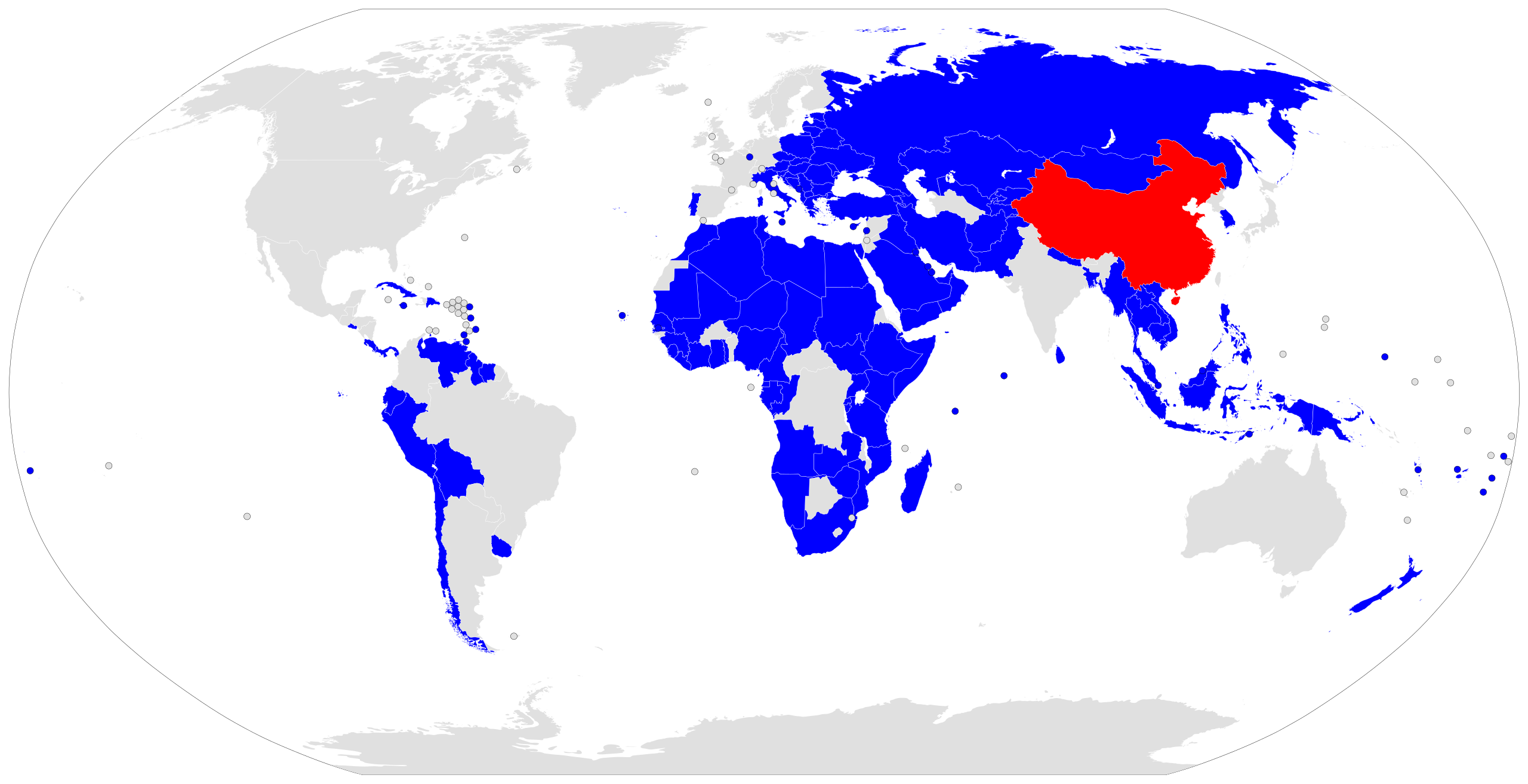
2015 CE (65 AA): FoW, Federation of Watersheds: in idea only, an evidence-based civilization/control SYSTEM ruled by natural law committed to replacing all belief-based SYSTEMs and unsustainable growth/empire-building SYSTEMs with an ecological civilization that works long-term per Nature as choicelessly managed by servants of the planetary life-support system who listen to Nature.
Dark Ages (little or no history recorded for a time)
- Akkadian Dark Age, 42 years, 2154-2196 BCE
- Old Kingdom of Egypt Dark Age, 126 years, 2181 – 2055 BCE
- Middle Kingdom of Egypt Dark Age, 100 years, 1650 BCE – 1550 BCE
- Mycenaean Greek Dark Age, 350 years, 1100 BCE – 750 BCE
- New Kingdom of Egypt Dark Age, 405 years, 1069 BCE – 664 BCE
- Irish Dark Age, 500 years, 200 BCE – 300 CE
- Parthian Dark Age, 84 years, 91 BCE – 57 BCE
- Han Dynasty Dark Age, 361 years, 220 – 581 CE
- Britannia Dark Age, 400 years, 400 – 800 CE
- Roman/European (Early Middle) Dark Age, 500 years, 476 CE – 10th century
- Byzantine Dark Age, 150 years, 630 – late 8th centuries
- Dark Age of Khmer, 432 years, 1431 – 1863 CE
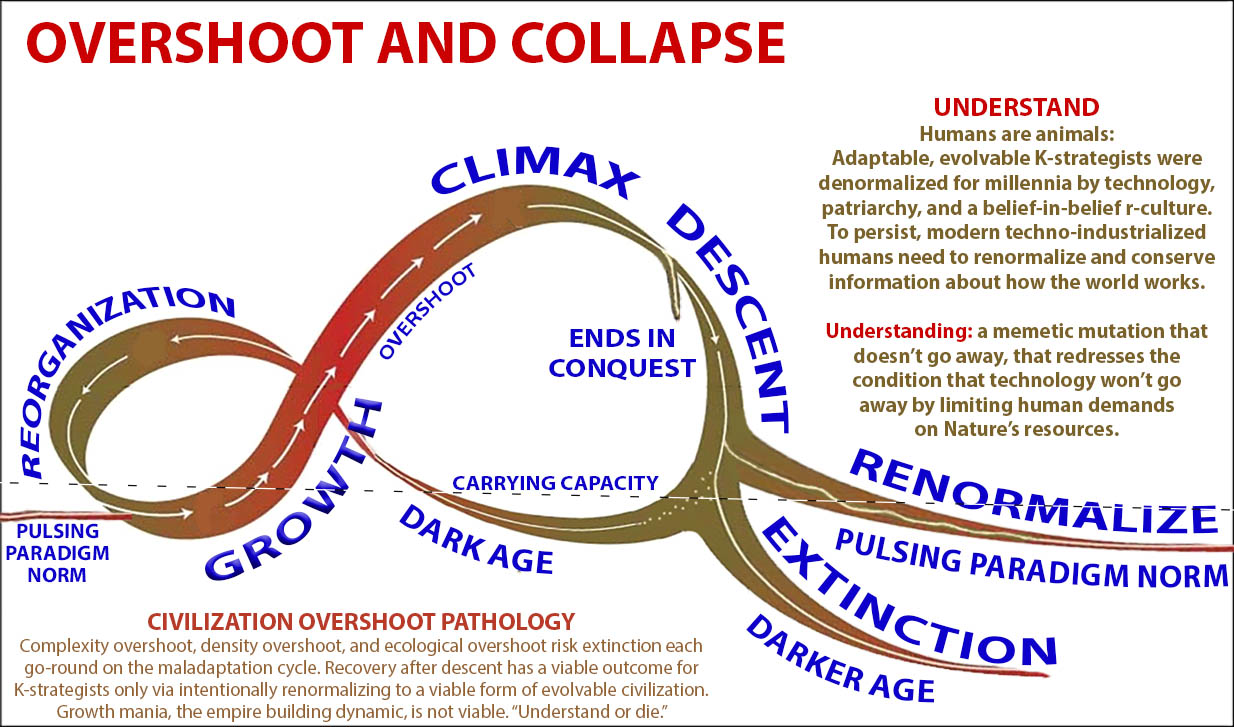
Darker Ages (collapse/descent, no conquest, no history, no recovery. Ending date shown)
- 7370 BCE Göbekli Tepe
- 5700 BCE Çatalhöyük
- 5400 BCE Siberian taiga culture
- 4850 BCE Korean hunter-gatherer culture
- 2300 BCE Sannai Maruyama culture
- 3800 BCE Nebelivka
- 2500 BCE – 2000 BCE Malta
- 2550 BCE Flinders Island
- 2250 BCE Liangzhu culture
- 1900 BCE Bactria–Margiana
- 1800 BCE The Norte Chico civilization
- 1900 BCE – 1300 BCE Indus Valley Civilization
- 1500 BCE Erlitou culture
- 1200 BCE – 900 BCE Sea Peoples Late Bronze Age collapse culture
- 1180 BCE Hittite Empire
- 1100 BCE Minoan civilization
- 612 BCE Neo-Assyrian Empire
- 400 BCE Olmec
- 200 BCE Chavín culture
- 100 BCE Paracas culture
- 600 CE Kilamope and Upano culture west Equador
- 650 CE Lima culture
- 800 CE Nazca culture
- 800 CE Moche
- 900 CE Izapa
- 900 CE Maya civilization (Classic Maya collapse)
- 900 CE Zapotec civilization
- 900 CE Quimbaya
- 1000 CE Tiwanaku (Tiahuanaco) culture
- 1000 CE Wari
- 1125 CE Pueblo at Chaco Canyon
- 1130 CE Mimbres culture (collapse followed by 320 years to self-extinction)
- 1290 CE Pueblo at Mesa Verde
- 1300 CE Cahokia
- 1400 CE Great Zimbabwe
- 1431 CE Angkor civilization of the Khmer Empire
- 1450 CE Norse colony on Greenland
- 1450 CE Original Polynesian civilization on Pitcairn Island and Henderson Island (where after expansionist humans arrived six species of bird went extinct before the humans were transported by UFO to Taihiti—correlation or causation?)
- 1500 CE Pre-Columbian complex societies in Amazonia
- 1500 CE Hohokam
- 1650 CE Rapa Nui
- 1700 CE? Malden Island
- 1760 CE Munhumutapa Empire
Collapse of empire not followed by conquest (often quickly) by an outlaying upstart empire builder has about a 1:5 chance of collapse to a Dark Age with (some) recovery (before repeating the pattern), and an 80% chance of collapse to a Darker Age ending in local extinction. The collapse of the Euro-Sino Empire, the first global empire (quite possibly the last global empire), will not be conquered from without by Klingons, and local extinction will be an on Earth extinction, so if Elon Musk retires on Mars, he and his servants may be the only humans left (but I’m hoping for extinction) or some humans endeavoring to renomalize may manage to persist.
If a marauding horde culture develops during collapse, and the dynamic of the downslope death-spiral lasts 200 to 600 years, any remnant populations of quasi-functional renormalizing humans who somehow manage to persist for 200 years, will be viewed as resources for the taking by our BAU descendants. The remnant population will be so dysfunctional as to fail to reproduce after 8 to 24 generations on the downslope. The Indus Valley Civilization's darker age was the largest collapse event known and most cities were abandoned within 200 years (2023, 57% of global population is in urban areas, 83% of USA population is in urban areas, and if mostly depopulated in two hundred years, not good news for rural populations viewed as resources for the taking). The next will be global and duration of downslope likely to compare to that of the Indus Valley's 600 years on the downslope leading to complete dissolution after 24 generations. Going from over 8 billion to whatever, if any, may take longer, e.g. 1k years or 40 generations. How many generations on the downslope the last literate Harappan lived, failed to pass on their literacy, is unknown (2-3?).
Nature doesn’t care what I believe, so why should I? Data speaks. Listen.
Our entire much-praised technological progress, and civilization generally, could be compared to an ax in the hand of a pathological criminal. —Albert Einstein
References: Mostly copied from Wikipedia, so highlight and right click.
Keep in mind that many small regional "empires" have come and gone in the last 12,000 years without archaeology noting or history naming them, many more than the 133+ named above. Of all the empires, likely all at their height, deeply believed they would be the exception. Per the nature of things, the universe doesn't care what humans believe.
History will be in the mind of future historians. If humans stop committing empire, such as by forming a Federation of Watersheds, perhaps 20,000 in number instead of 200 nation-states, that has a shared mobile military force to prevent the temporarily stronger from invading the weaker (see above), then Federation historians, unlike those of the 18th - 21st centuries, will not endeavor to normalize patriarchy, wealth inequality, acquisitiveness, war, alpha maleness, growth, elite privilege, conspicuous consumption, destruction of planetary commons, genocide, mass extinction, and empire-building, aka buisness-as-usual.
From the hunter-gatherer POV spanning 300,000 years, the recent 8,000 years of empire-building would seem aberrant. If humans transition into a stable and sustainable Federation, living the ecolate life in balance and harmony with Nature, then empire-building will seem aberrant again.
The current empire is the Euro-Sino Empire dominated by commercial interests, which subsumed most nation-states by the mid twentieth century. As the first global empire, there are no other upstarts on the planet to conquer it when it weakens other than empires of belief. Like that of the Indus Valley, the Euro-Sino Empire can only collapse from within. Many empires have ended in conquest or internal revolt, but in all cases their rapid fall was the perhaps merciful "kicking in of a rotten door." The weakening may be from excessive elite demands on distant commoners, excessive demands on environmental carrying capacity, or both. "Excessive" equals the endeavor to grow without limit, for the rich to get richer.
The first empires were empires of belief. When agriculture allowed an area to support many more humans than hunter-gatherers, the agriculturalists, whether plant (Mesopotamia, Indus Valley, et al.) or animal based (Indo-Europeans, Mongol), displaced them, like it or not, to become agrarian empires. The large populations supported armies and those agrarian empires who transition to military empires replace those who do not, like it or not. Empires that spread by use or threat of force develop into city-states—political empires that evolve into nation-states whose development climaxed mid-20th century. All empires have been a mix of power: the power of religious belief, economic power, political power, and military force. The Euro-Sino Empire is a global industrial economic empire in that commercial interests dominate religious, political, and military interests.
The power basis for nomadic hunter-gatherers is a small section of environment within a day's walk. In the late Pleistocene the size of nomadic bands was limiting, so only empires of shared belief could develop in the late Pleistocene whose power base is the believing mind. Agriculturalists are initially small tribes depending on local environment for power also, but agriculture may allow the same area to support ten times the population. Hunter-gatherers in an area that can support agriculture (plant or animal based) that do not choose to become farmers/herders, are displaced (genocide/assimilation). Agriculturally developed areas support settled villages that develop into chiefdoms ruled by the stronger chief. Empires of belief join forces with agrarian empire builders.
Agro-powered empires spread throughout the local area that supports agriculture, the power base. Regional agro-politico-religio-belief empires can support mobile armies and navies to develop into city-nation-state building empires. When the Industrial Revolution began, a new power source for empire-building arose. Initially fossil-fueled growth strengthened the nation-state empire builders, especially the British Empire as that is where the fossil-fueled industrial society arose to spread throughout Europe then shifted to resource richer America as Europe was used up. As America was increasingly used up in the 20th century, growth shifted to India and China, mainly the Sino region that currently uses over half of the remaining coal resources to grow commercial empire at 7% to 10%, unsustainably doubling their consumption every 7 to 10 years. China is currently importing vast amounts of resources much as America did in the 20th century. Africa and Australia are being used up by the Euro-Sino Empire. When the planet is "taken" there is no Planet B, so without more energy and other resources to exploit, the industrial society, now global, will transition to descent as all prior ones have.
The future is constrained by power and vision. If the first global empire collapses, as the Indus one did, environmental resources will slowly accumulate as nature recovers. There will be no fossil fuels, however, to fuel another industrial empire. Environmental restoration will eventually allow for agro-powered empire-building and the pattern of rise and fall can continue. Or not.
Alternative to rise and fall is to acquire an illimitable non-fossil fuel power source. Techno-optimists firmly belief this will happen. If so, humanity will continue to grow and after the Milky Way is used up, our Borg-like descendants will endeavor to consume other galaxies. Or not.
Alternative to becoming Morlock/Borg-like (see above), humans could become Federation-like. The Kogi, who have transitioned into ecolate humans, are alternative. A sustainable Kogi-like life is possible and alternative to the Borg-like growther culture that has dominated human life for five thousand years. The Federation alternative combines the ecolate lives of our pre-empire-building ancestors with technology in studied moderation. The legacy of our overgrowth is the information acquired in the past seven thousand years. Preservation of information and minds able to access it is of highest priority as without it there can be no macroscope. Solar powered IT may be the only high-tech needed or supportable. Without thought there can be no life (sustainable). As Emerson noted, "Things are in the saddle and ride mankind" so far. Alternative is to put a Kogi-like consensus of ecolate thought in the saddle as a naturocracy. The dominant humans in the past five thousand years have acted like a bunch of kids with machetes (imagine giving every kid in an elementary school a machete and all adults leave until the next day—in 24 hours no one would starve, but expect fatalities). Humans might do better to defer to human intelligence as best it can be manifested to set limits by listening to Nature and provide best-guess direction towards a managed commons.
Peter Turchin's Secular Cycles 2009
Modern techno-industrial fossil fueled monetary society different from prior complex agrarian societies, but not foundationally. Complex society is now global, intertwined, and dependent on fossil fuels and agriculture whose productivity is largely dependent on turning fossil fuels into food. All hydroelectric dams were built usig fossil fuels, as are wind turbines, nuclear power plants, and solar PV that add to without replacing fossil fuel dependence.
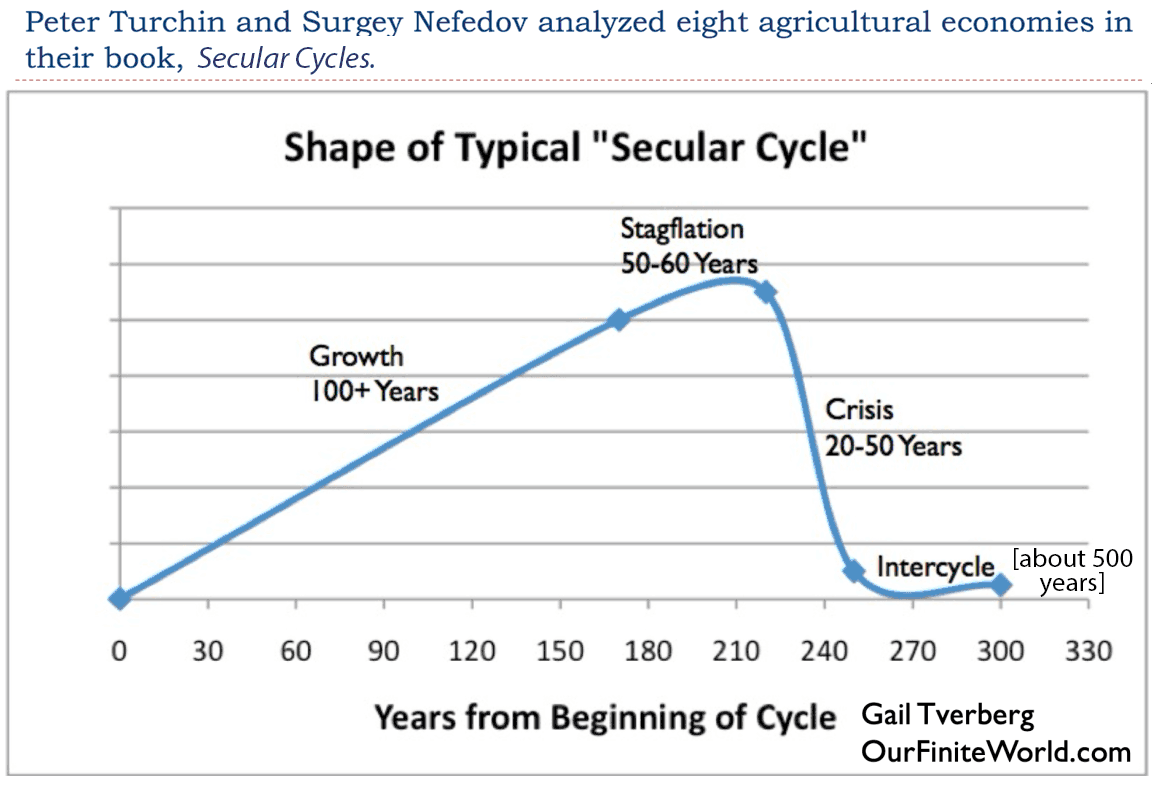
From Alice Friedemann's a more detailed list of the phases derived from the table at the end of Chapter 1 in Secular Cycles:
Expansion Phase (growth)
- Stability and peace leads to prosperity
- Grain reserves are high, so crop failures don’t have much effect
- Wages are high, commoners can rent farmland cheaply
- Cities are small, artisans few, trade level low,
- Prosperity leads to population growth
- The elites exist but there aren’t many and they have a pretty modest lifestyle because peasant wages are so high.
- The number of towns and land farmed grows
- The elites don’t own large amounts of land yet
- The state government is well financed from increasing taxes and ideas about going to war are growing
- The overall outlook is one of optimism
Stagflation phase (compression)
- Population growth continues, but the rate slows down, yet still overpopulation is reached, just as Malthus predicted, and the carrying capacity – the number of people who can occupy the land – is exceeded.
- This problem is “solved” by the excess children without land moving to towns and cities.
- Cities are cesspools of disease and many die, but no problem, there are always excess children from farms to replace them
- Towns and cities grow, craftsmen and trade flourish
- The Elites — the top one to two percent of the population — enter a golden age because they can charge high rents/prices for all of the basic necessities: food, housing, land, etc., and at the same time, pay low wages. No wonder the wealthy elites in America are so pro-immigration and against birth control and abortion. In every civilization that has ever existed, without exception, the elites only grow fabulously wealthy at this point in the cycle when they can pay low wages and charge high rents.
- The amount of land owned by the wealthy is increasing
- Some segments of the elite consume conspicuously.
- Meanwhile the commoners in towns, cities, and on farms are all experiencing decreasing wages and increasing costs of living. Land prices are high. Misery, the homeless, debt, and poverty are increasing. Grain reserves are declining.
- The rich and powerful over-reproduce too, so there are fewer lucrative opportunities for their children
- The rich start to compete with each other. How this happens varies. In some there might be more duels, or more lawsuits. If there are government jobs that are especially lucrative, the competition to get into the best schools and to get the best government jobs grows intense.
- The elites also try to get the government to give them money, to stop taxing them at all or lower their taxes
- Which results in the peasants being taxed even more to make up for the lowered taxes on the rich
- The government and internal order is till okay but starting to unravel, the general outlook grows more pessimistic and critical.
- The government may try to solve these problems by invading nearby countries, or provide more food by building irrigation and roads
- There is often a rise in the rate of crime in this pre-crisis period
Crisis Phase (state breakdown)
- Trade starts to decline due to political unrest
- Cities are at their highest levels of population
- A few large landowners own most of the land. Sounds like now: In America (2013), the top 10 landholders own 2% of the land. In California (1973), just 25 landowners hold 16% of the land.
- Debt is high, the price of food is high, and the grain reserves are gone
- Very high inequality between the rich and poor, subsistence crises increase as food shortages happen more often
- The populace, weakened by malnutrition and hunger, easily succumbs to epidemics (i.e. antibiotic resistant diseases in the future like TB, etc).
- In the country and city, peasants rebel, demand reforms such as land redistribution
- The elites have very high levels of corruption.
- The elites may begin to wage wars against each other
- The population starts to decline
- The government goes bankrupt since no one is paying taxes, and loses control of the army and other institutions
- The government collapses
Depression
- It can take several iterations for an empire to completely fail.
- Within the disintegration, there are also “fathers-and-sons” cycles: war and peace and war. These civil wars consume a state until the survivors and their children are so tired of war that peace and stability finally return. But the grandchildren who never experienced the reality of war start new wars. This cycle tends to happen every 40 to 60 years.
- At the bottom the population is low, there’s lots of free land or cheap land, grain and other food vary in availability and price
- The depression goes on for a long time because social cohesion has been lost and isn’t easily regained, fighting continues, and this is often when outside conquerors invade and conquer
- The rich have gotten their comeuppance and declined from civil wars between themselves and are consuming a lot less, own less land than before, lots of downward mobility with the elite becoming commoners again
- The state keeps trying to reinstate order but usually fails, and this is often when nearby nations invade to take advantage of the collapse
- Trade is local, long-distance networks are broken
- The outlook is very pessimistic
- After enough time, stability and peace come back and the cycle starts all over again.
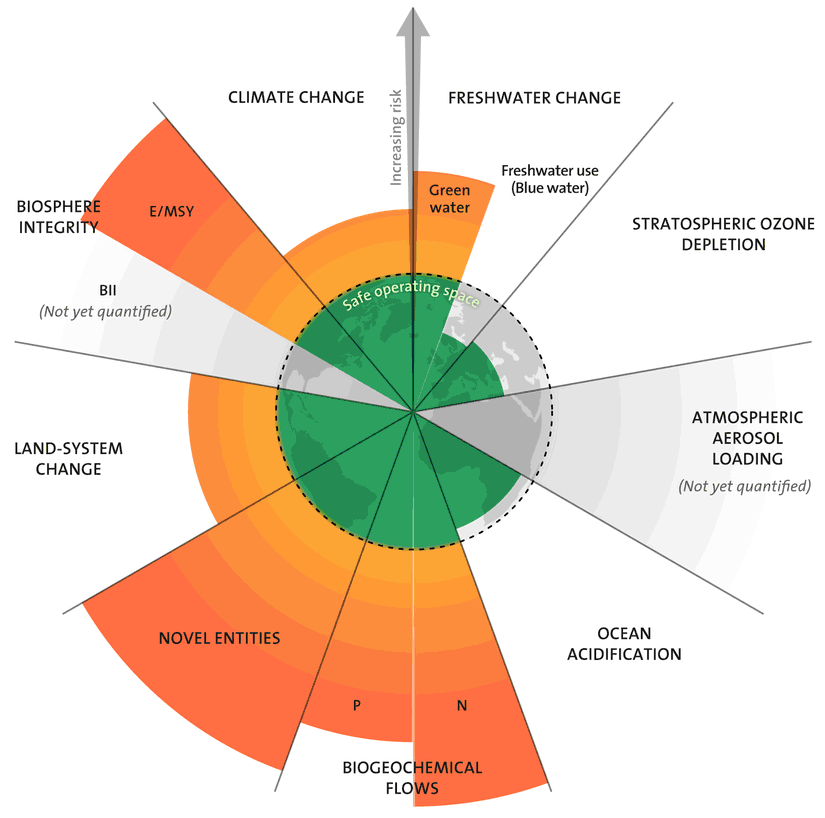
A September 2023 update.
Apparently exceeding carrying capacity is not a planetary limit,
in Rockström's science,
which is why human/livestock populations cannot exceed limits.
Collapse:
The Overpulsing (into overshoot) Paradigm
Existential issues facing humankind today (based on systems ecology, Jared Diamond's list of 12 environmental issues, Calhoun's rats of NIMH, and the list of planetary boundaries):
- Energy longage of demand: Growth.
- Biodiversity loss, mass extinction (Impact).
- Oversized human/livestock/pet/crop populations (Population).
- Overconsumption of planetary life-support system and growing behavioral sink (Affluence).
- Fossil-fueled technology enabled industrial sprawl (Technology). deforestation, overcropping, urban overgrowth.
- Changes set in motion during the Anthropocene (Systemic feedbacks):
- Soil loss secondary to over salinization, soil mining, and erosion rates exceeding soil formation rates.
- Overuse of freshwater resources: construction of dams, levees, jetties; unsustainable use for irrigation and any pumping which lowers a water table.
- Buildup of biotoxins in the environment, including nitrogen and phosphorus as biosphere toxins.
- Over-extraction of animal resources by human predators not living in a state of Nature (36% of mammalian biomass is humans and 60% is livestock).
- Effects of introduced species: human, animal, or plant on native biomes.
- Ocean acidification and plasticization.
- Effects of anthropogenic climate change—politicized, hence a distraction (from other issues of greater concern).

I.e. reduce energy demands such that fossil fuels are irrelevant.
And DEMAND rapid depopulation (a real solution) NOW!
To counter the misinformation that climate change
is the number one problem, I confess to being
disingenuous. I would actually put climate
change
at #7-#10. Written 4/15/19,
so I guess that makes me a
counter-revolutionary.
Listen to Nature.
LISTEN!
Fourth Law of Energetics
Nature selects for [through the process of trial and error] self-organizing, complex, open thermodynamic systems [including complex societies] that persist by maximizing empower [MePP, Odum's version of MPP] within a pulsing paradigm. K-strategists that overpulse to maximize short-term empower, that end up destroying/degrading the system that contains them, are selected against long term. Life on Earth is the outcome. Cancer and empire are short-term pathologies. Not all complex societies build empires. For industrial humans to persist in a viable form, they will have to understand their pathology and seek out the condition now that will come anyway, i.e. live as K-strategists by foundationally different rules of the game (a social contract) that select for behavior that works long term as Nature (who has all the answers) determines. Humans don't get a vote.
- Zeroth Law: If the heat energy of two systems are each in thermal equilibrium with a third one, then they are in thermal equilibrium with each other. (You must play the game.)
- First Law: Heat is. Energy cannot be created or destroyed. (You cannot win.)
- Second Law: Change requires energy to be transformed into heat. "Things fall apart."—W.B. Yeats. (You cannot break even.)
- Third Law: As heat approaches absolute zero, movement approaches zero, but absolute-zero is an imaginary state. You cannot stop movement; you cannot change a system into what it is not. (You cannot get out of the game.)
- Fourth Law: Nature selects for self-organizing, open thermodynamic systems that persist by maximizing empower within a pulsing paradigm. (You cannot pulse sustainably if boundaries/thresholds are transgressed, e.g. cancer and empire building.)
- Fifth Law: In complex open systems an energy hierarchy forms with higher quality energy (of higher Transformity) enabling the complexity via a network of energy feedback loops that maximize empower. (You cannot change just one thing in a complex system.)
- Sixth Law: System pulsing in an energy hierarchy depends on a flow of materials enabled by the quality of energy used in the flow. (You cannot live by energy alone.)
- Seventh Law: In complex monetary societies money flows opposite to real wealth, and its value is counterfeit. (You cannot get richer. You can have enough, but MORE! impoverishes in the long run. To want more than you actually need is a pathology, e.g. an osprey that eats more fish than it needs [to maintain flyable body weight] just because it can without knowing when to stop, or anyone living in modern techno-industrial society. To not know your wants from your needs is true ignorance, is to be a denizen of the consumer society [for a time] as a hu-man of NIMH circling a behavioral sink.)
'The third part of the “blindingly obvious” trilogy is that money acts only as a "claim" on the output of the real (energy) economy. Money has no intrinsic worth, and has value only in terms of the things for which it can be exchanged. No amount of money – be it currency, gold or any other token – would be of any use whatsoever to somebody stranded in the desert, or cast adrift in a lifeboat.' The Surplus Energy Economy 2020.
And all concepts are counterfeit too, for essentially the same reason. They make claims about the What-is, Nature, but are not the 'thing itself' as subsystem of and within multiple hierarchies of 'things' on down to the quantum and up to Cosmos. The voices in our heads, the sounds larynx make, or characters in a long string are at best representations of what matters (and energizes). Virtually all human prattle is delusional as the primates emitting it think their verbal behavior means something (intrinsically), i.e. is not counterfeit like their money which clothed apes also pretend matters. We storytelling animals deeply believe our thoughts and words (and money) have intrinsic worth.
We (or someone) may experience a 'sense of wonder' or 'enlightenment' and then turn it into a concept having, absolutely for sure, 'intrinsic value' as we, Lord Man, decree (or imagine some higher power has bestowed the 'intrinsic value'). Humans have constructed the palatial worlds they live in (as "the hollow men" in death's dream kingdom) by incessant concept mongering, elevated to such heights as wordsmithery can dissemble, but all beliefs, all consensus narratives are counterfeit and we would-be emperors have no clothes. We no more 'know' what matters, the What-is, than a dog can know calculus. Hu-mans need to stand down to persist, or when we are taken down, to know humilitas and remain in our place as evolvable subsystems of Gaia (instead of overpulsing, for a time, as dissipative structures operating far from thermodynamic equilibrium).
Most modern humans alive today are the last of 15,000 generations spanning the last 375k years. We alive today are 6.5% of all humans (123 billion) who have ever lived. We live in 0.02% of the time humans have been living on Earth. We do not live in normal times, nor are we normal humans. On our watch, we are presiding over the greatest mass extinction event since the late Cretaceous, one that could come to rival that of the Permian (we could become part of it). Perhaps coming to love and understand the planet and learning to live with it properly is to consider. A Great Selection is in the offing.



